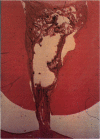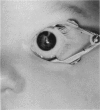Abstract
While the great majority of patients with persistent hyperplastic primary vitreous never obtain useful vision, it is encouraging that 18.07% of all the patients in this series did achieve 20/200 vision or better (Table V). In the whole group, 12 of 83, or 14.45%, obtained 20/70 vision or better with treatment. All of these successful results were in eyes with the purely anterior PHPV only. In fact, when looking at the results of the anterior PHPV cases alone, 15 of 21 achieved 20/200 or better, which was 71.4% of the patients with anterior presentation only. In this anterior group, 12 of 21 (57.1%) attained 20/70 vision or better with treatment. The goals of treatment with PHPV should always be kept in mind when confronted with an infant who has this entity. First, an effort should be made to save the eye from glaucoma or phthisis, which are the most devastating results of untreated PHPV. A lensectomy will usually prevent the secondary glaucoma, which results from the lens-iris diaphragm being pushed forward to cause a secondary angle-closure glaucoma. A secondary glaucoma can also be produced from recurrent hyphema, which scars the outflow passageways in the angle. By removing the PHPV membrane and reducing the tractional forces applied to the ciliary body by the membrane, one can lessen the possibility of phthisis. Surgery reduces the centripetal, as well as axial, forces generated by the membrane. The second goal is to produce a black pupil for cosmetic reasons, and the third goal of obtaining useful vision is reasonable to expect if the entity presents with only anterior involvement. Bilaterality, while rare in this series (2:83 cases, or 2.4%), was a very poor prognosis for vision, since both patients had only light perception to hand motion vision in both eyes. With the exception of the eye problems, these two children were otherwise normal in their physical and mental development. No measurable stereopsis or binocularity has been achieved in any of these patients. This was primarily because 100% of the patients had strabismus and secondarily to the fact that in the patients with good surgical results, aggressive and prolonged patching may have precluded the development of binocular vision. Two patients have uncontrolled glaucoma with only light perception vision. Both of these patients are comfortable and pain-free. Two patients have, in time, developed phthisis and wear a cosmetic shell. No cases have required enucleation in this series. (The pathological specimen from Figs 1 and 2 represents an enucleated eye during my residency.) Two patients developed an extensive cyclitic membrane after surgery, which completely occluded the pupillary space. Both patients had originally undergone extensive membrane removal of their PHPV with the production of a nice clear pupillary space. The first patient developed the cyclitic membrane only 3 weeks after the original surgery. A second surgery has been successful in clearing the pupillary opening, but the patient has only hand motion vision at 1 foot due to amblyopia. The second patient had been fitted with a gas-permeable hard contact lens after original surgery for an anterior PHPV. An extensive cyclitic membrane developed 4 months later and required a secondary procedure to clear the pupillary space. The patient's pupillary space has remained open after this second procedure, and the patient is currently wearing a contact lens and undergoing amblyopia therapy. The most important factor in the prognosis of patients with persistent hyperplastic primary vitreous is the extent of the membrane. Families should be told that if their child has only an anterior presentation, then surgical and amblyopia therapies offer a good chance for useful vision. Patients with a combination of anterior and posterior PHPV, or patients with only a posterior PHPV, should be advised that there is a reasonable opportunity to save the eye from glaucoma and phthisis, but that useful vision is usually not
Full text
PDF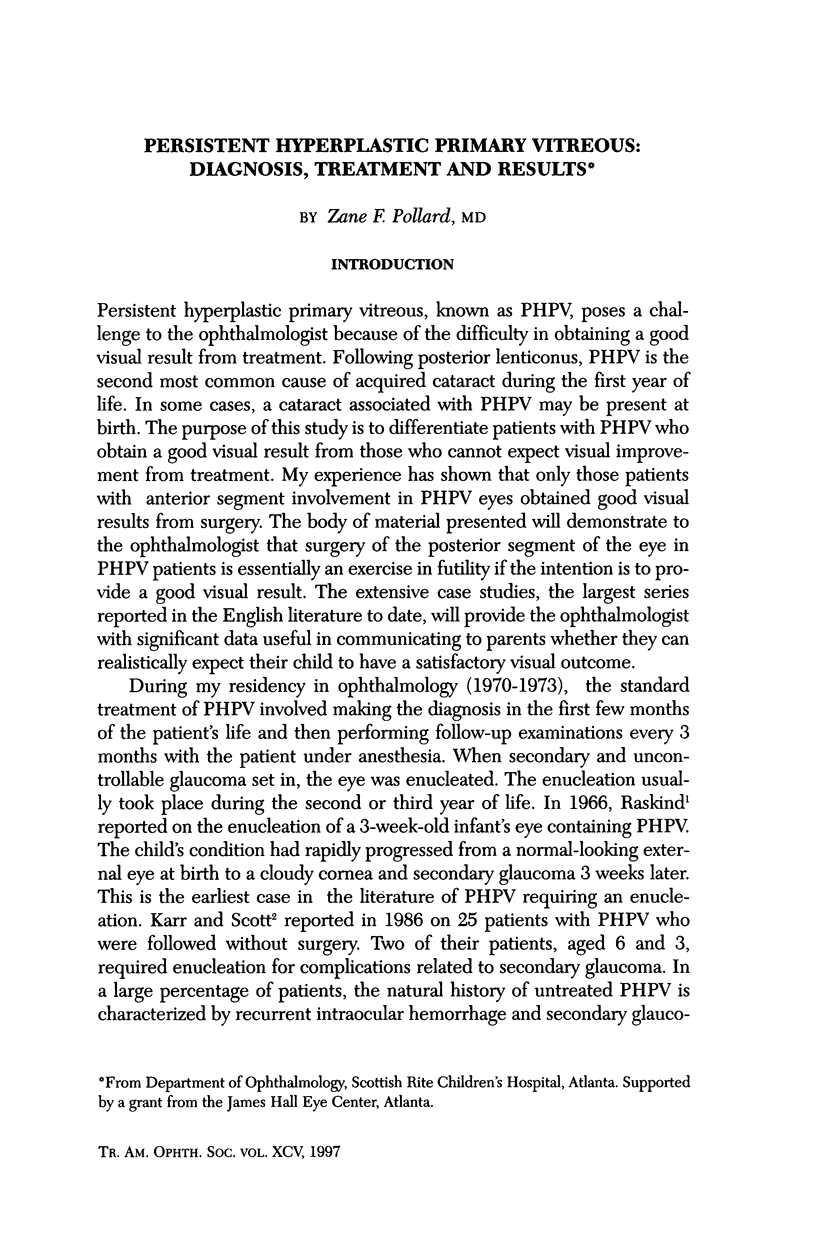
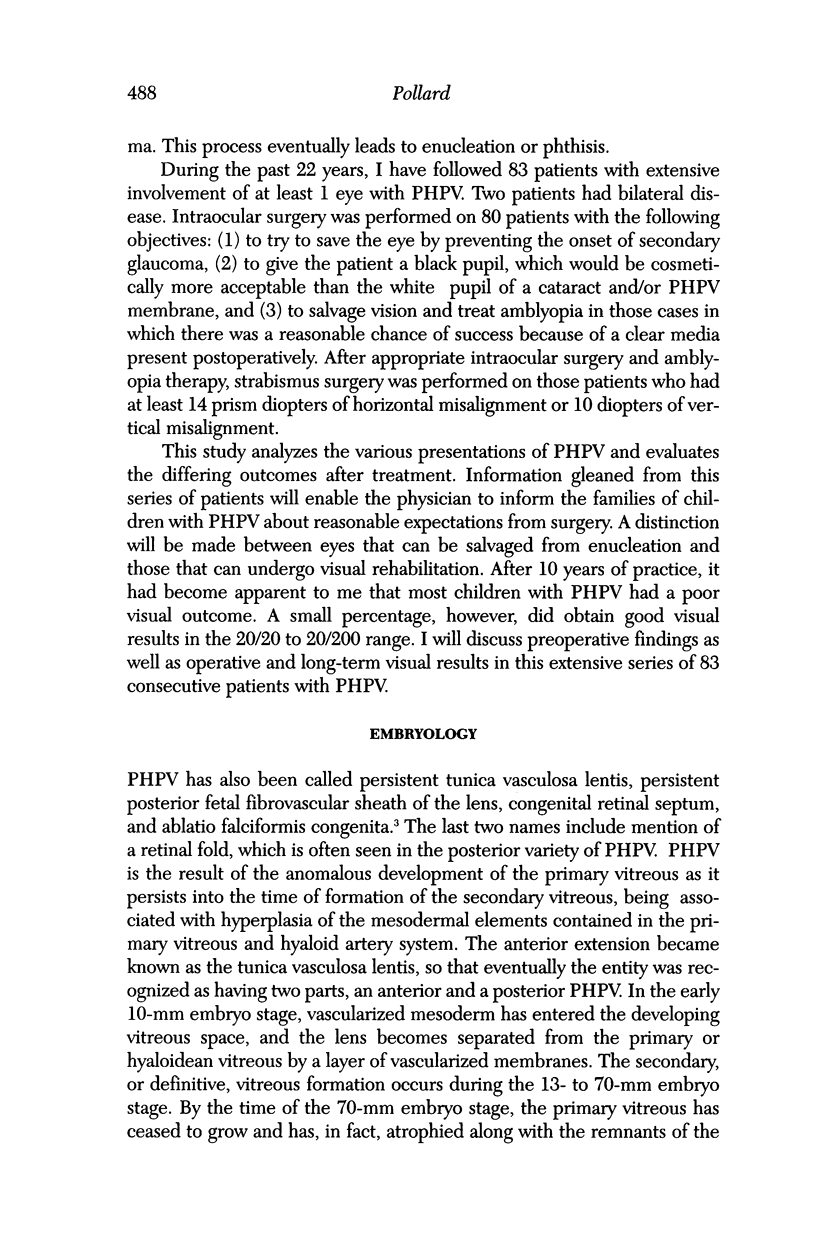
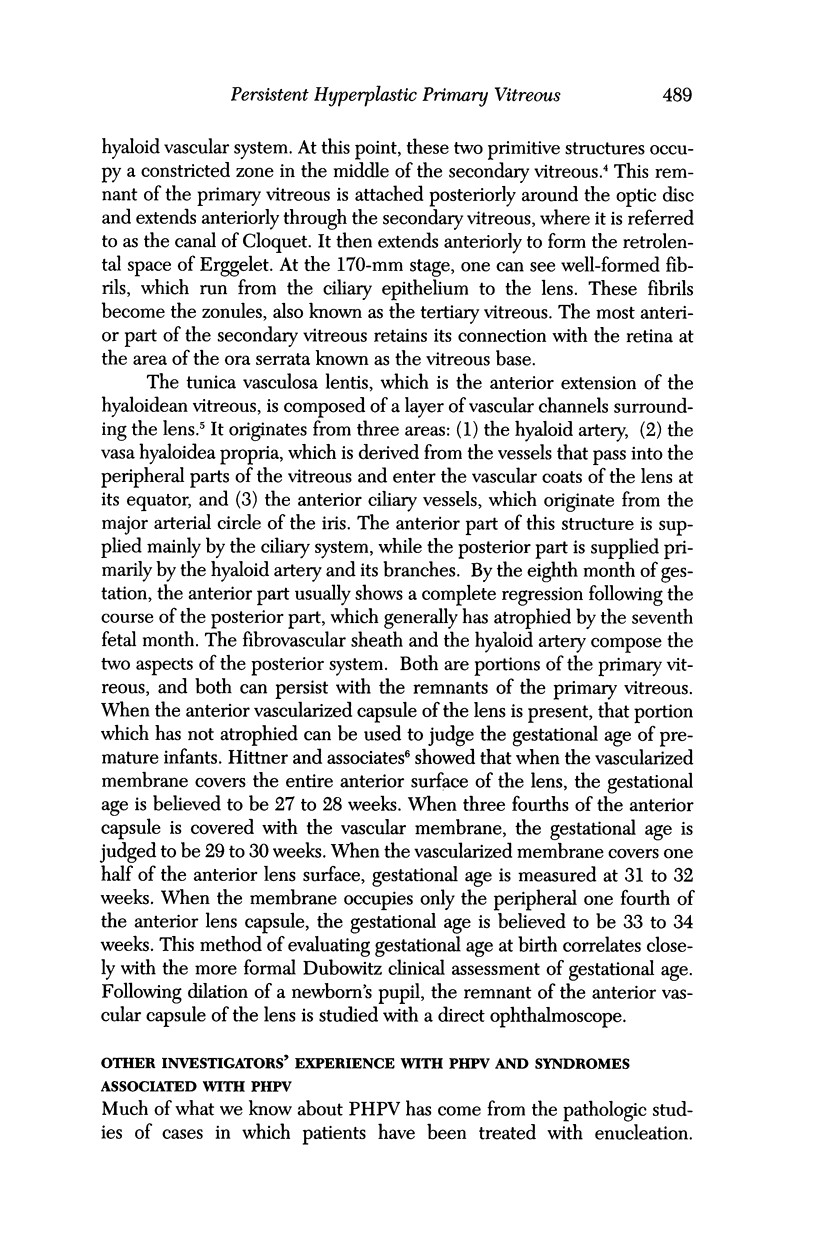
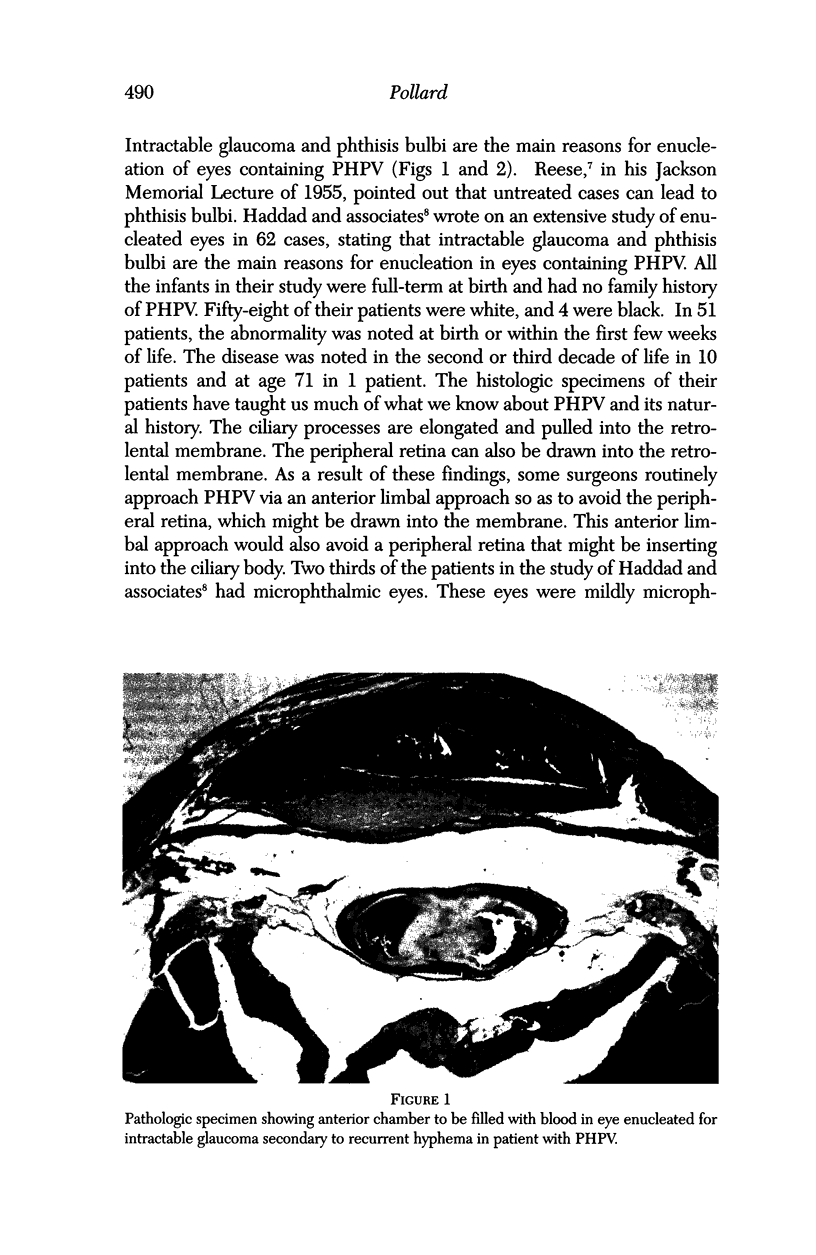
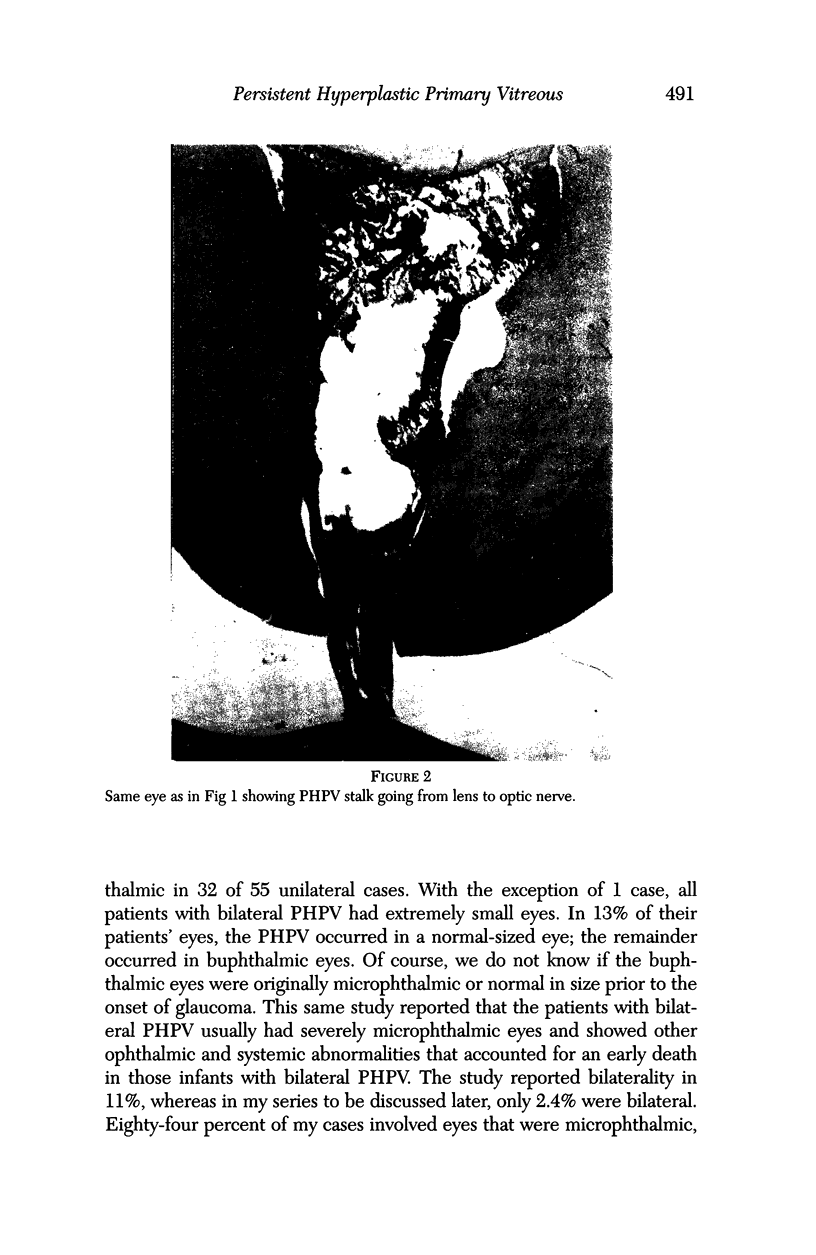
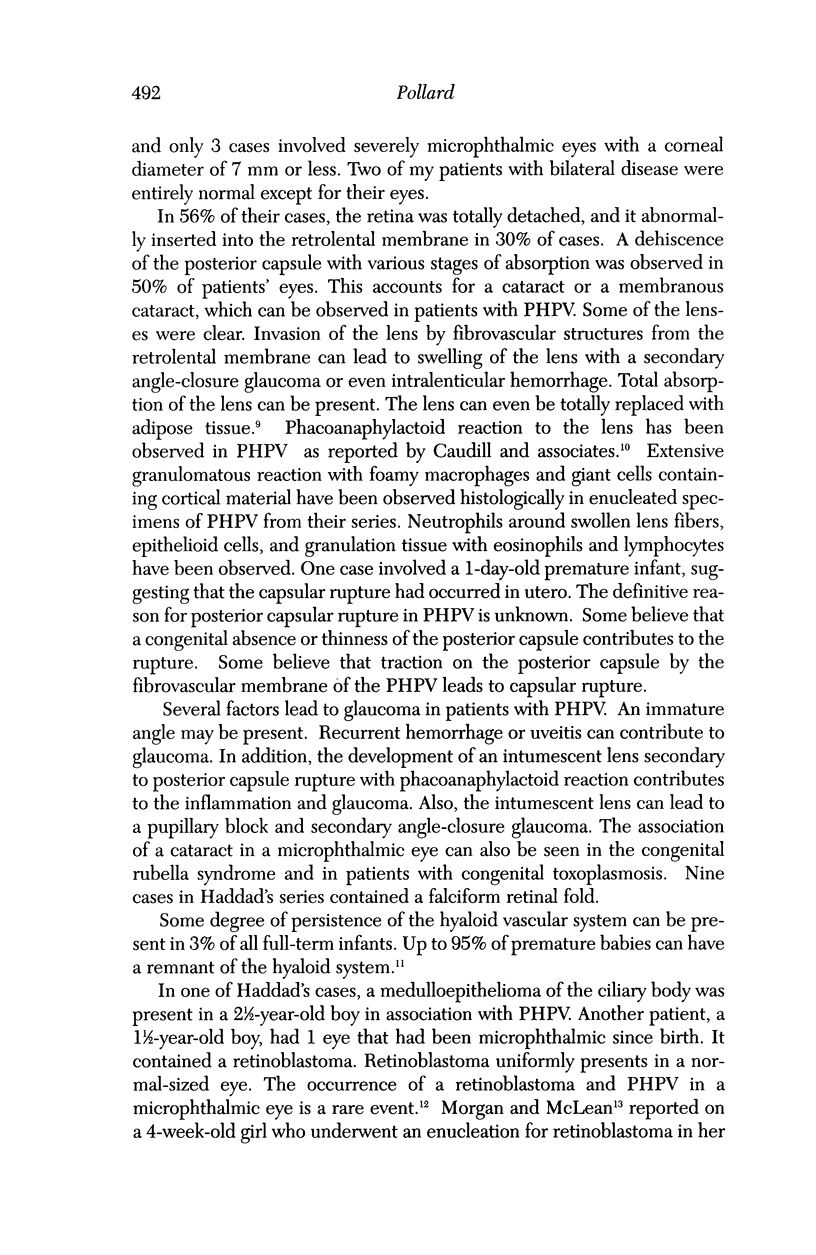
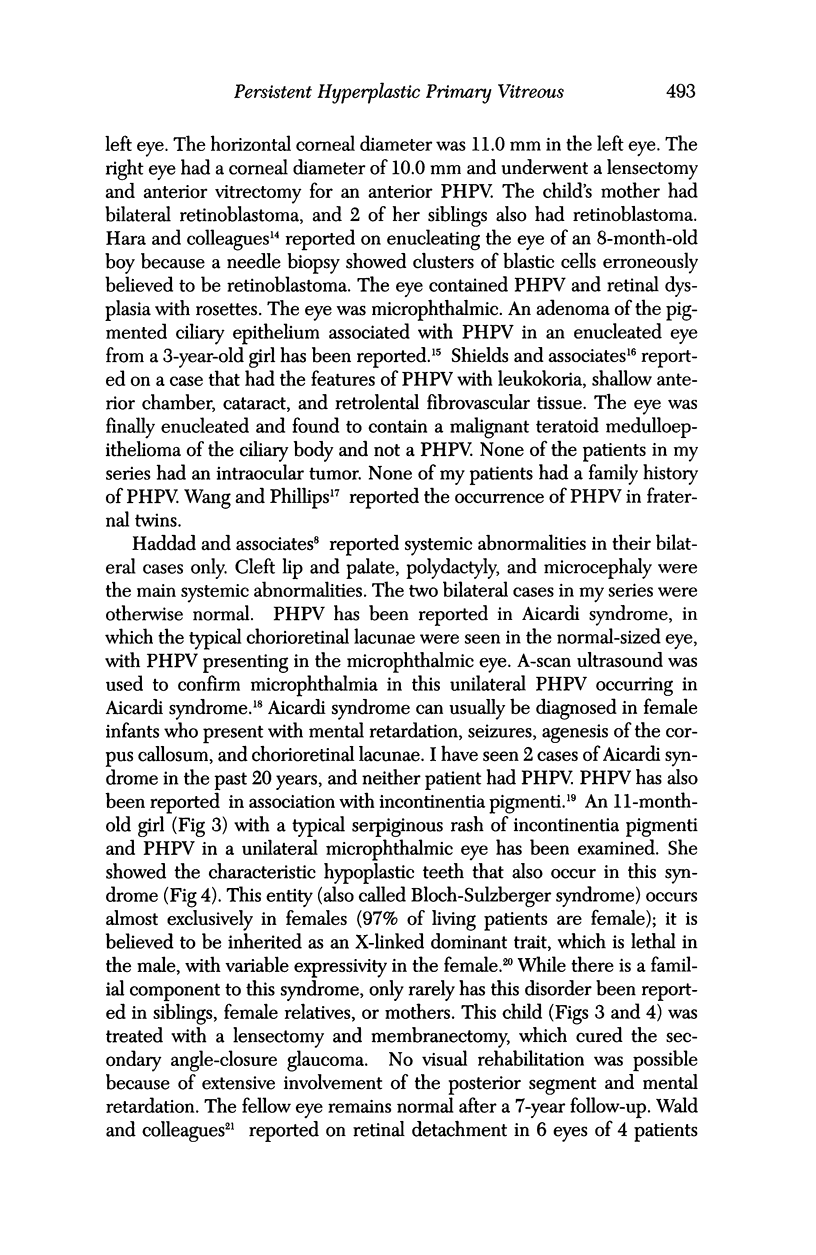
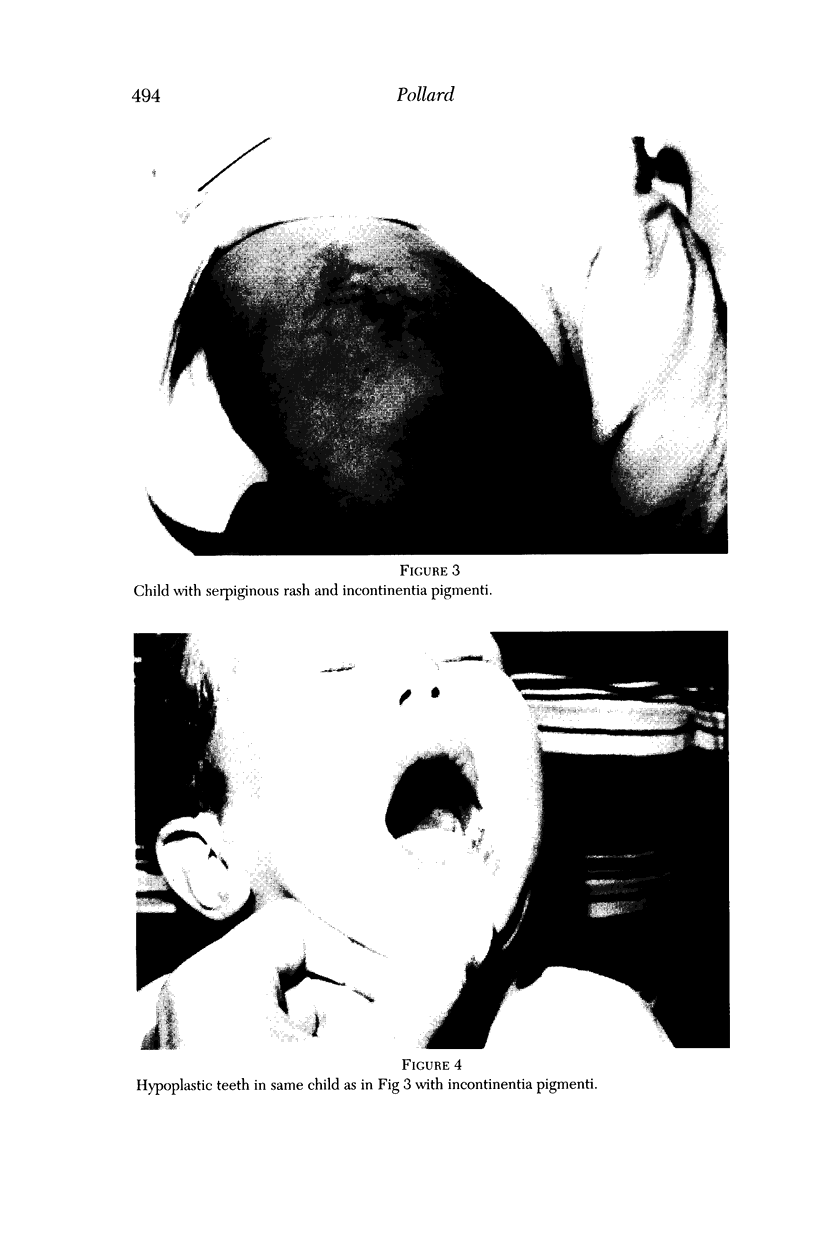
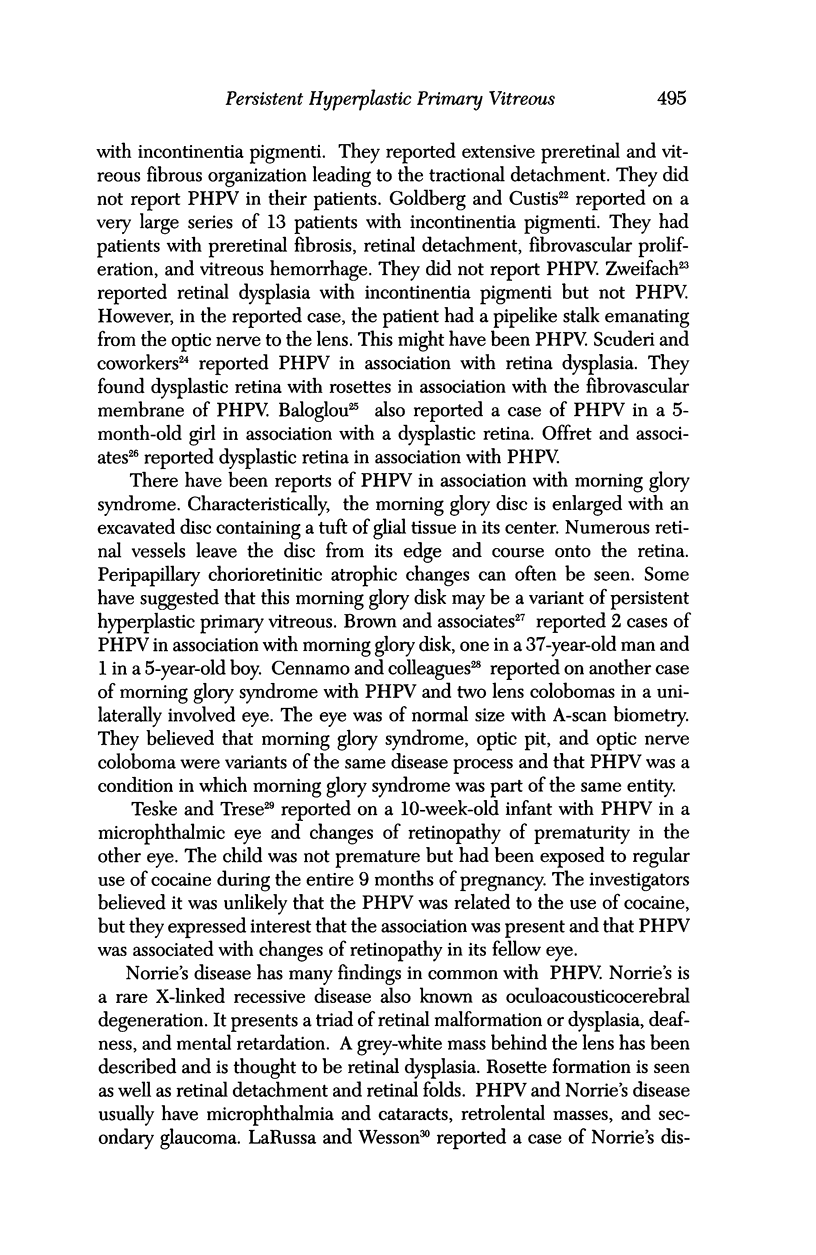
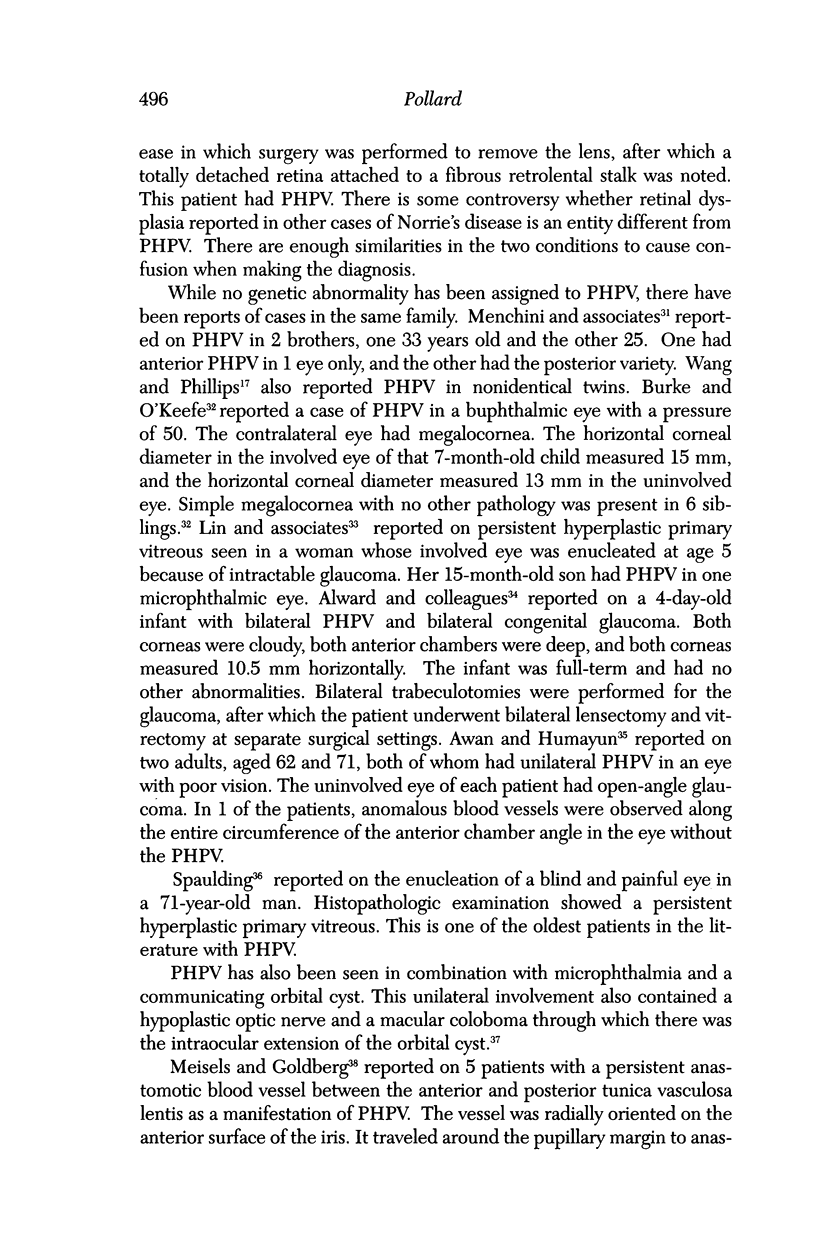
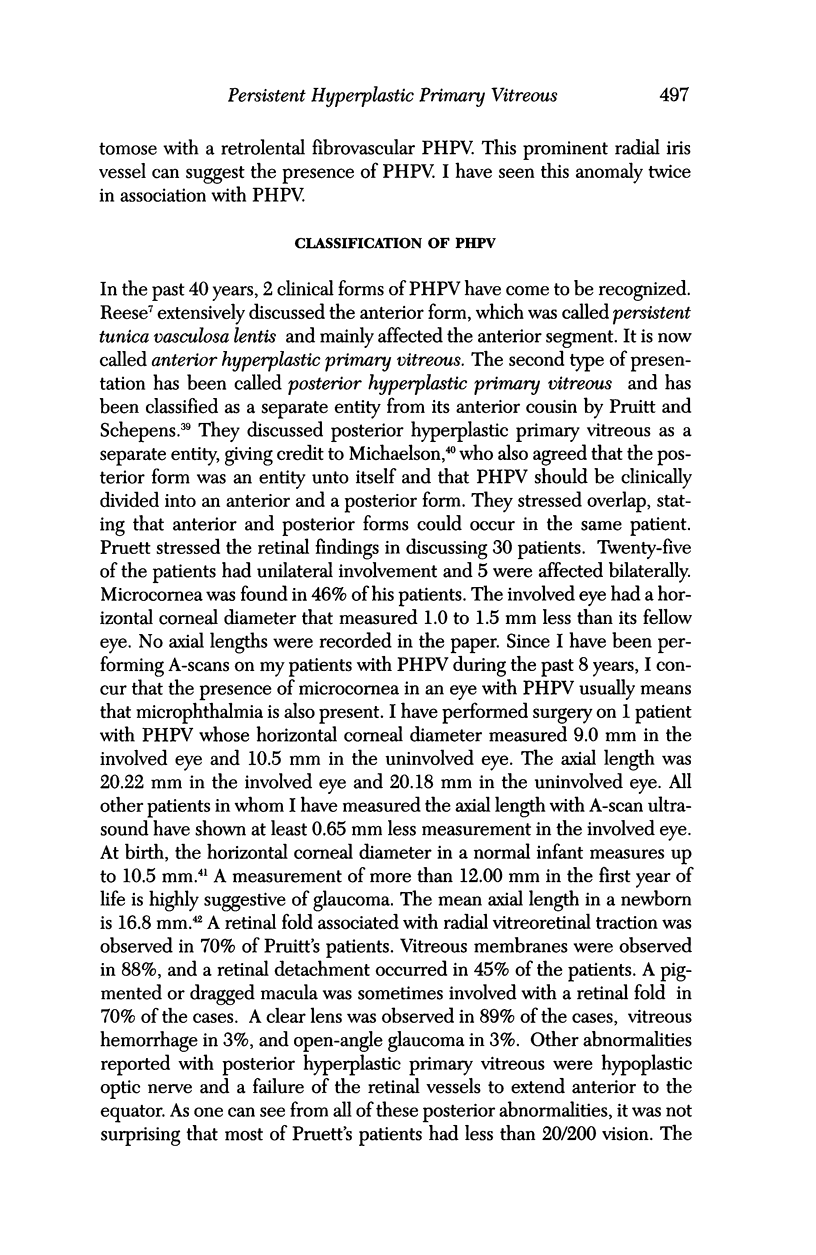
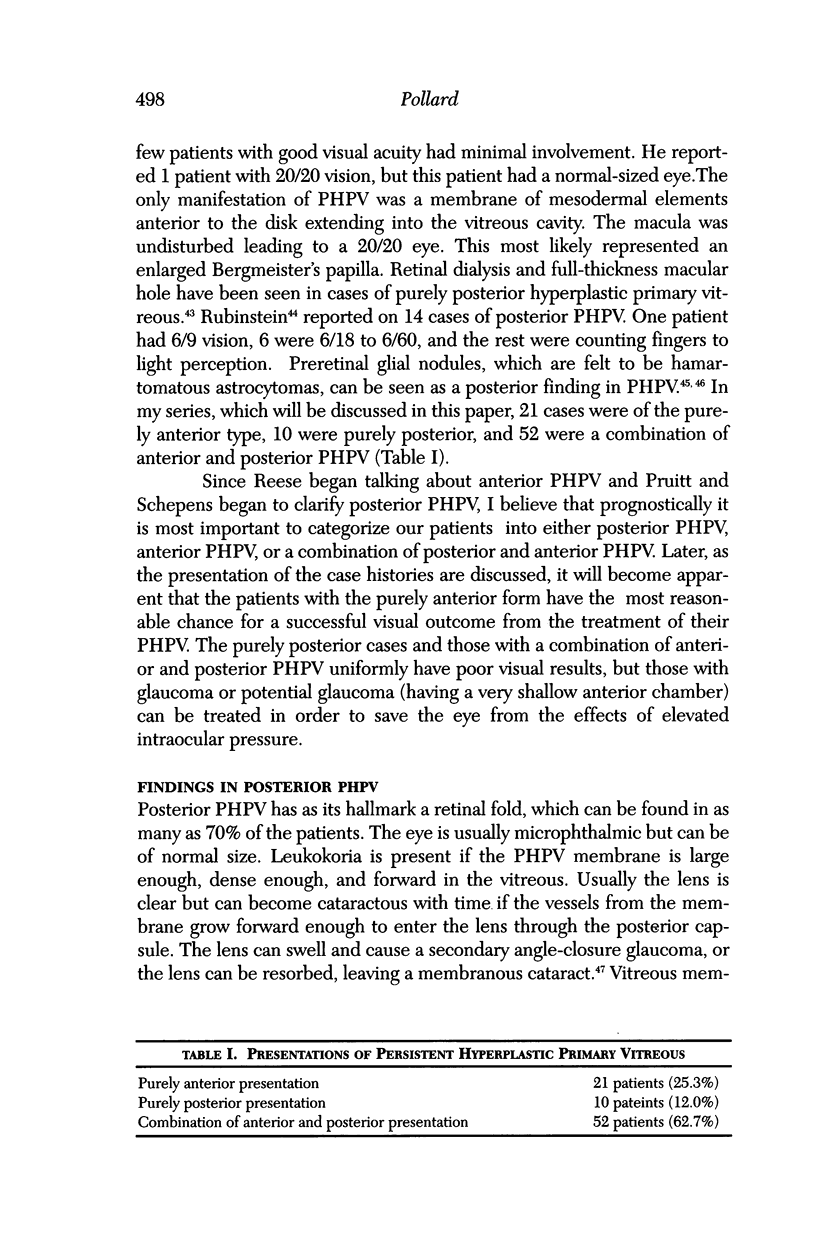
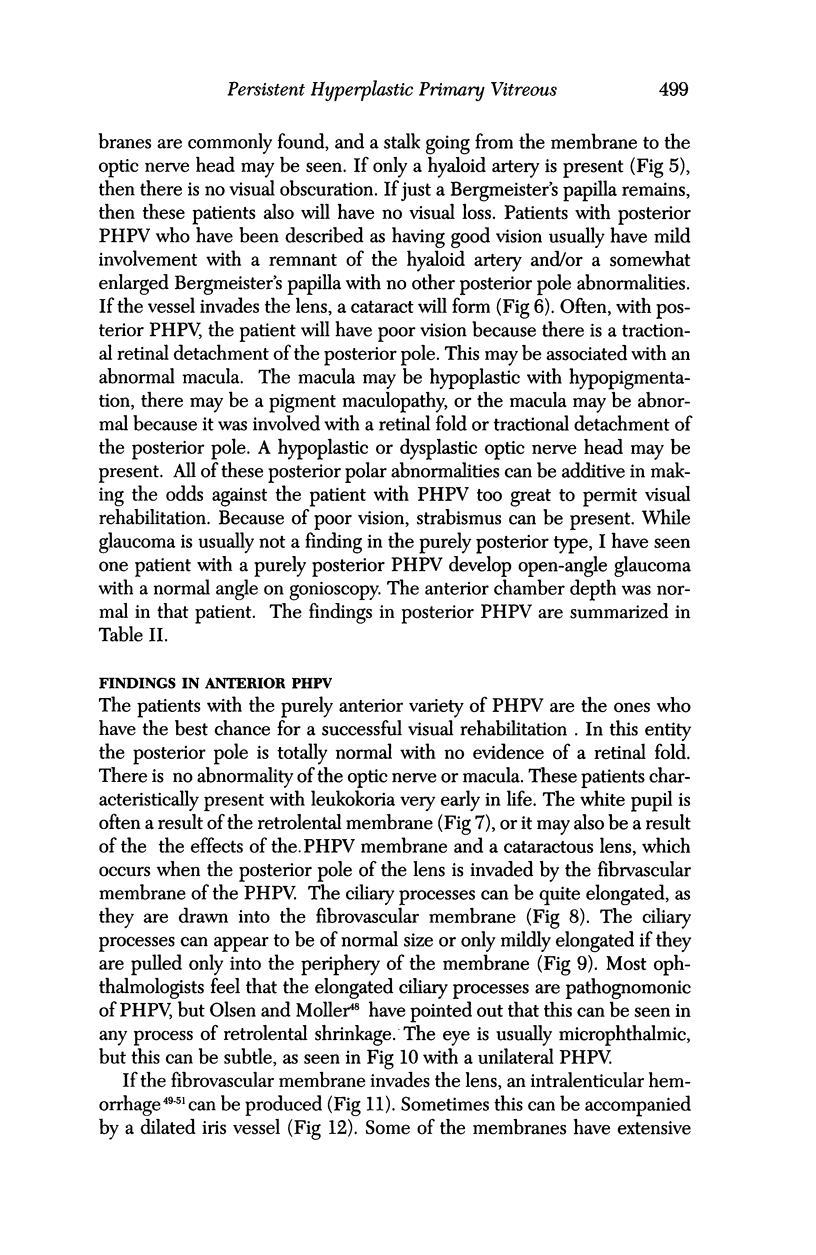
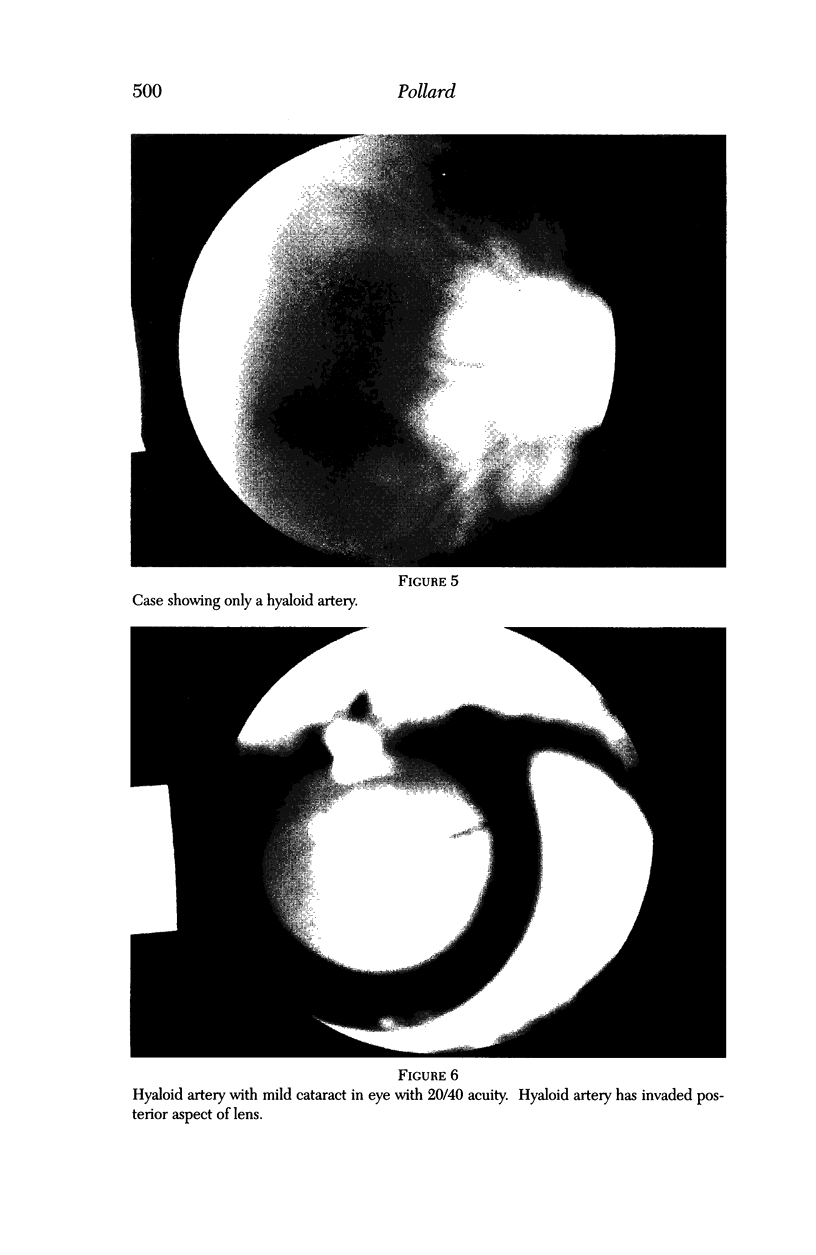
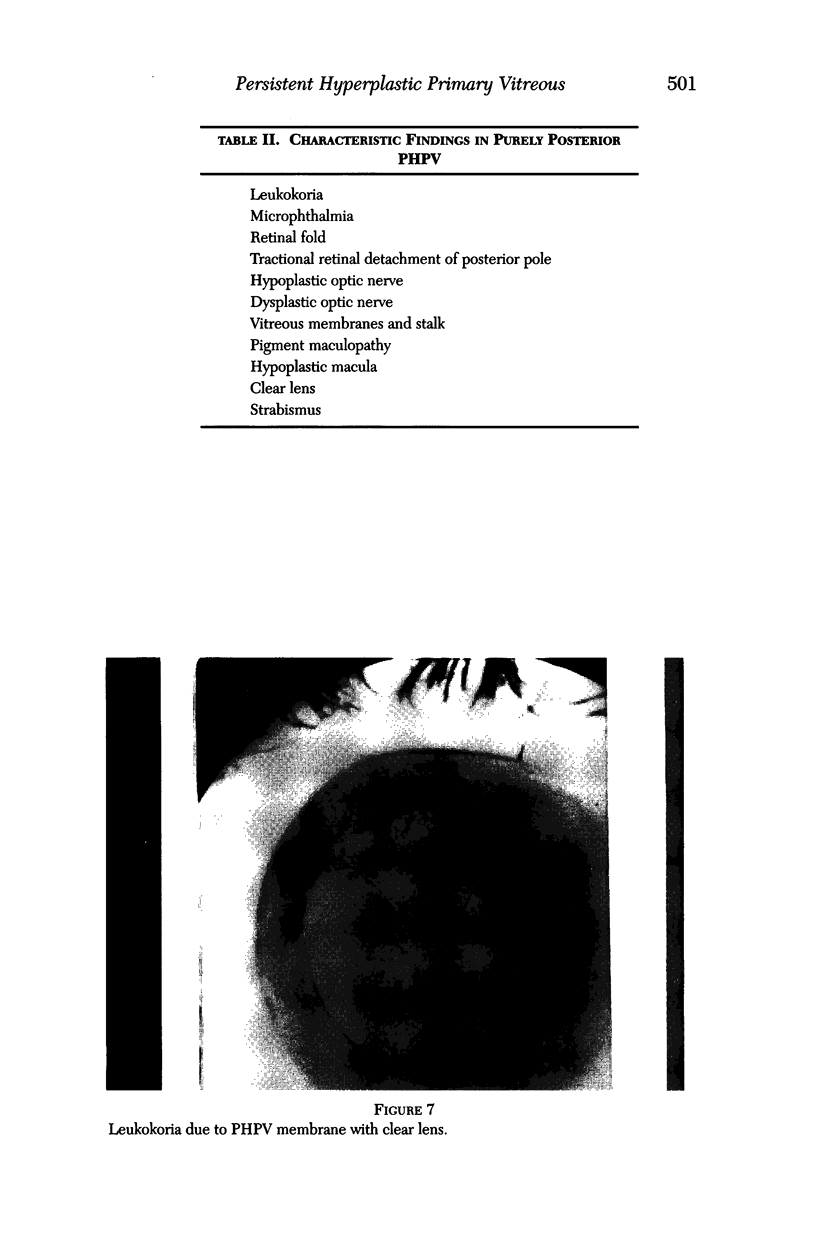
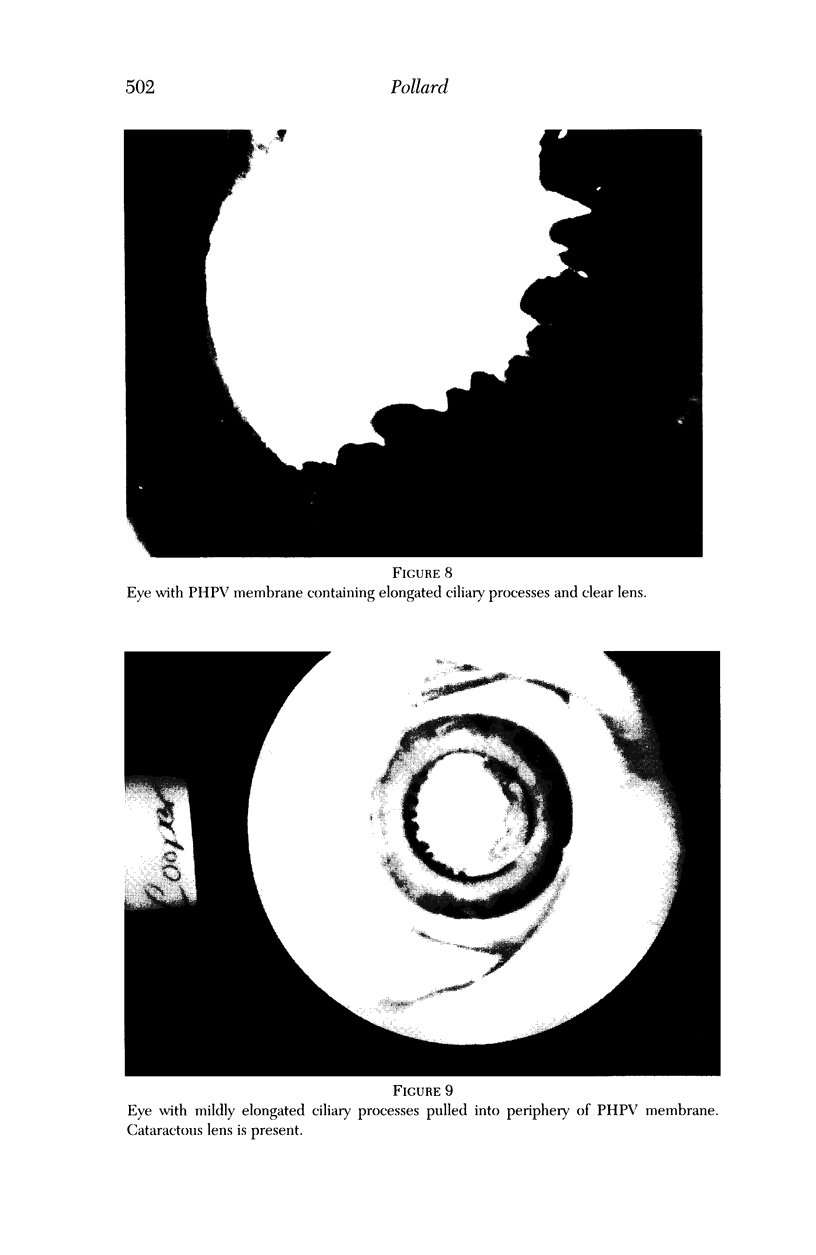
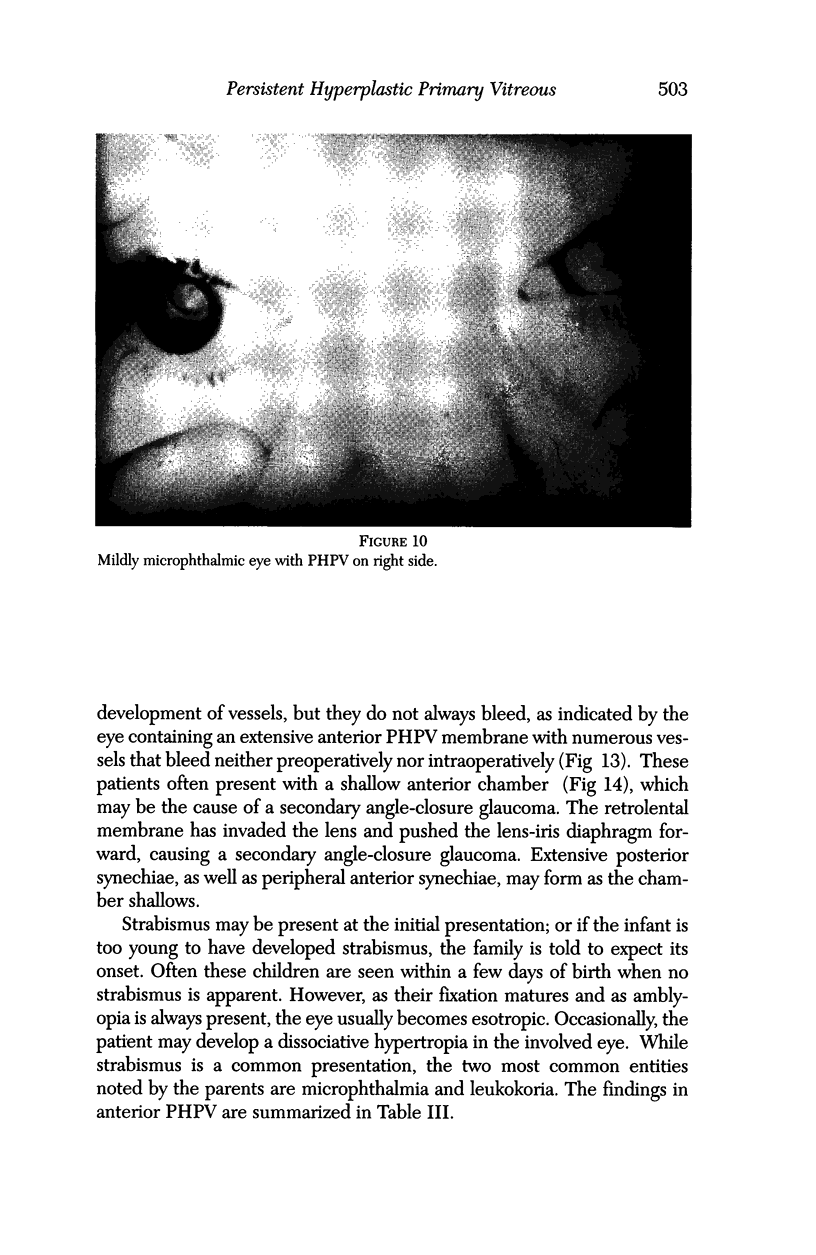
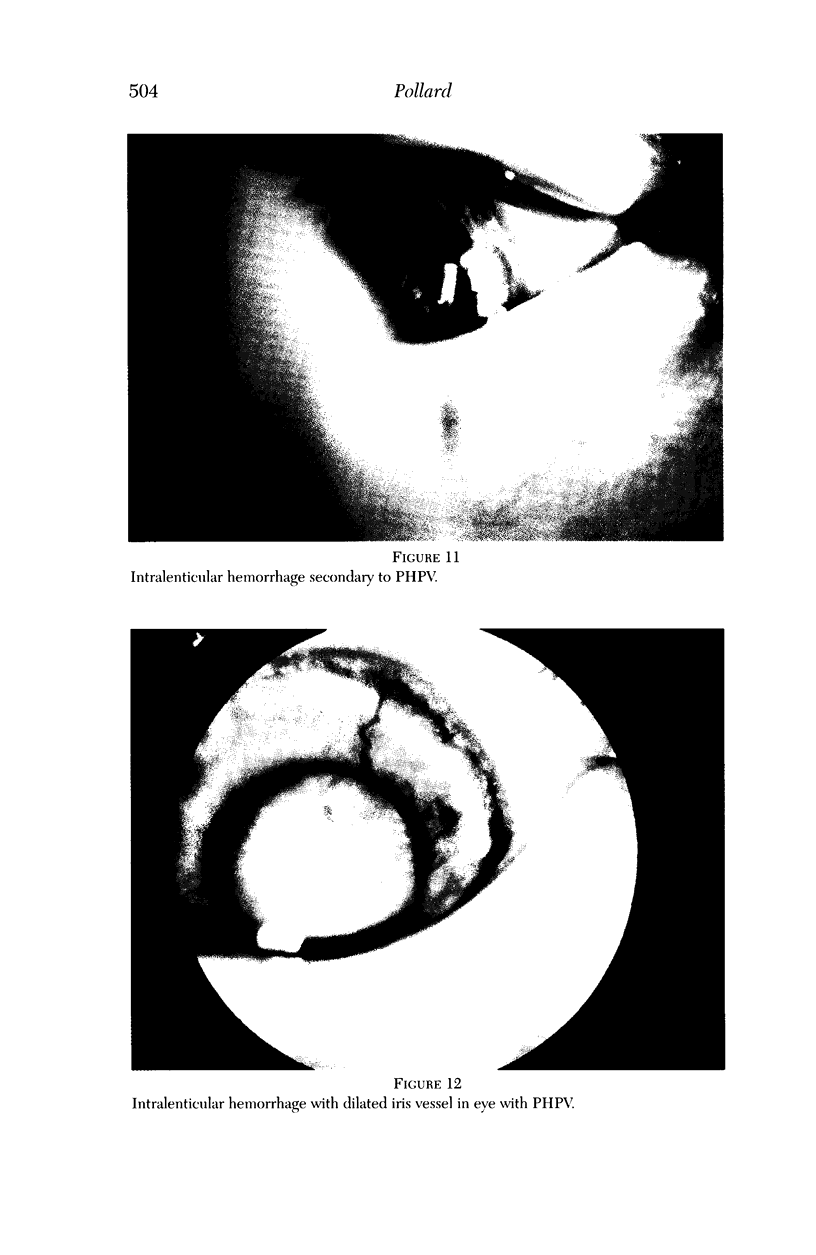
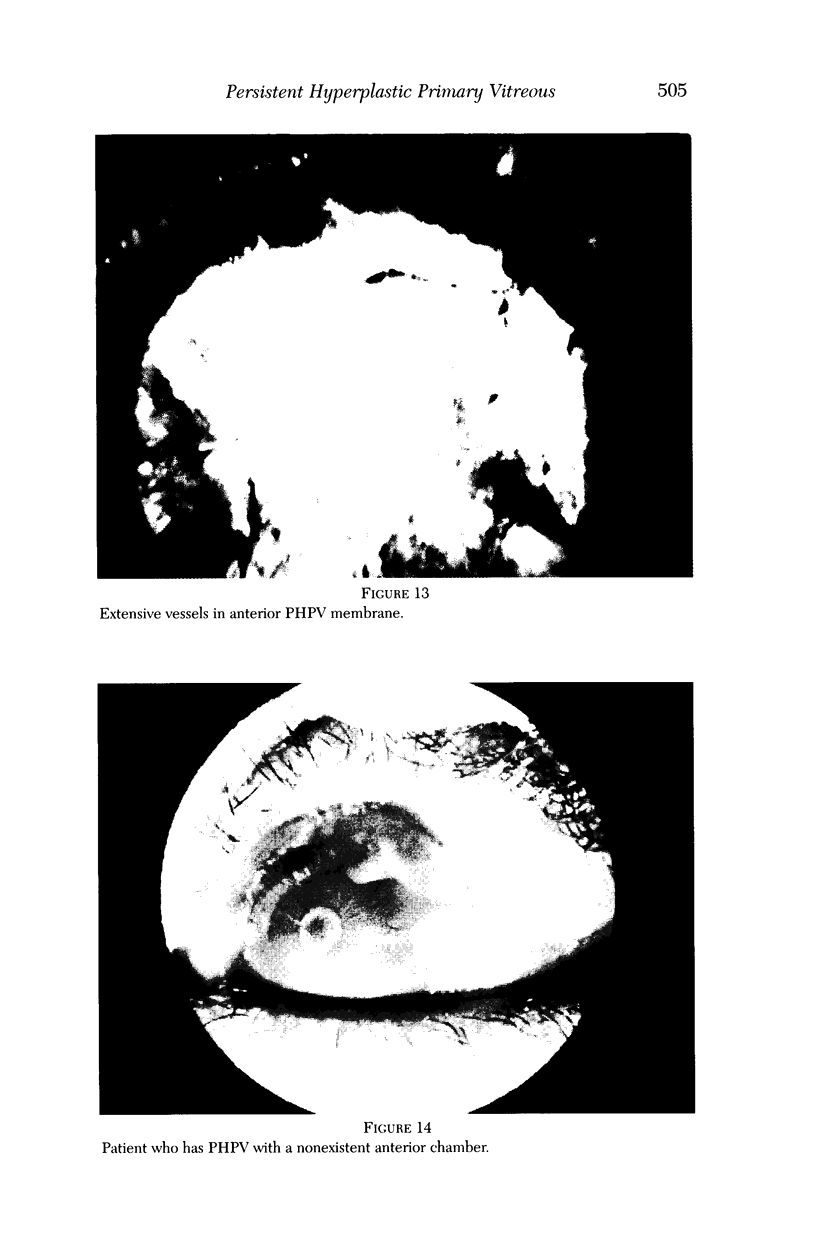
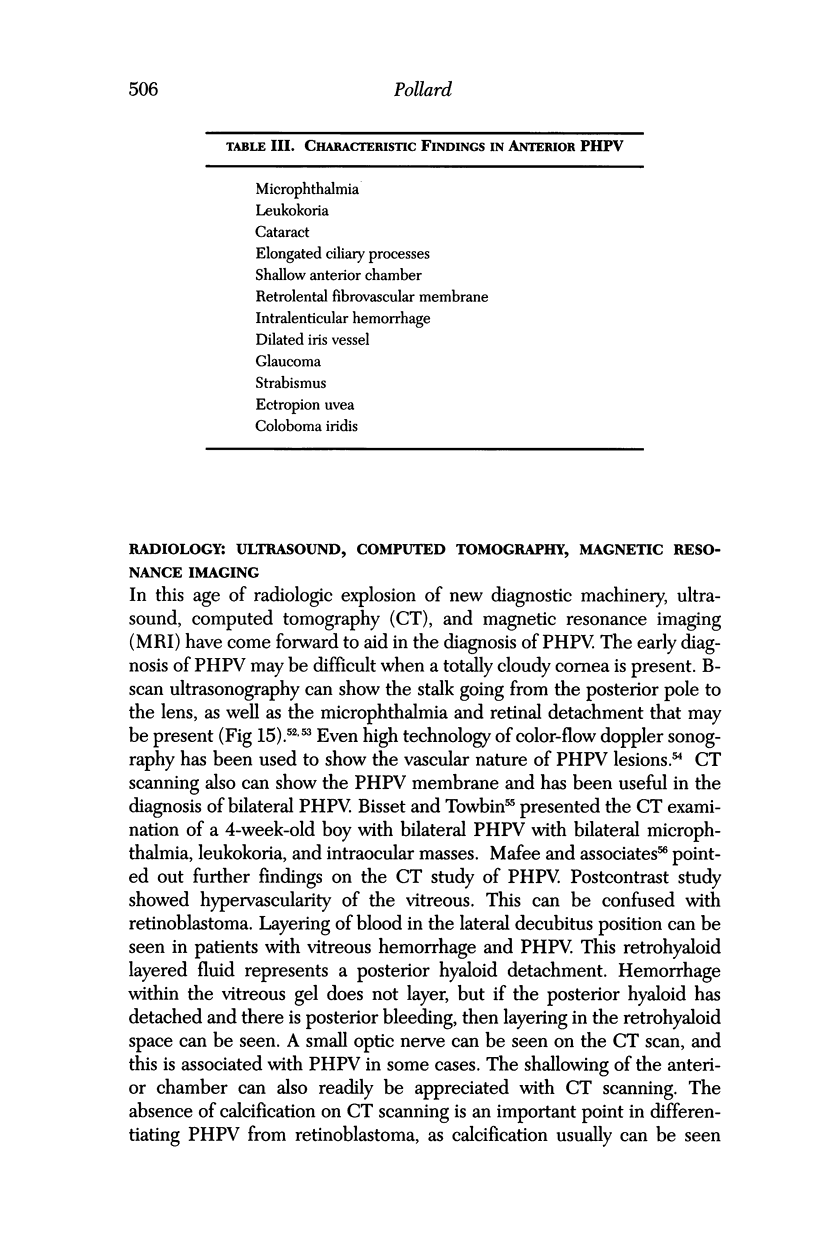
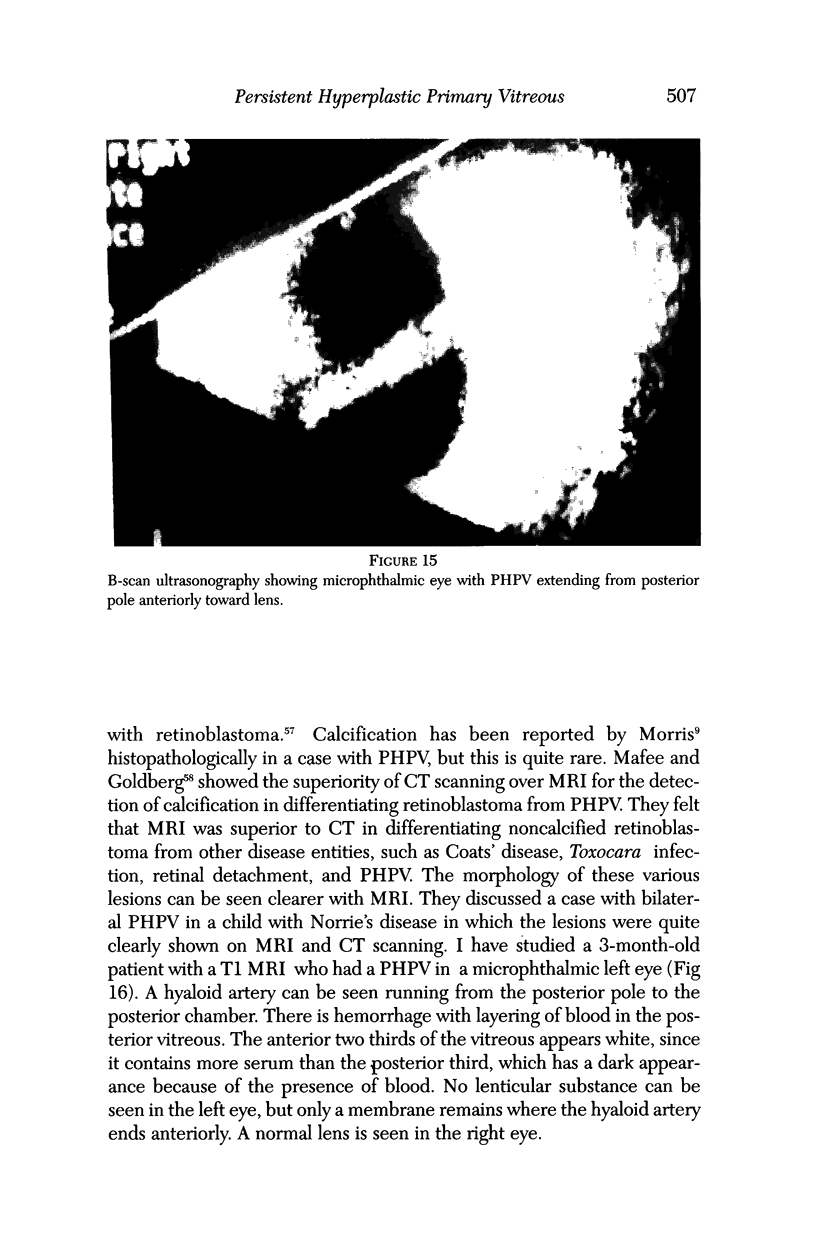
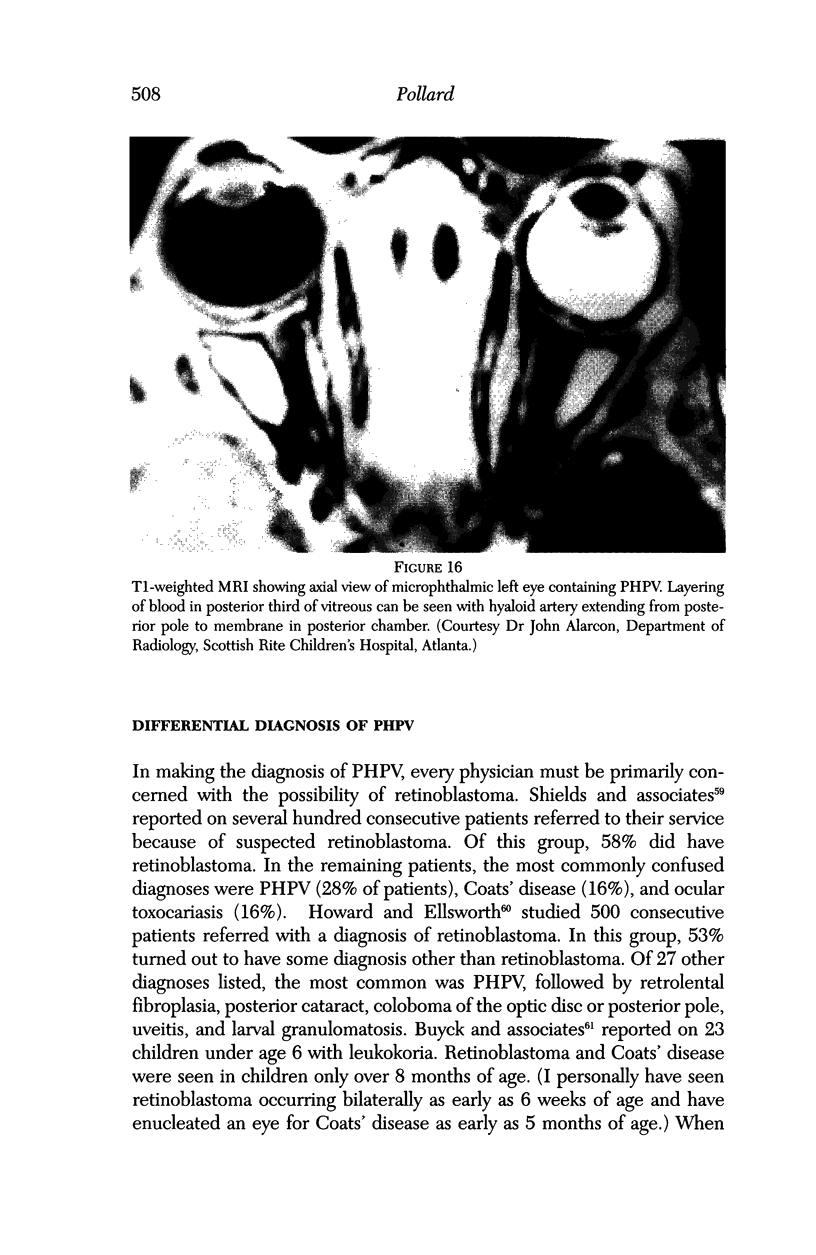
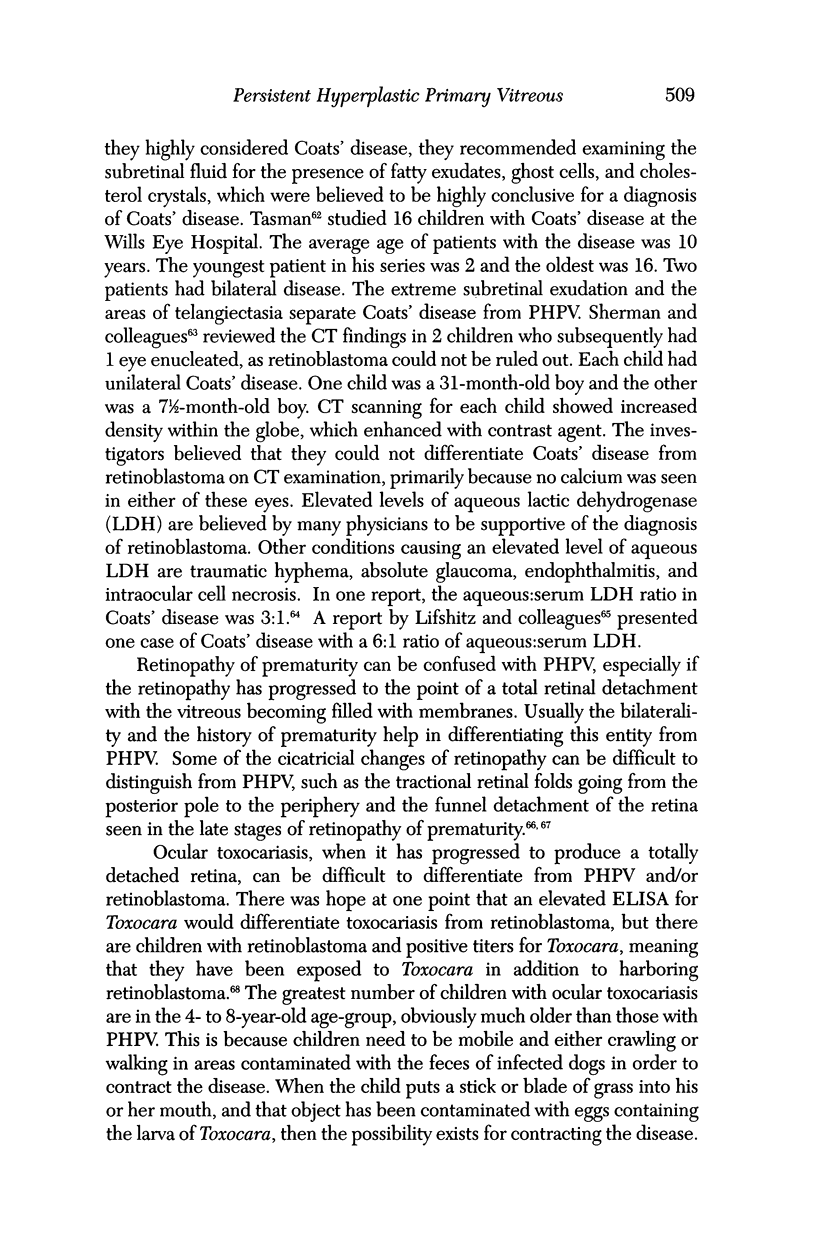
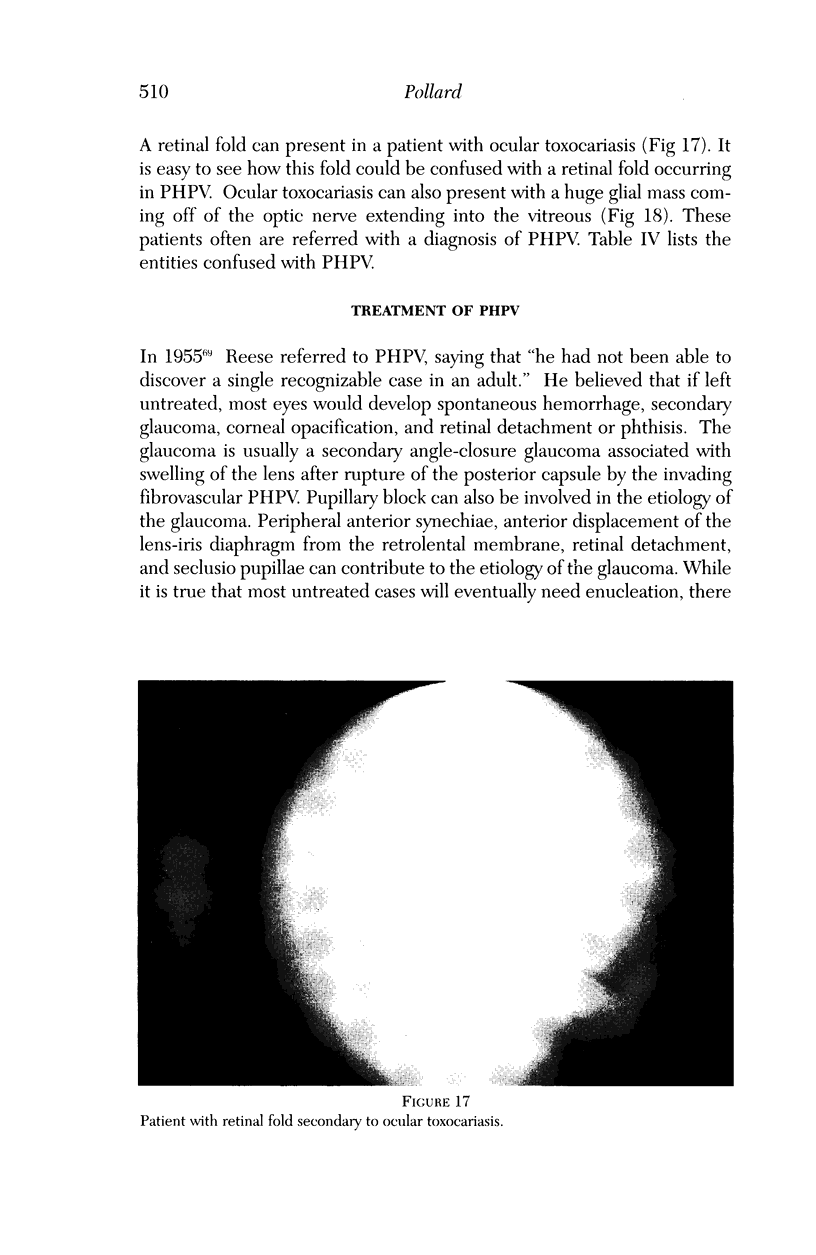
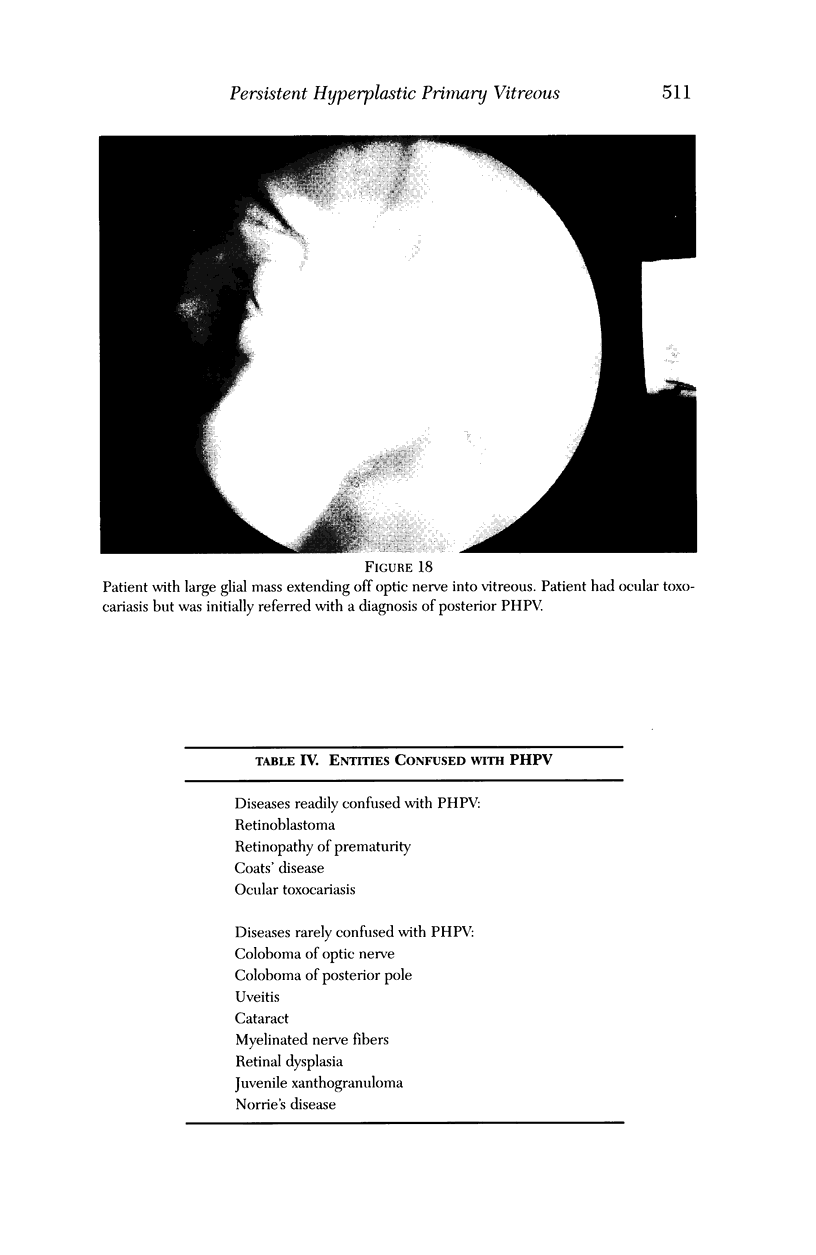
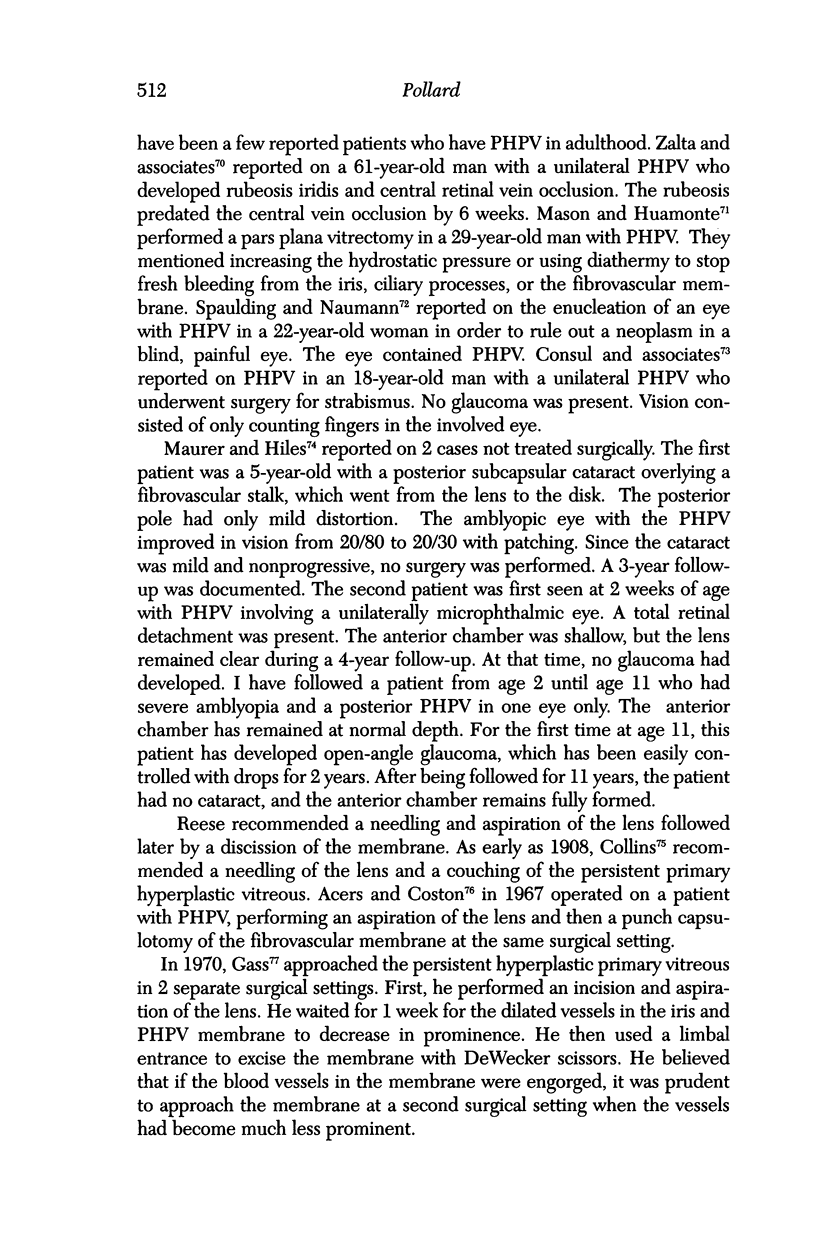
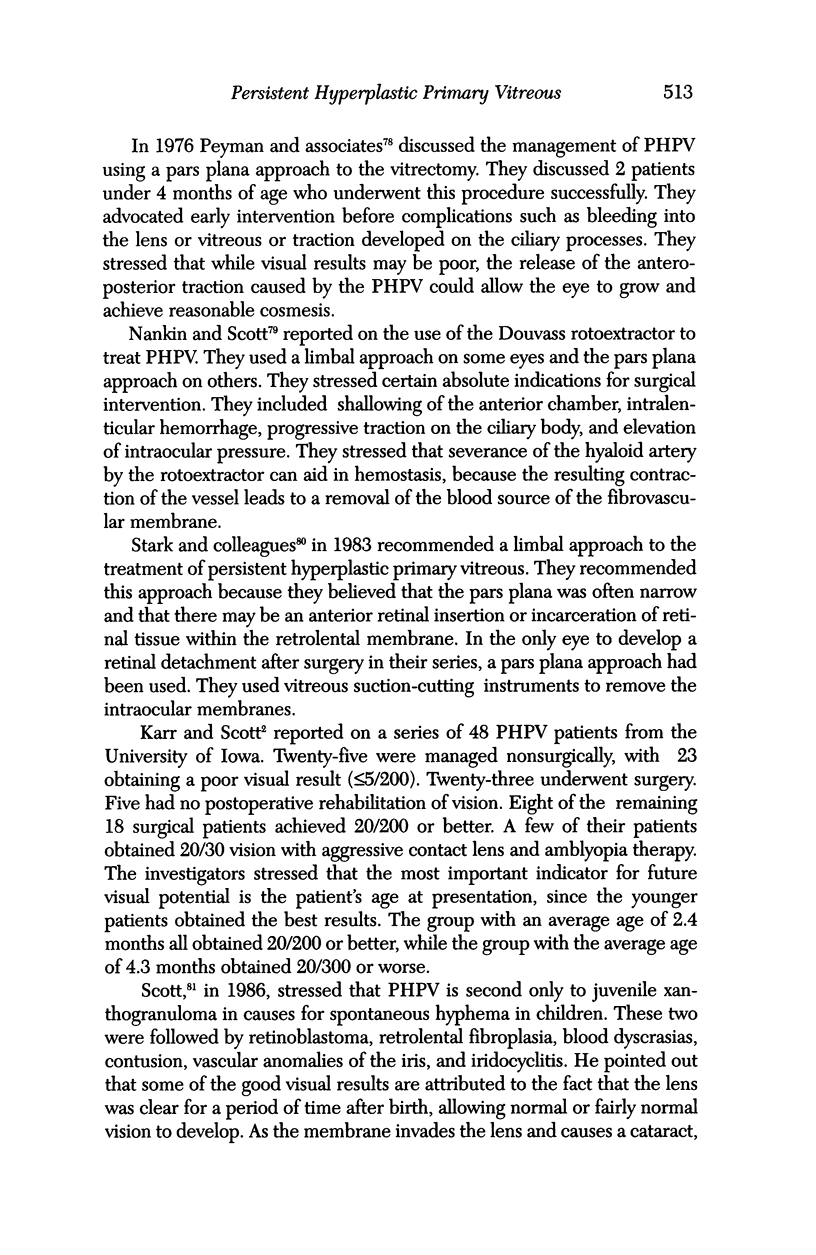
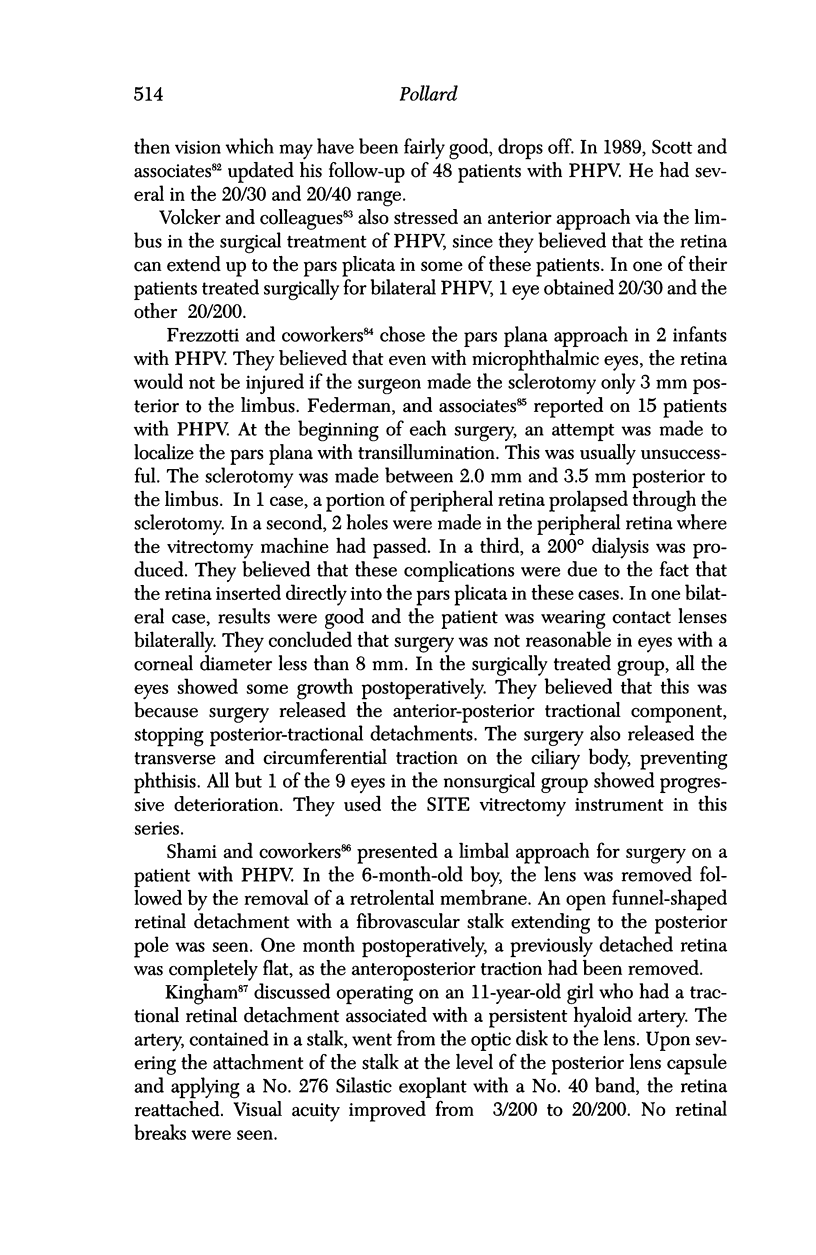
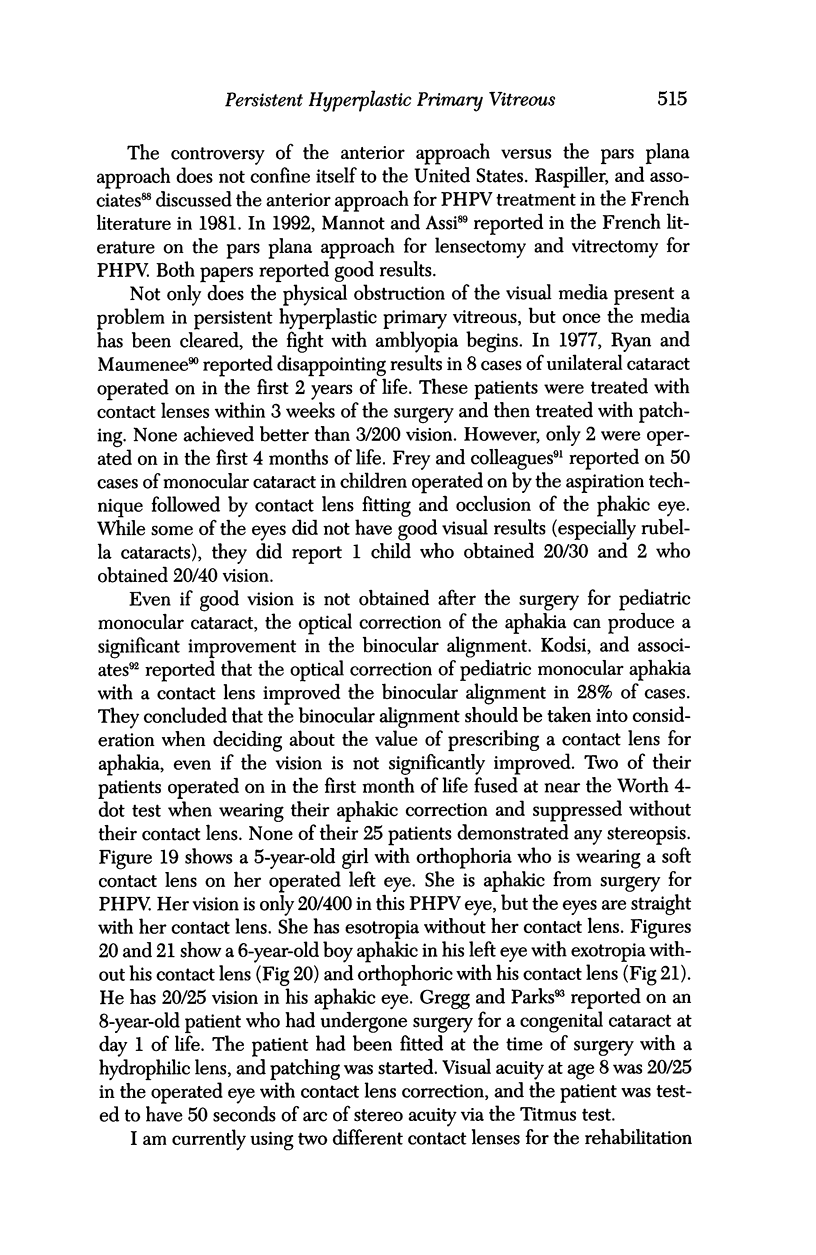
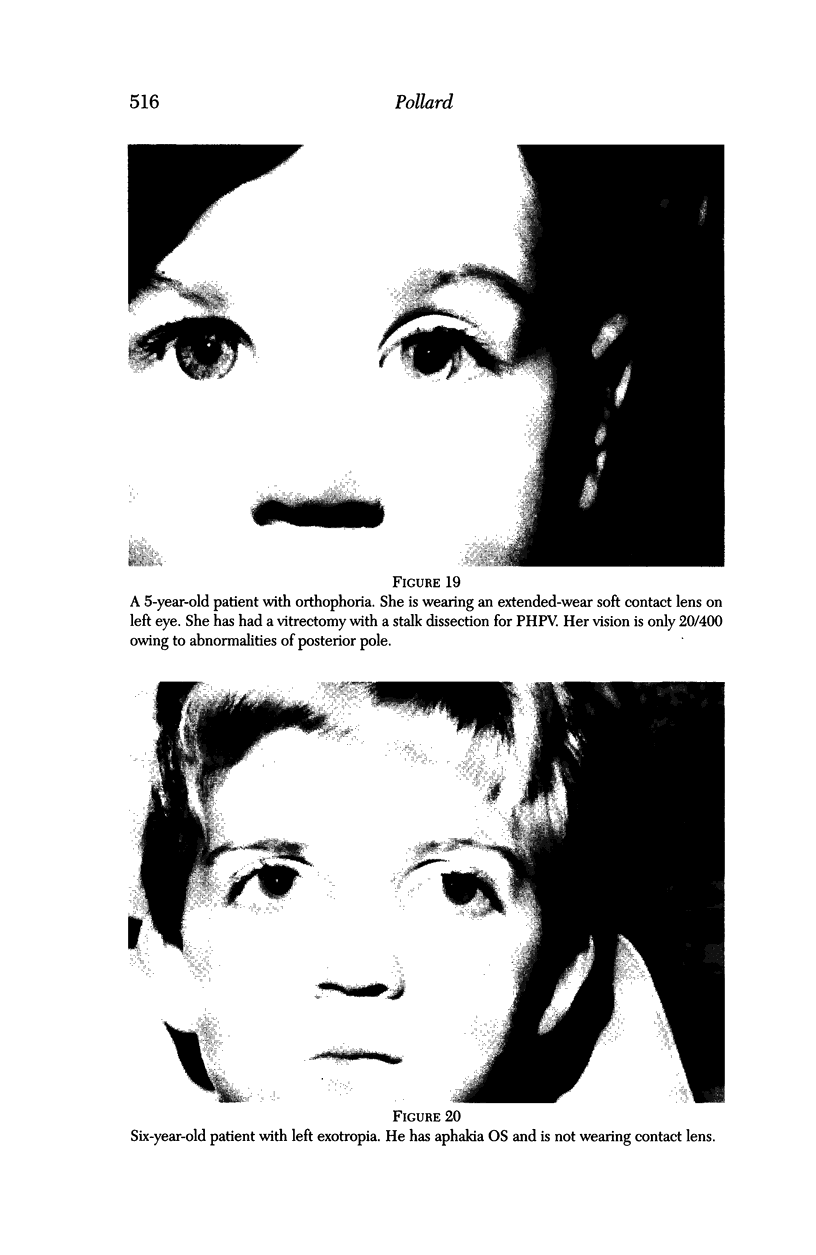
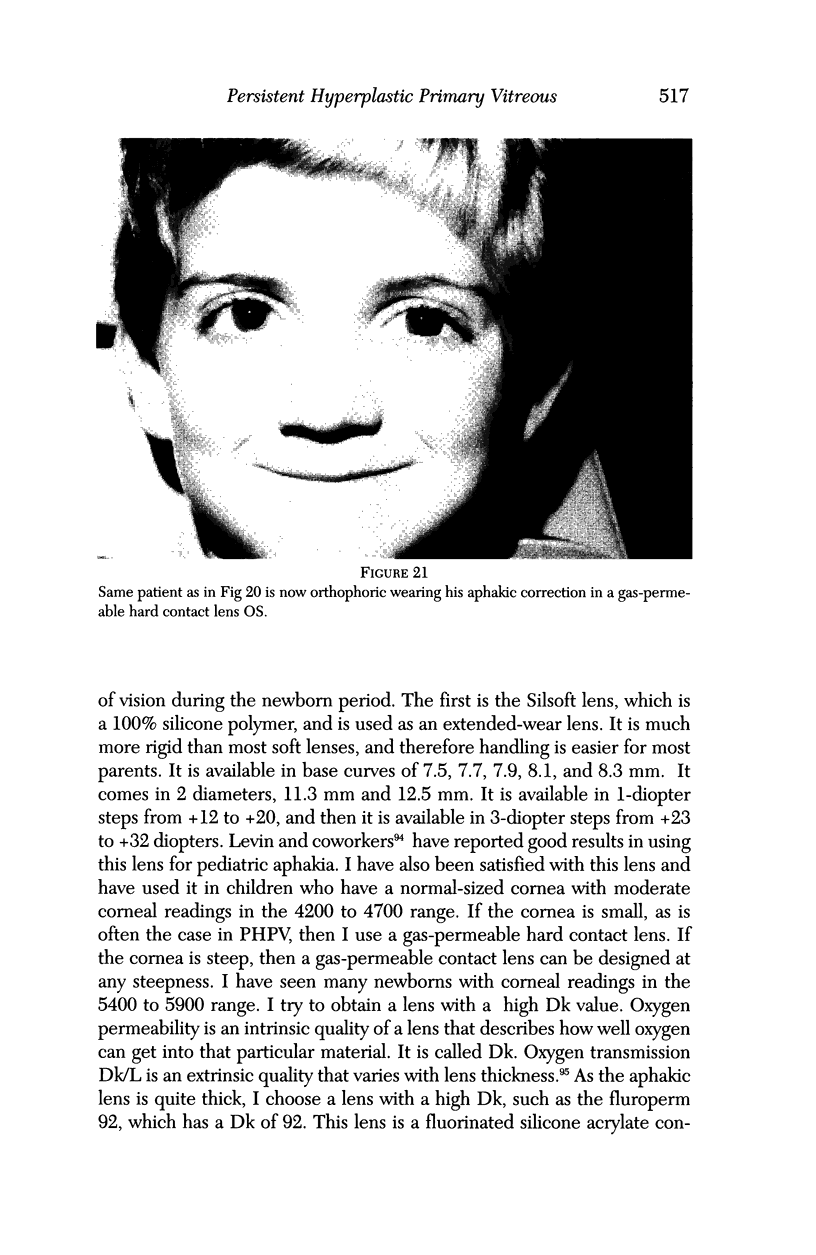
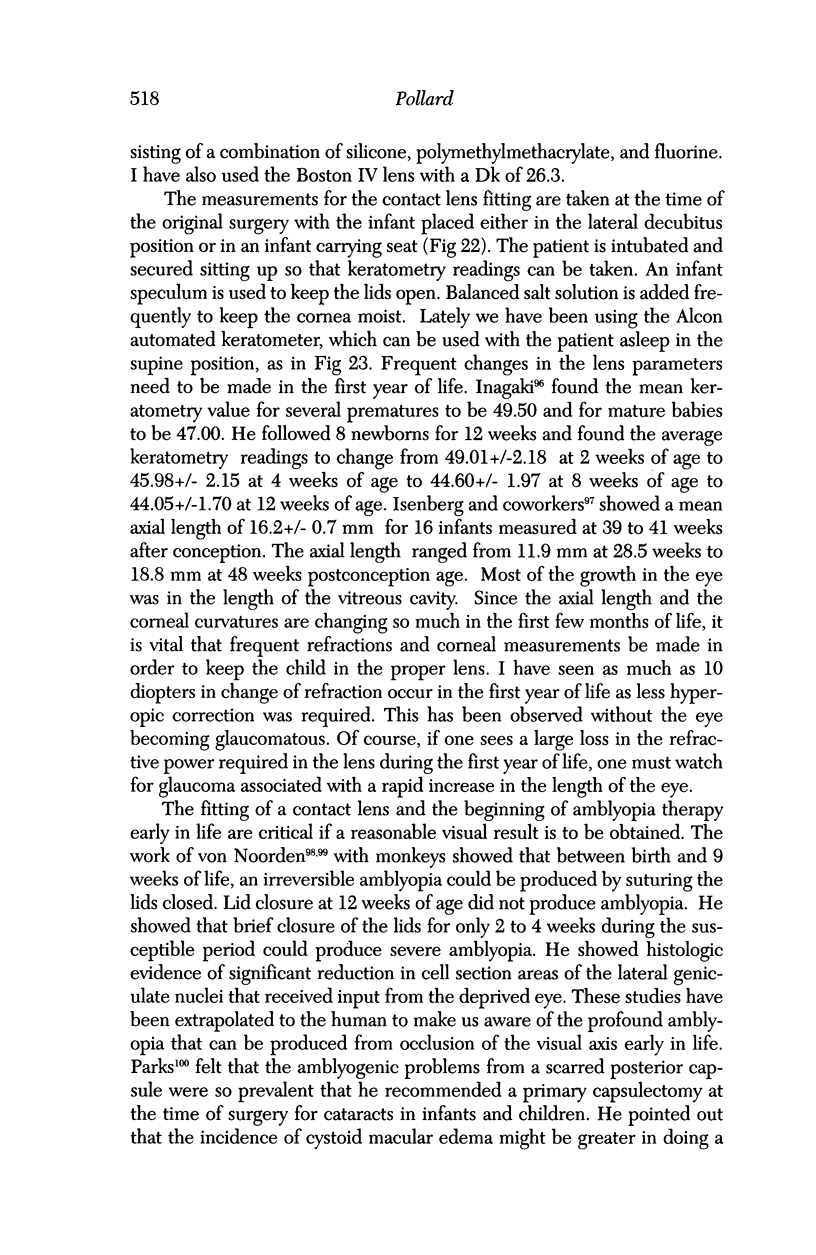
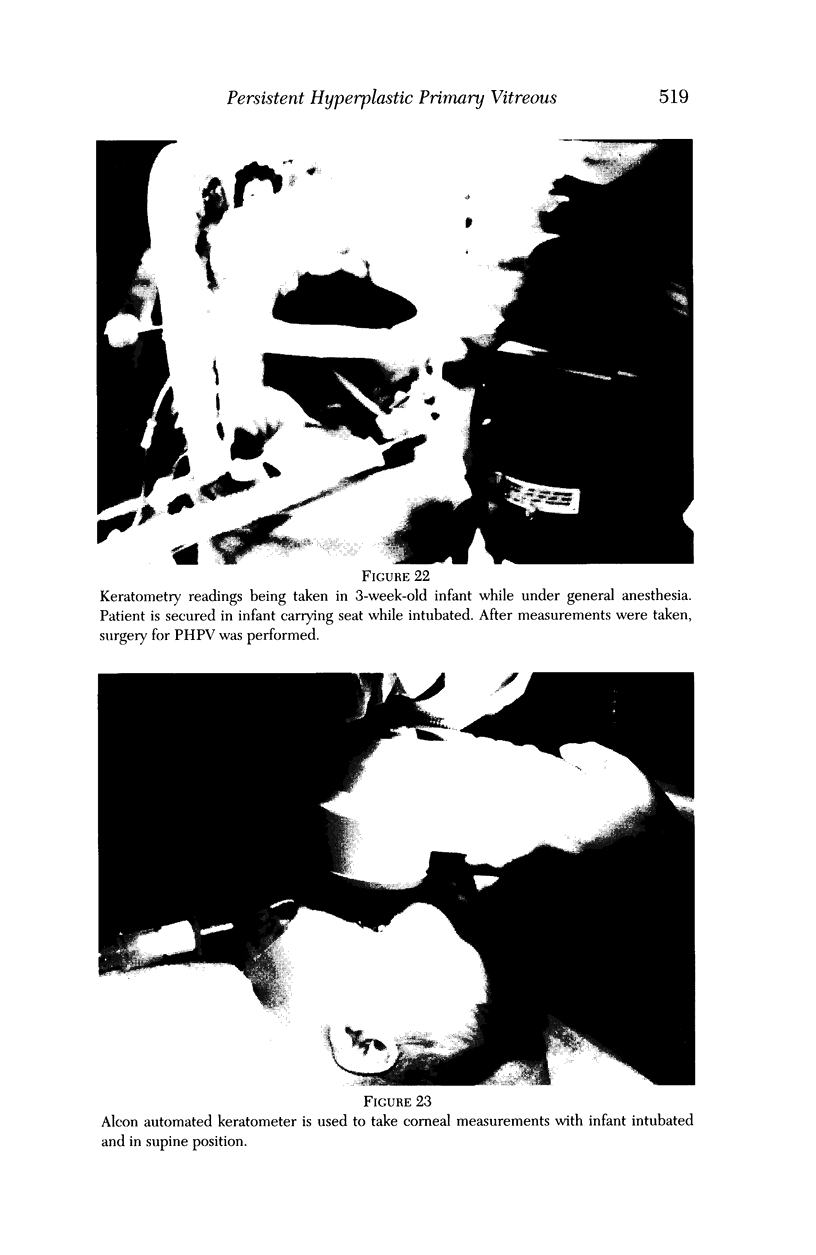
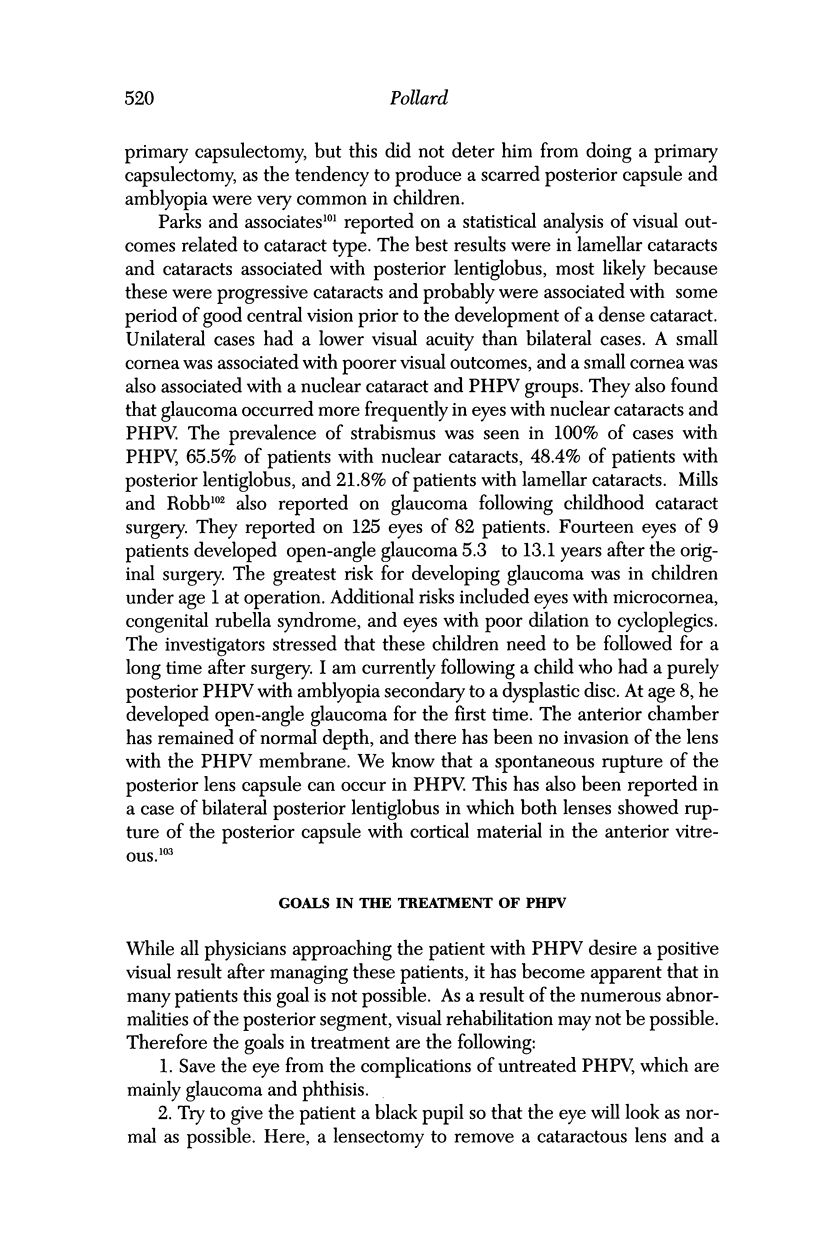
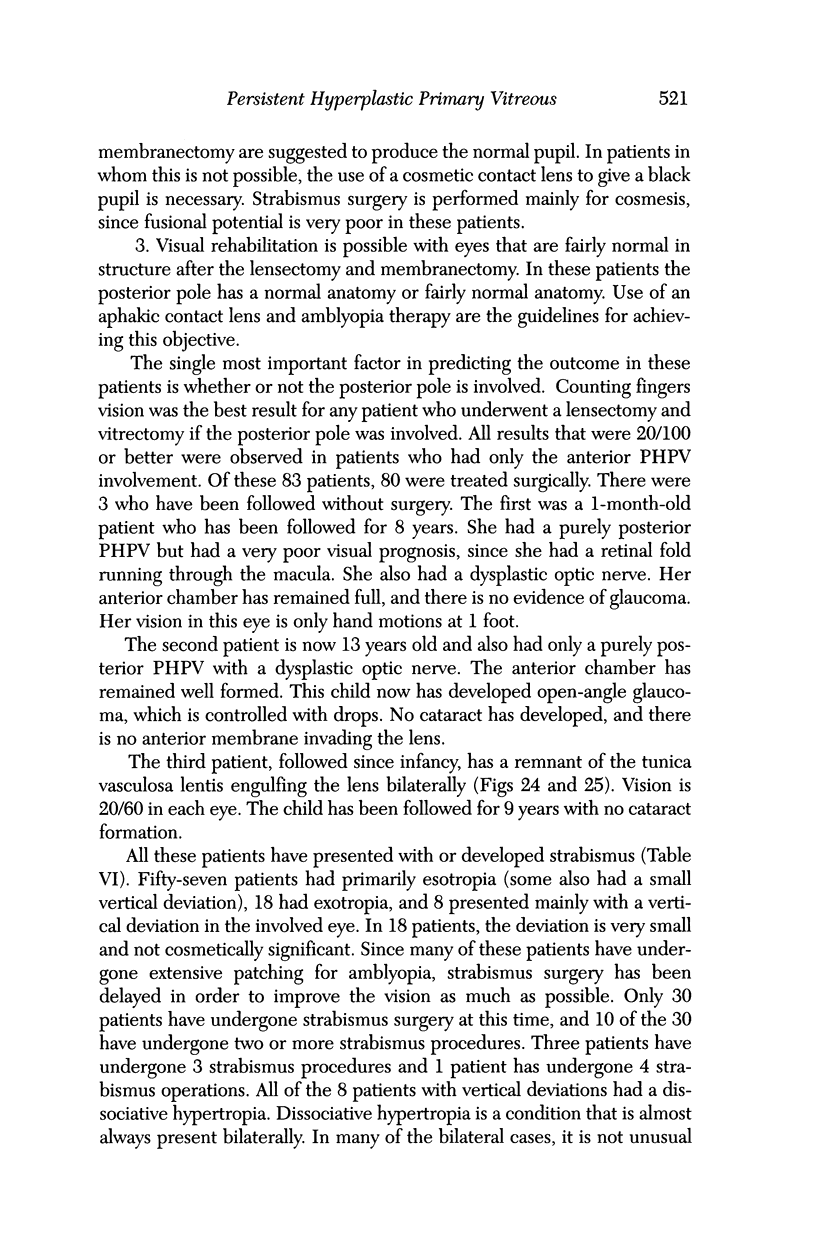
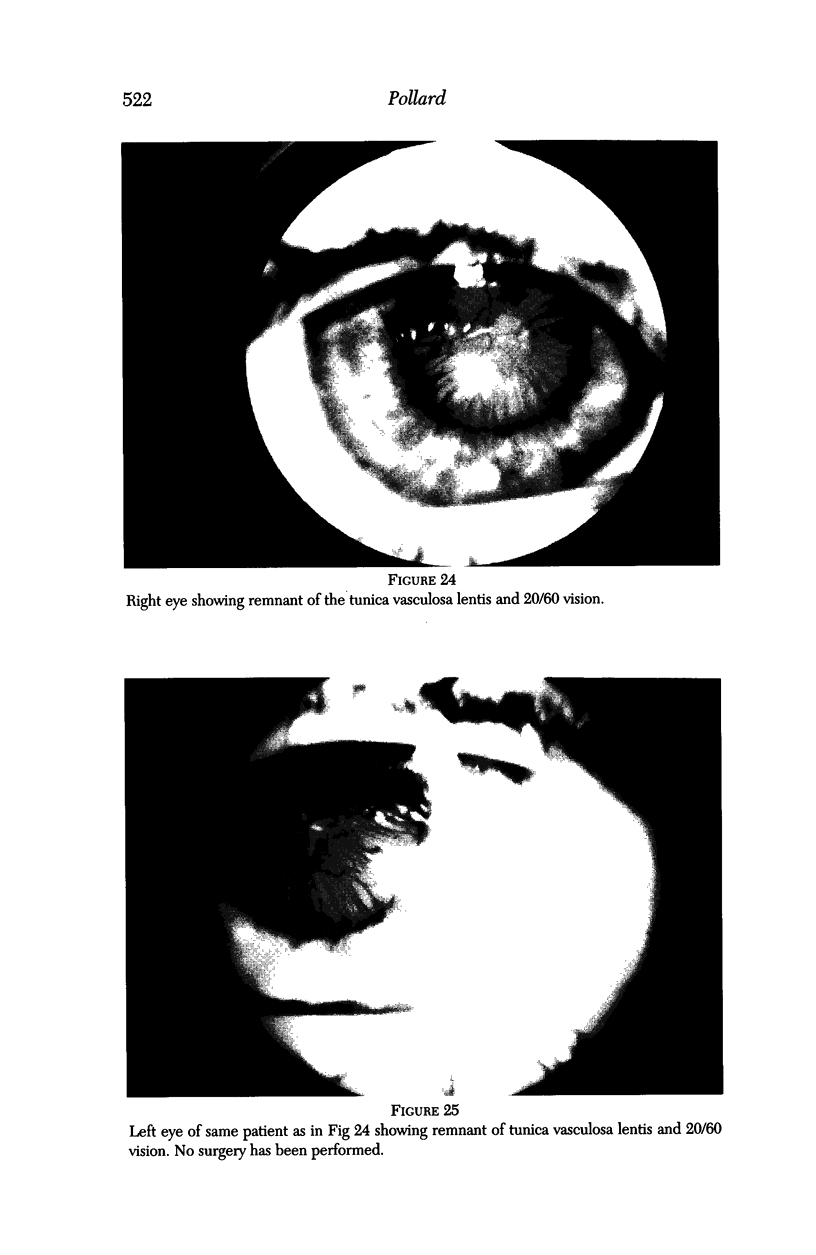
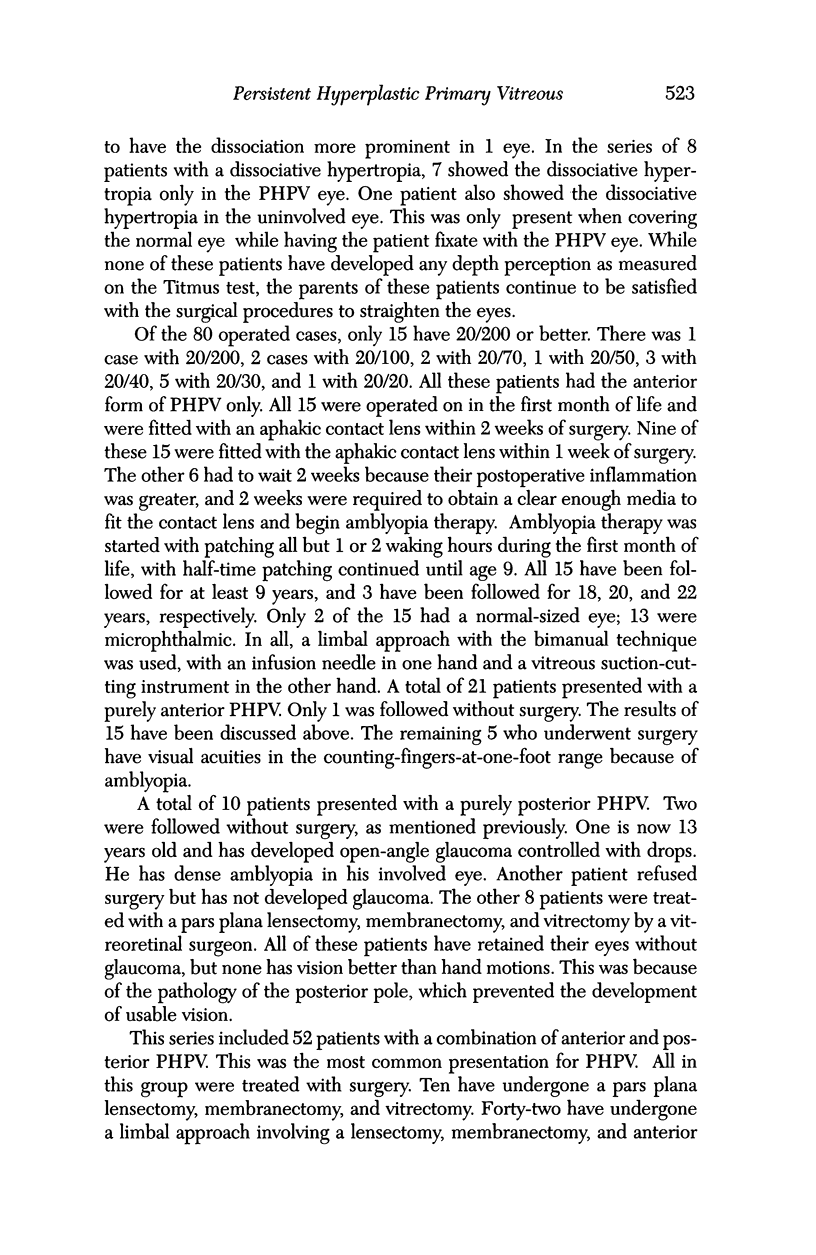
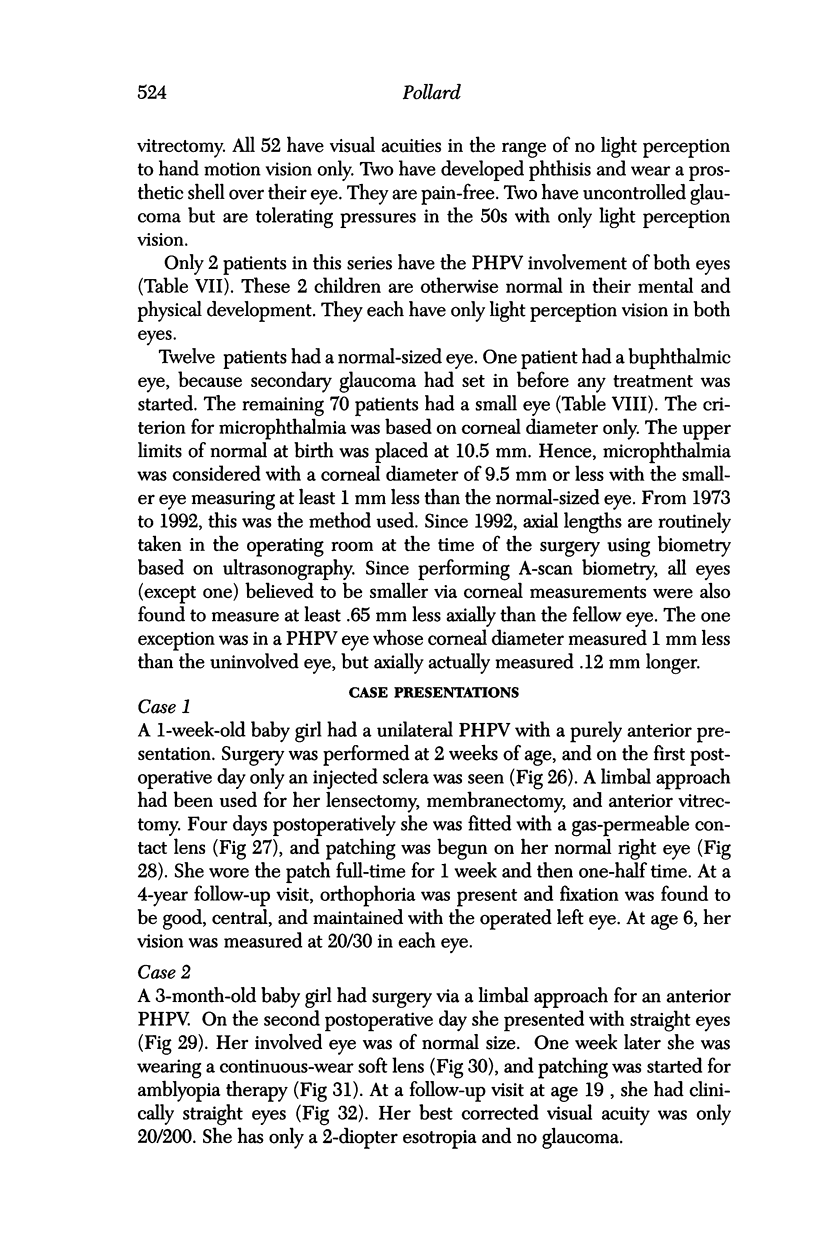
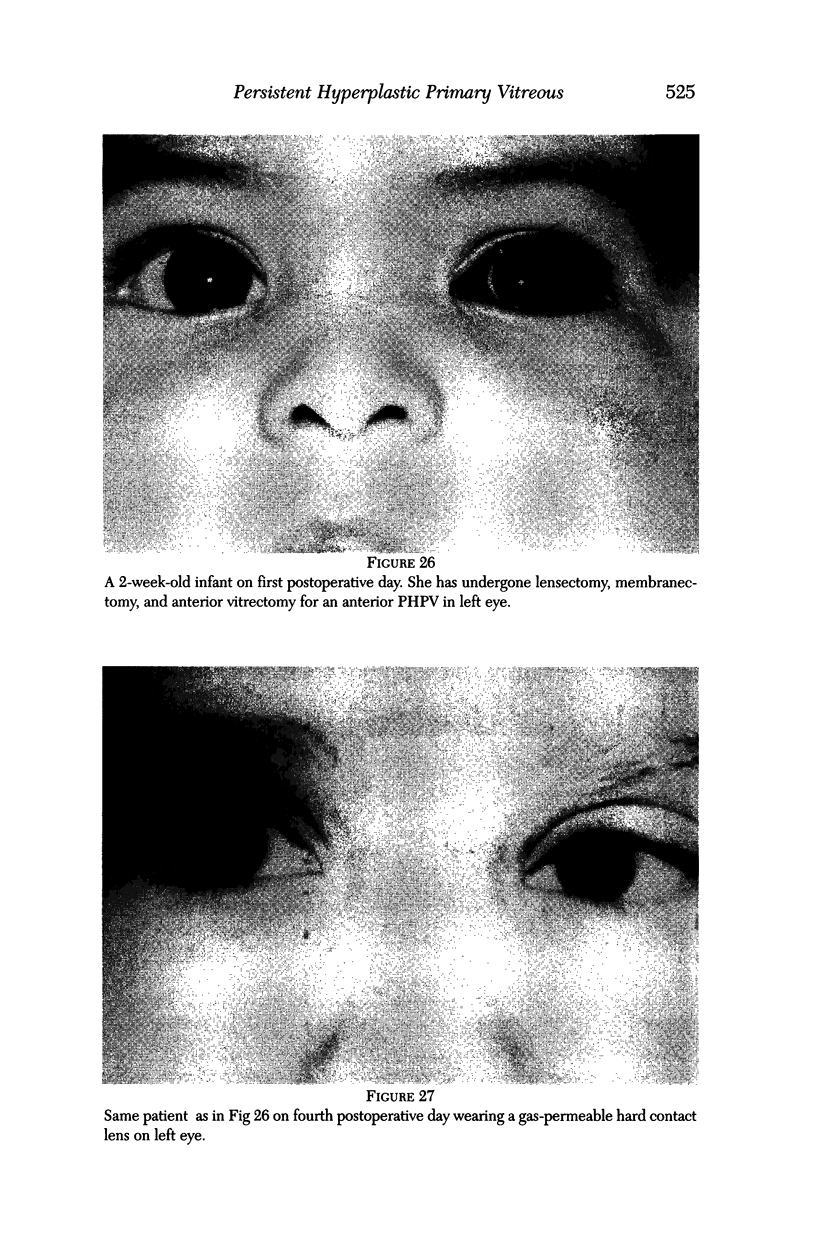
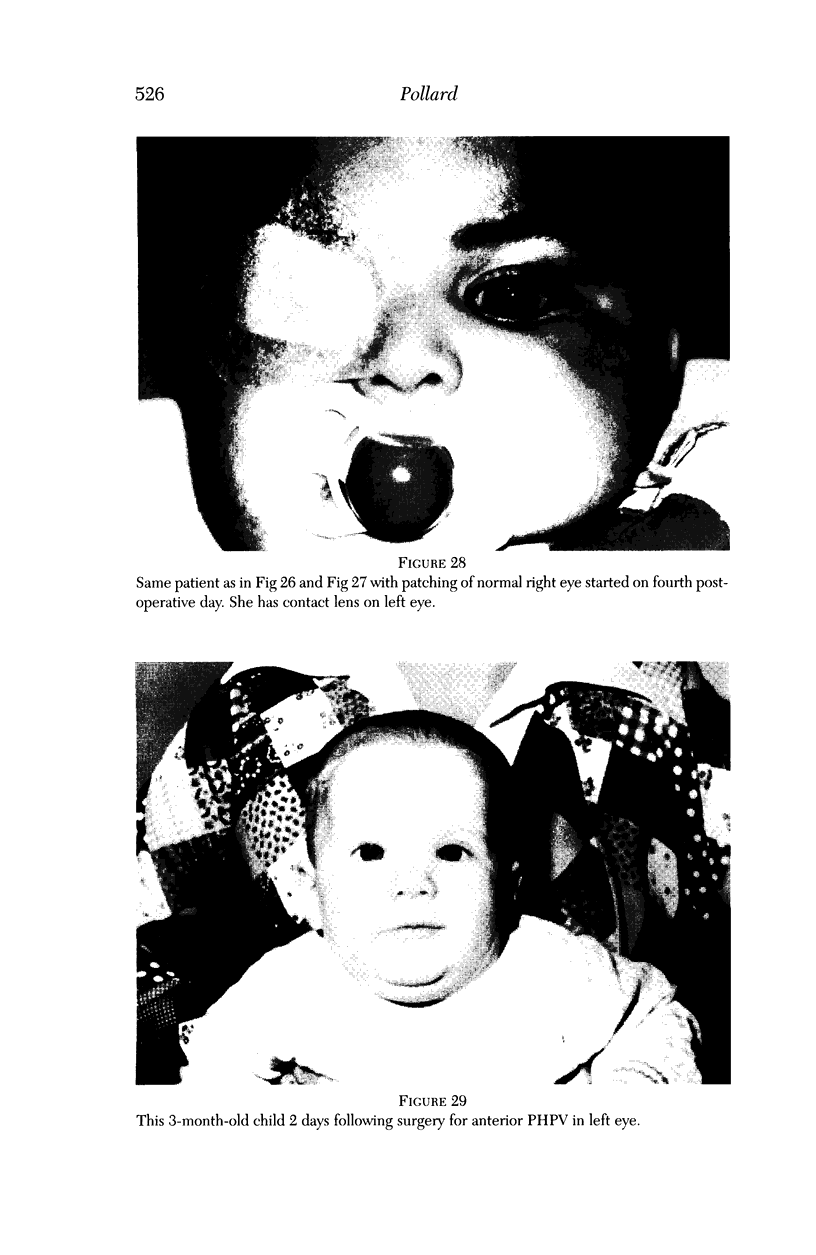
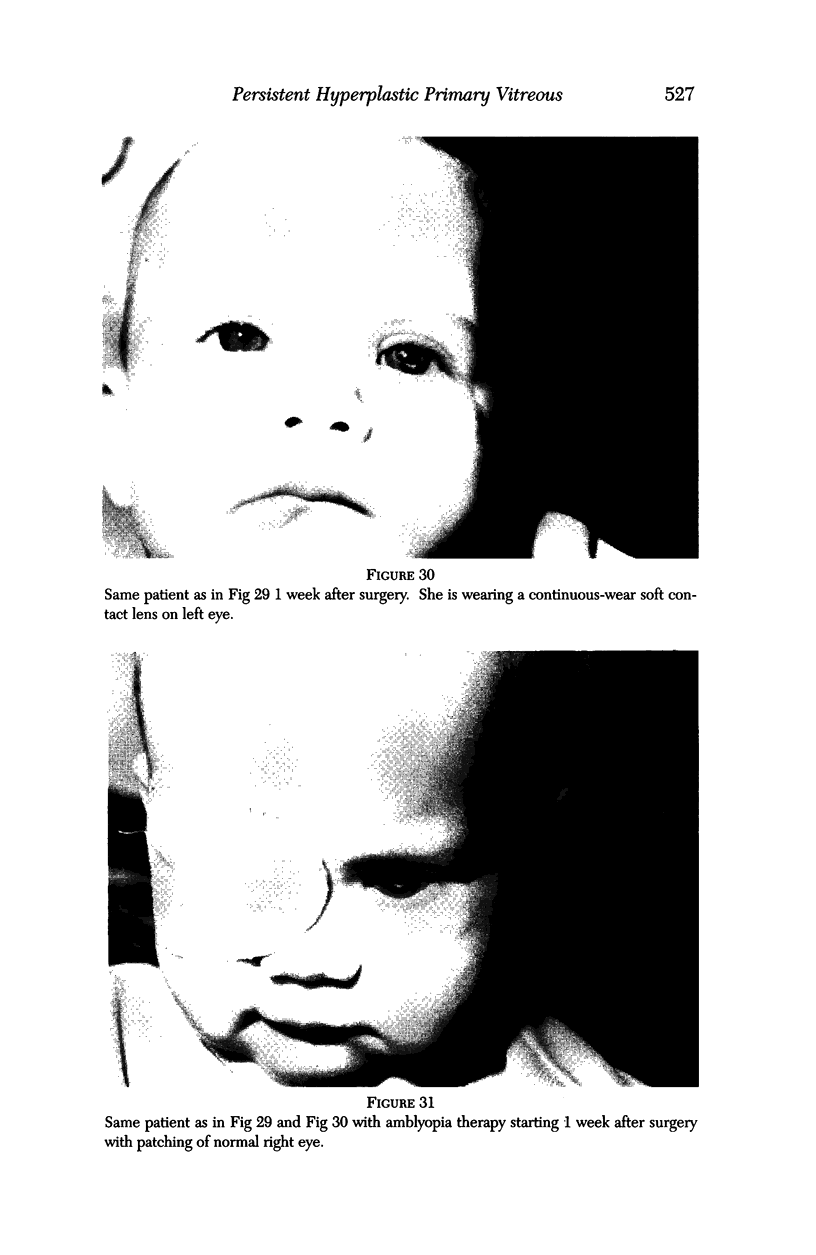
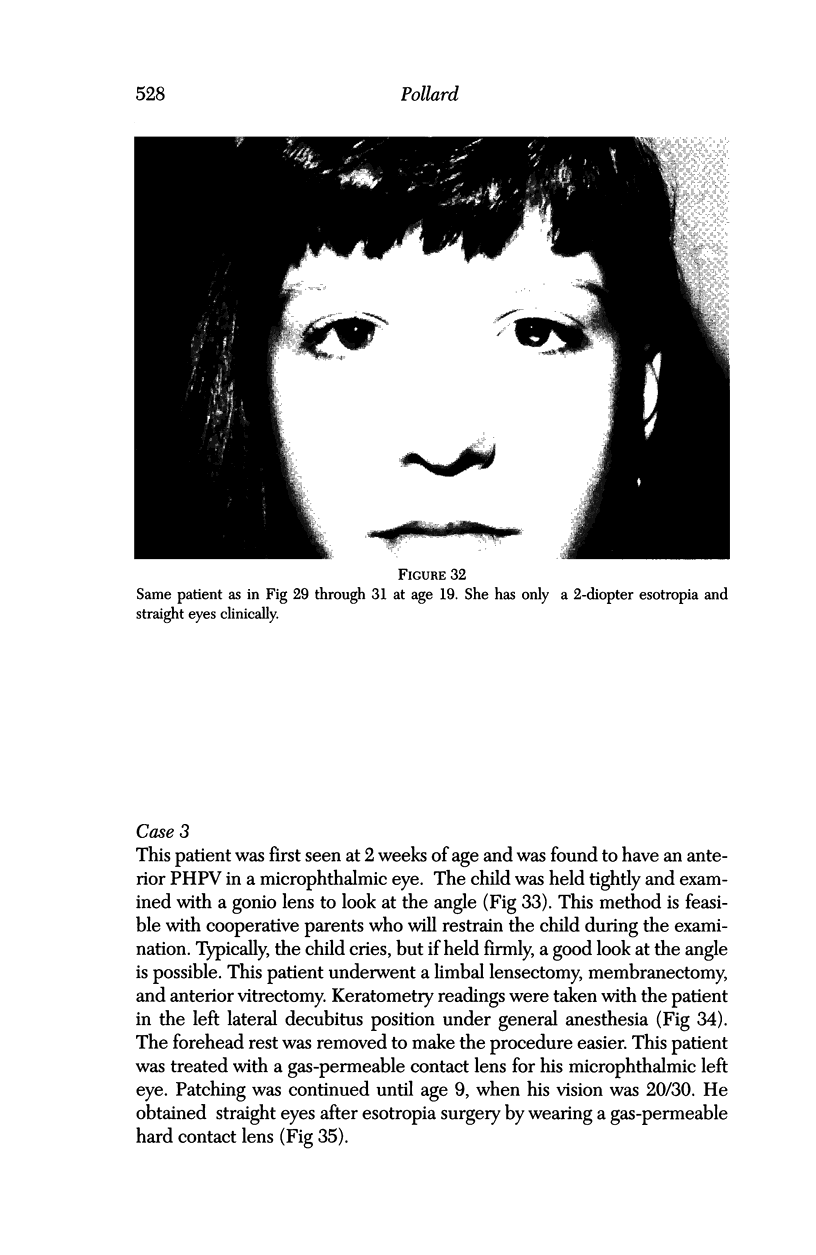
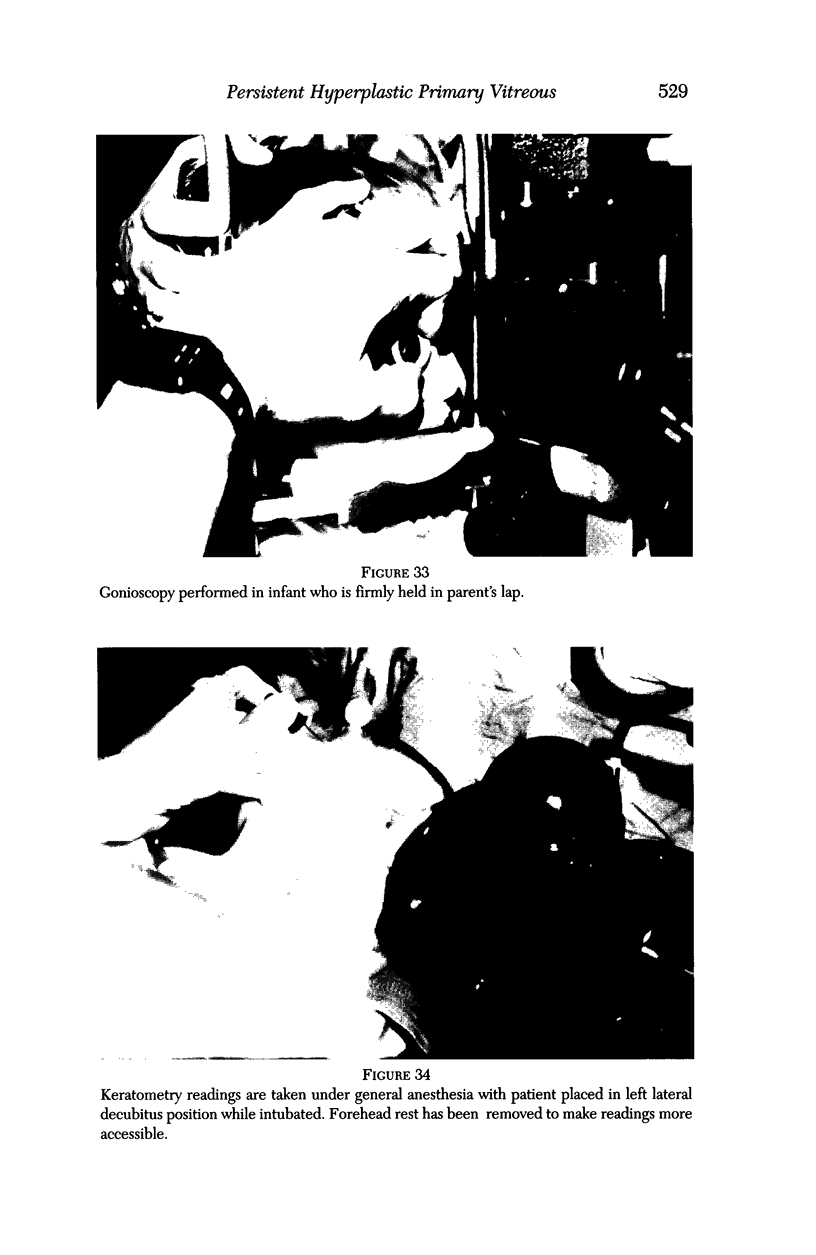
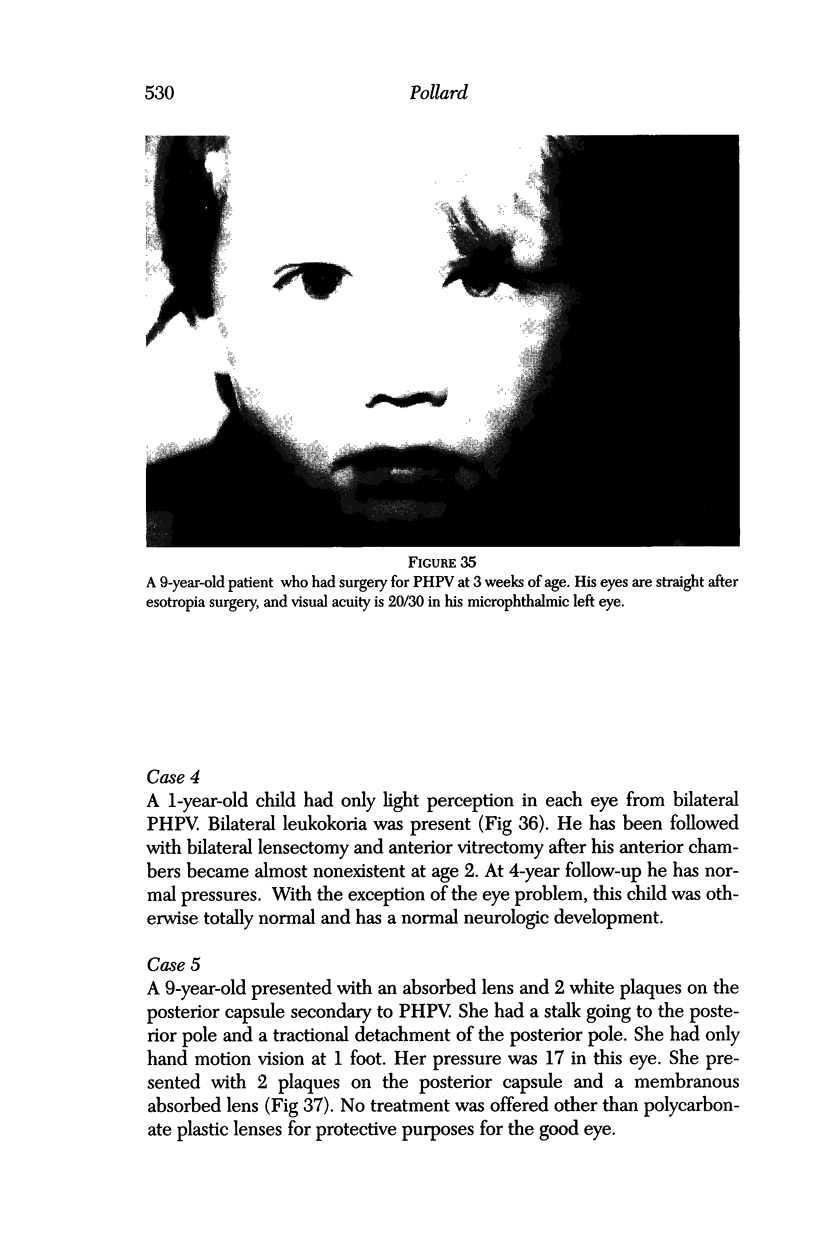
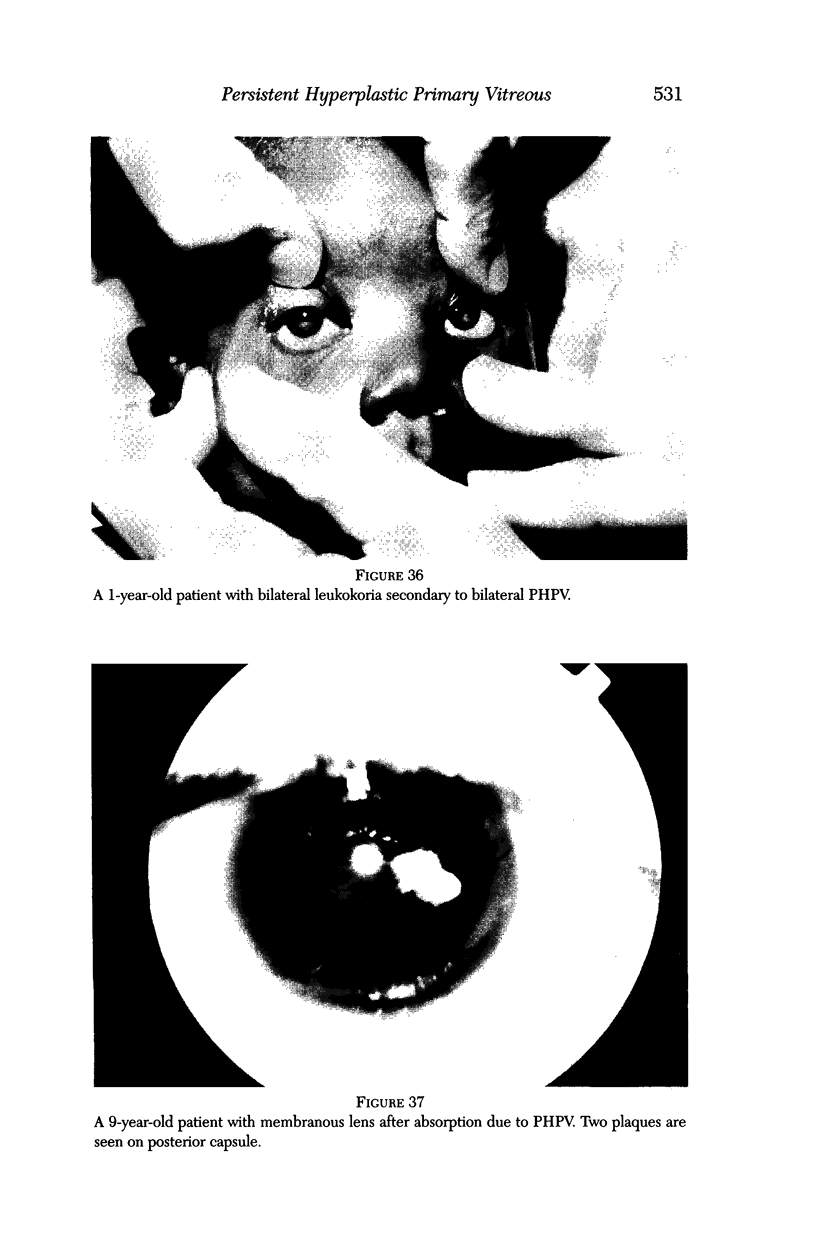
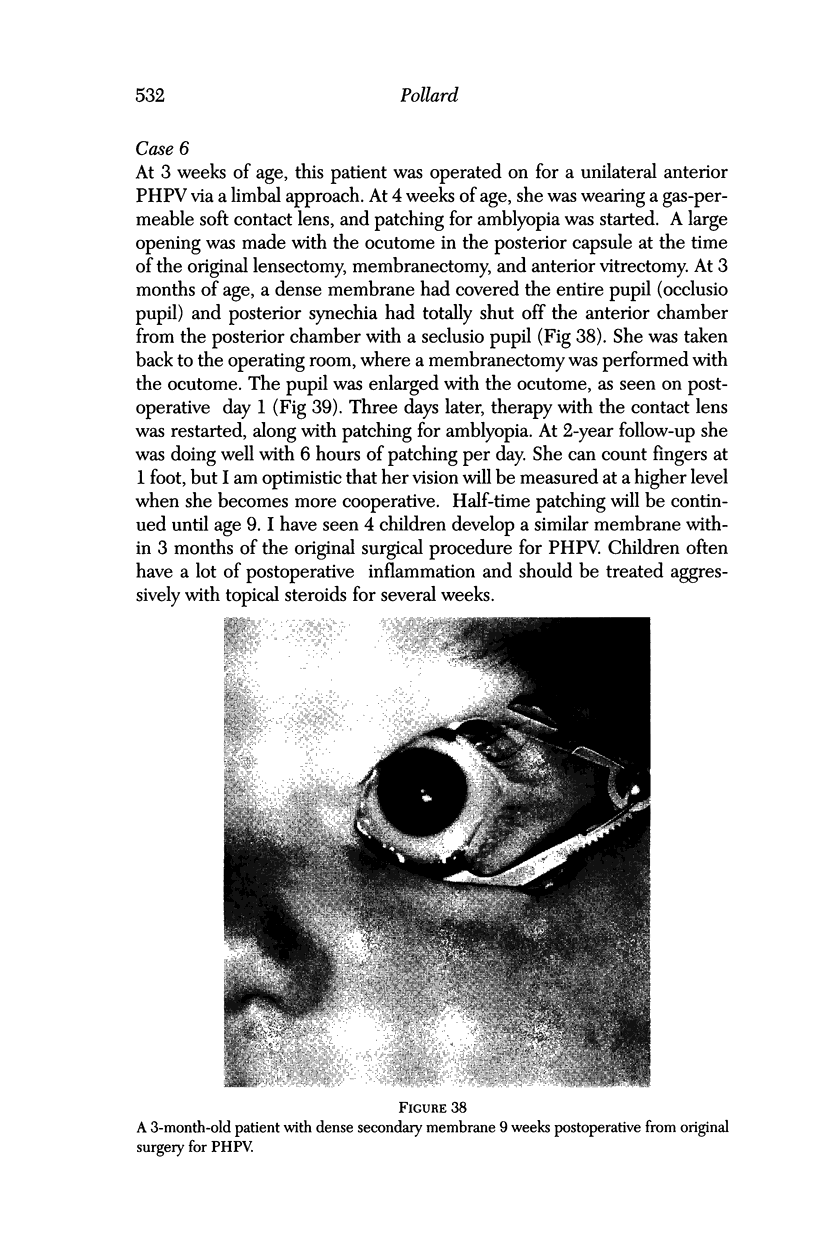
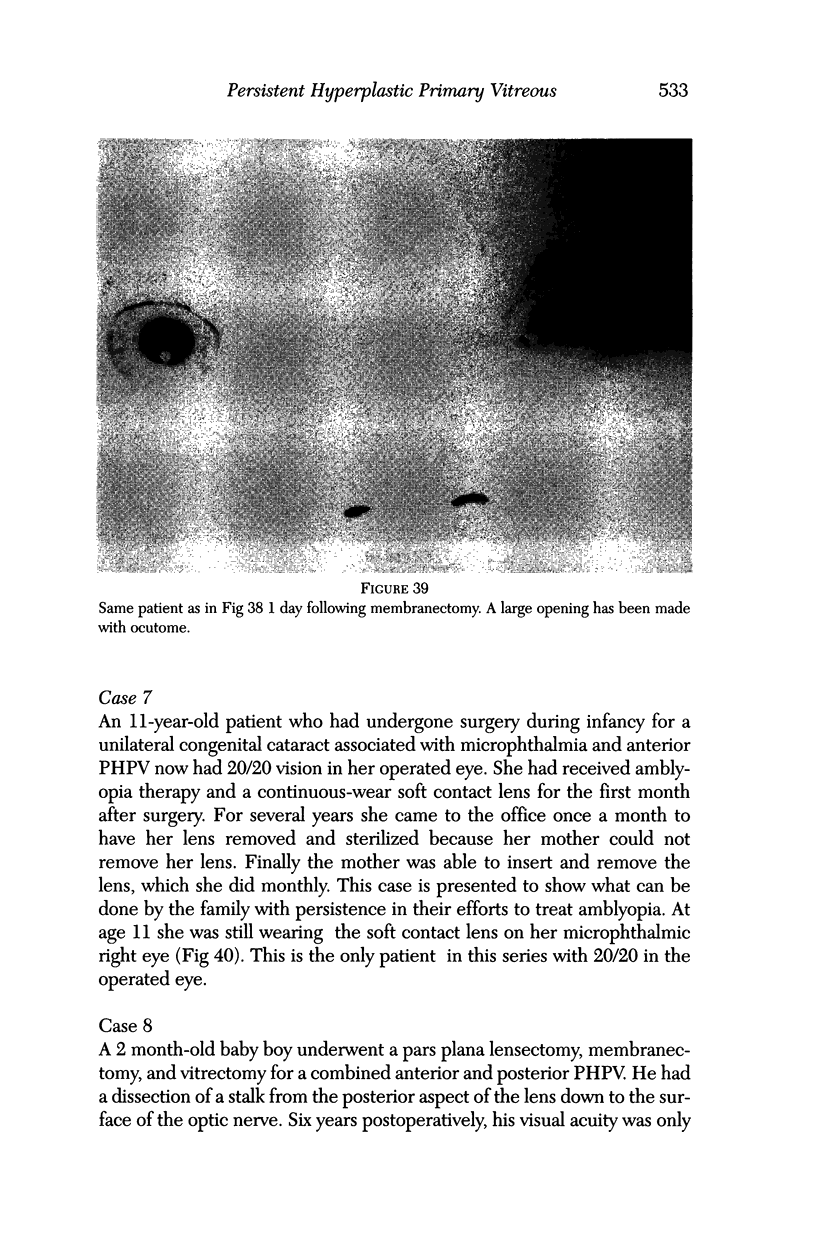
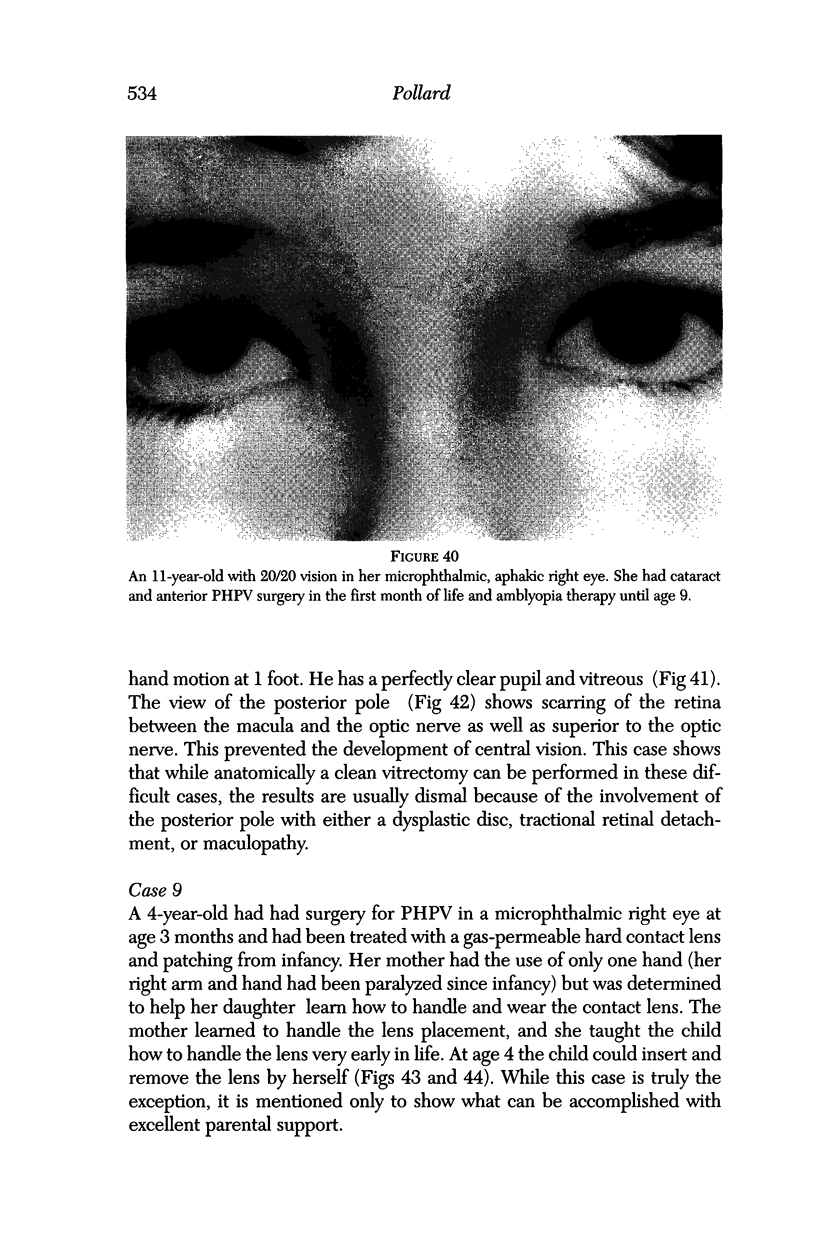
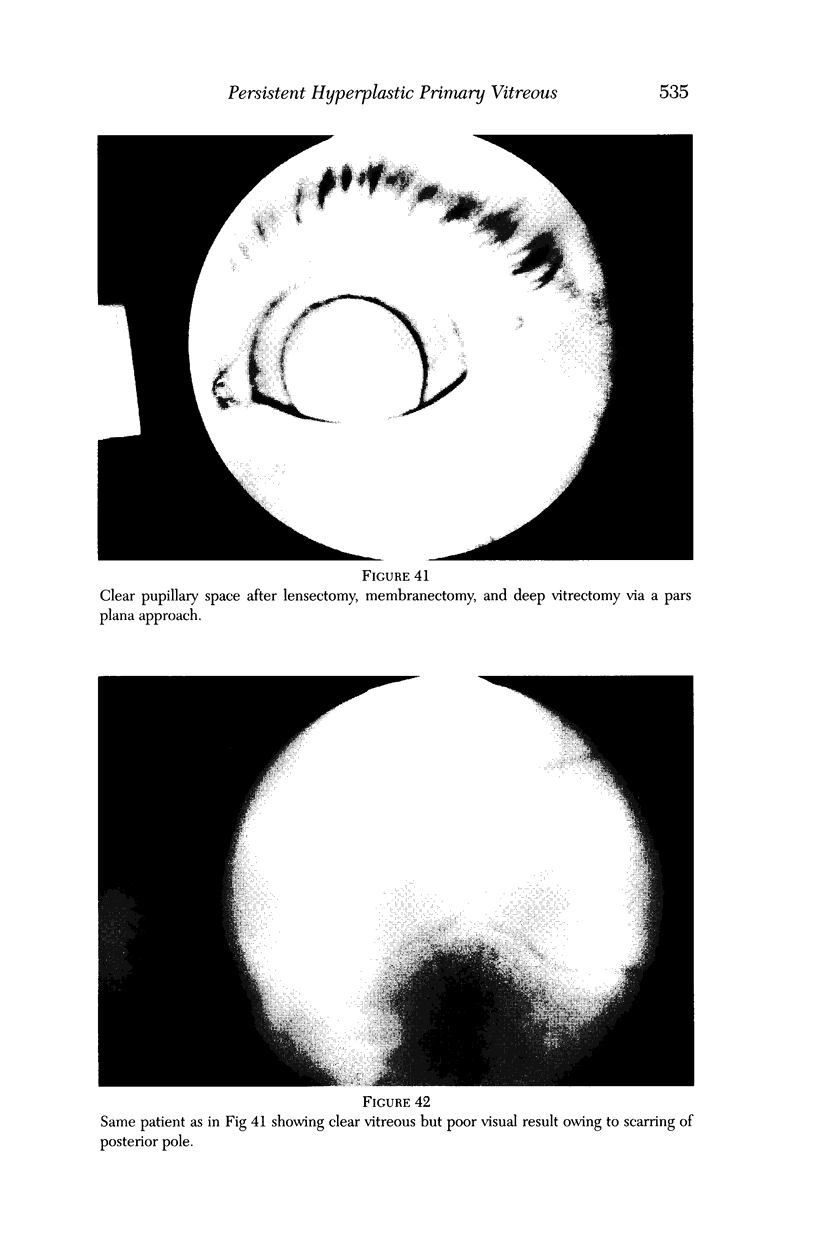
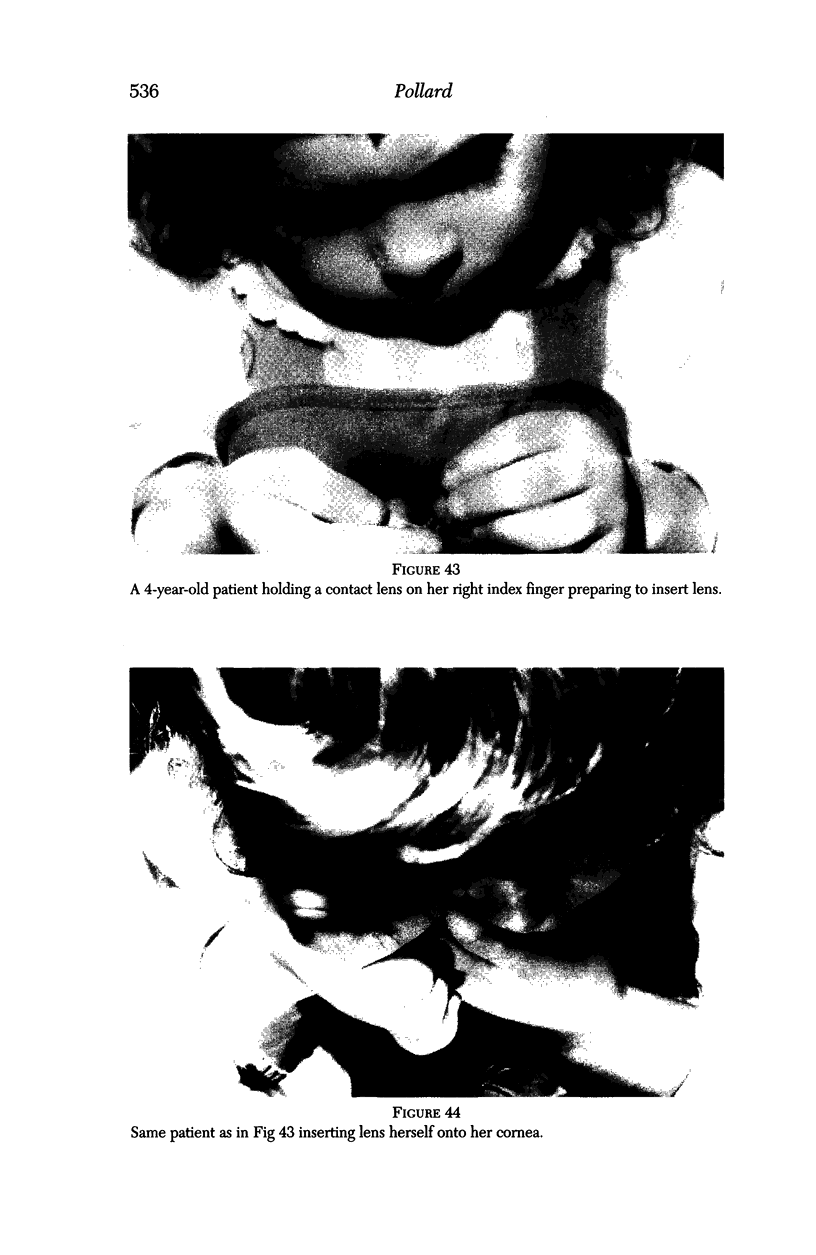
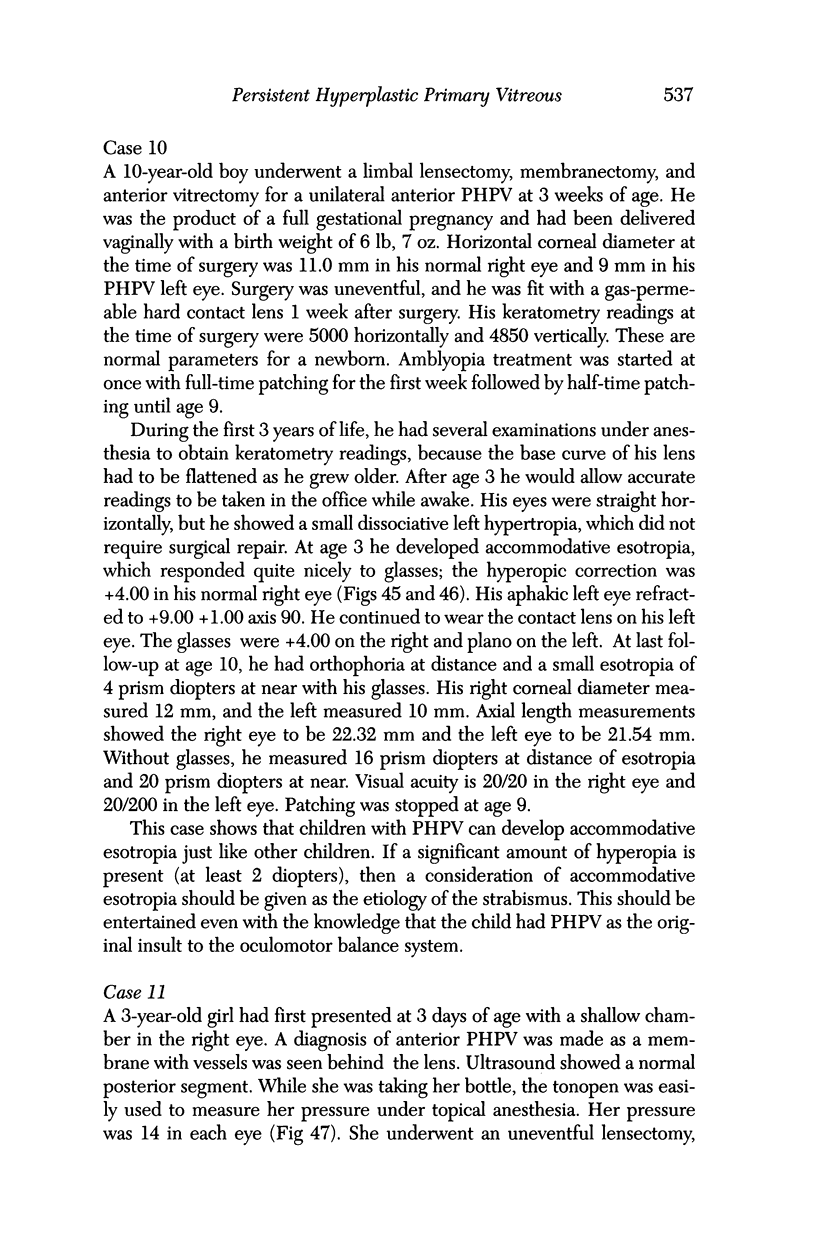
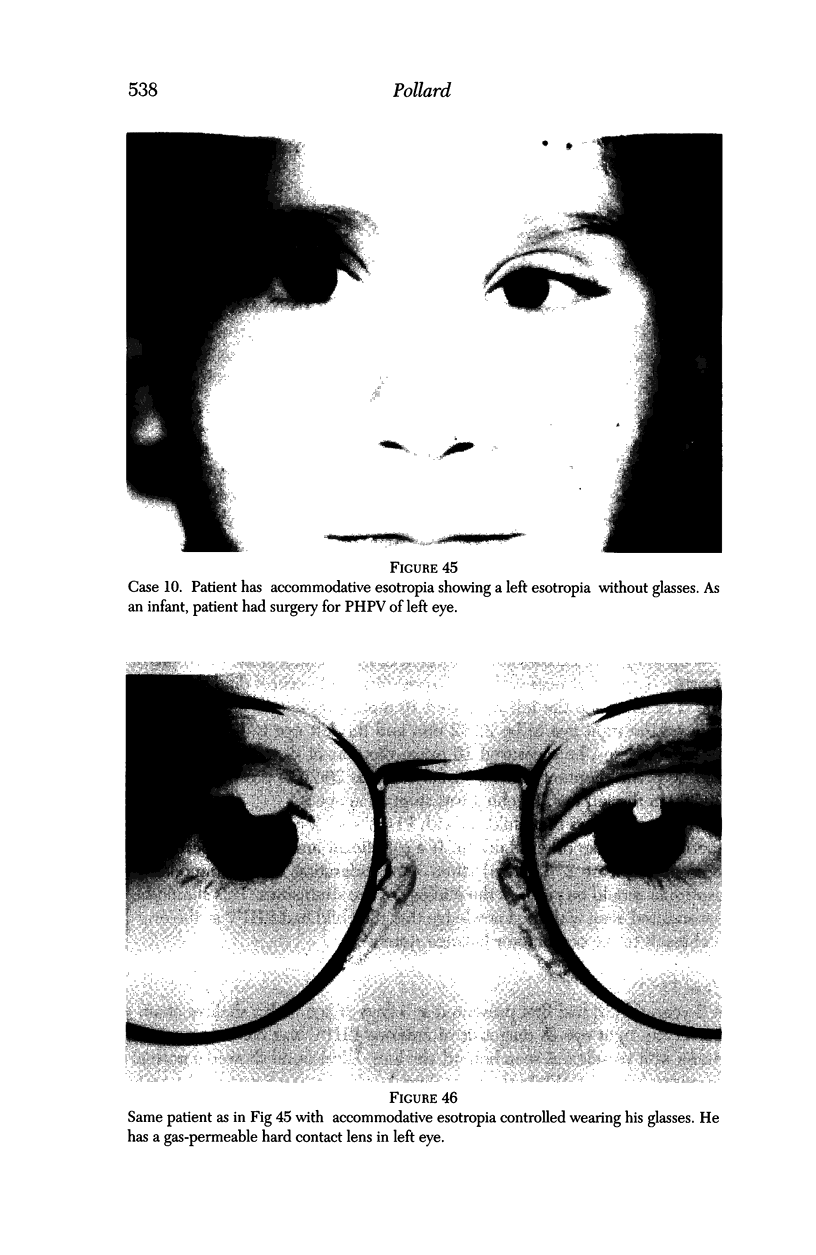
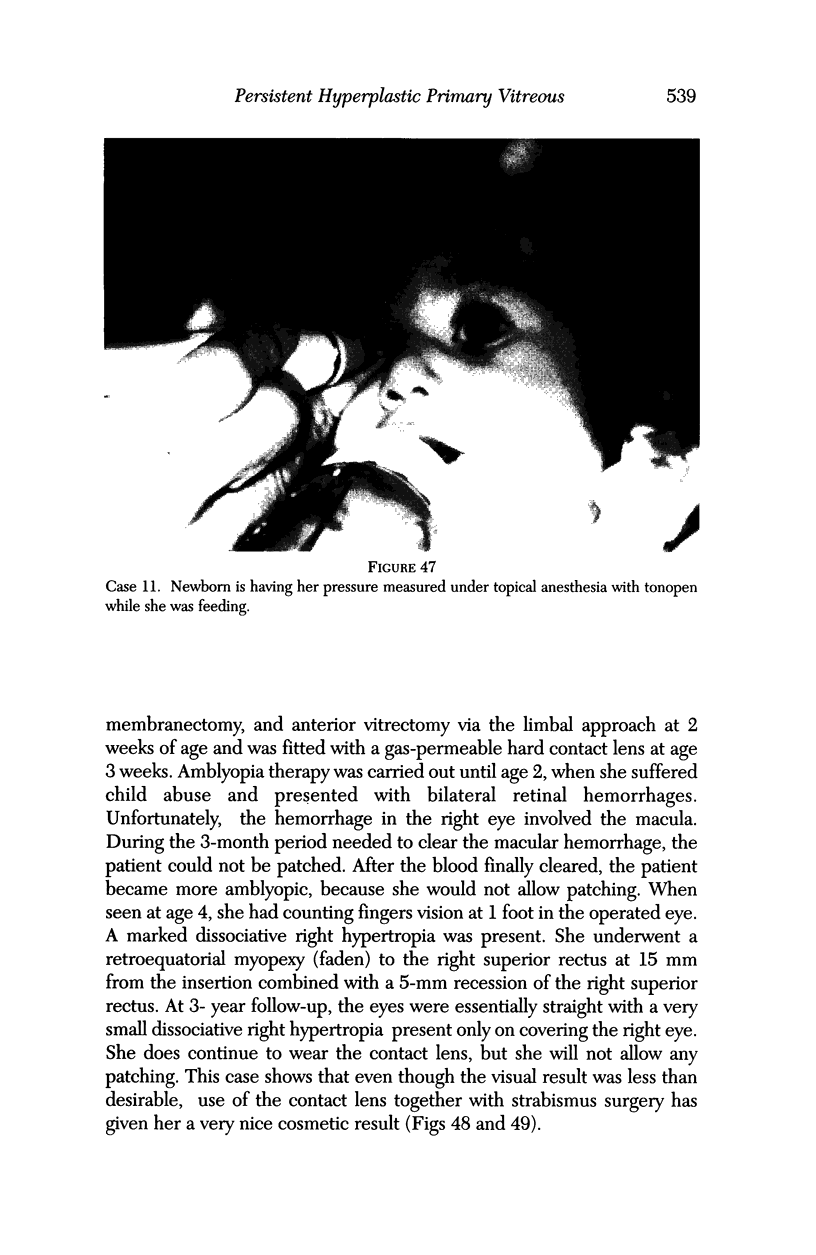
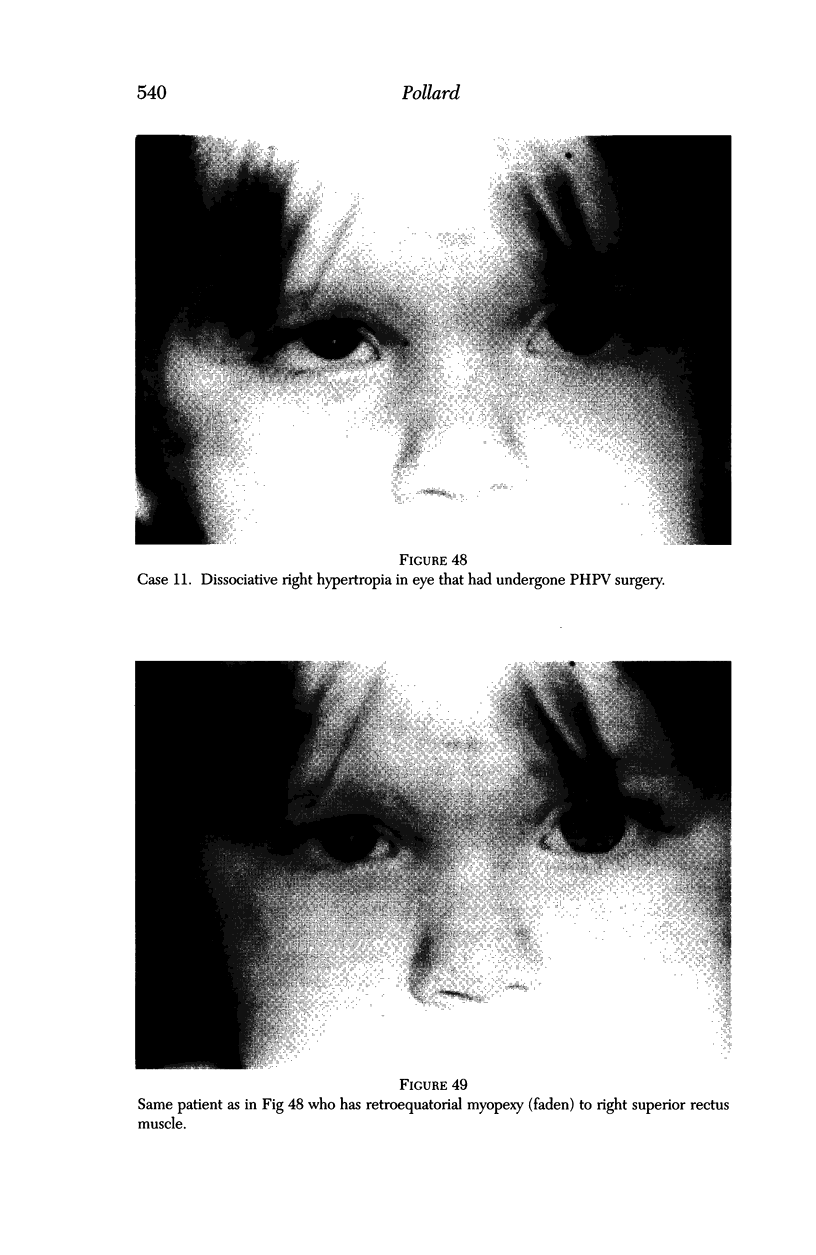
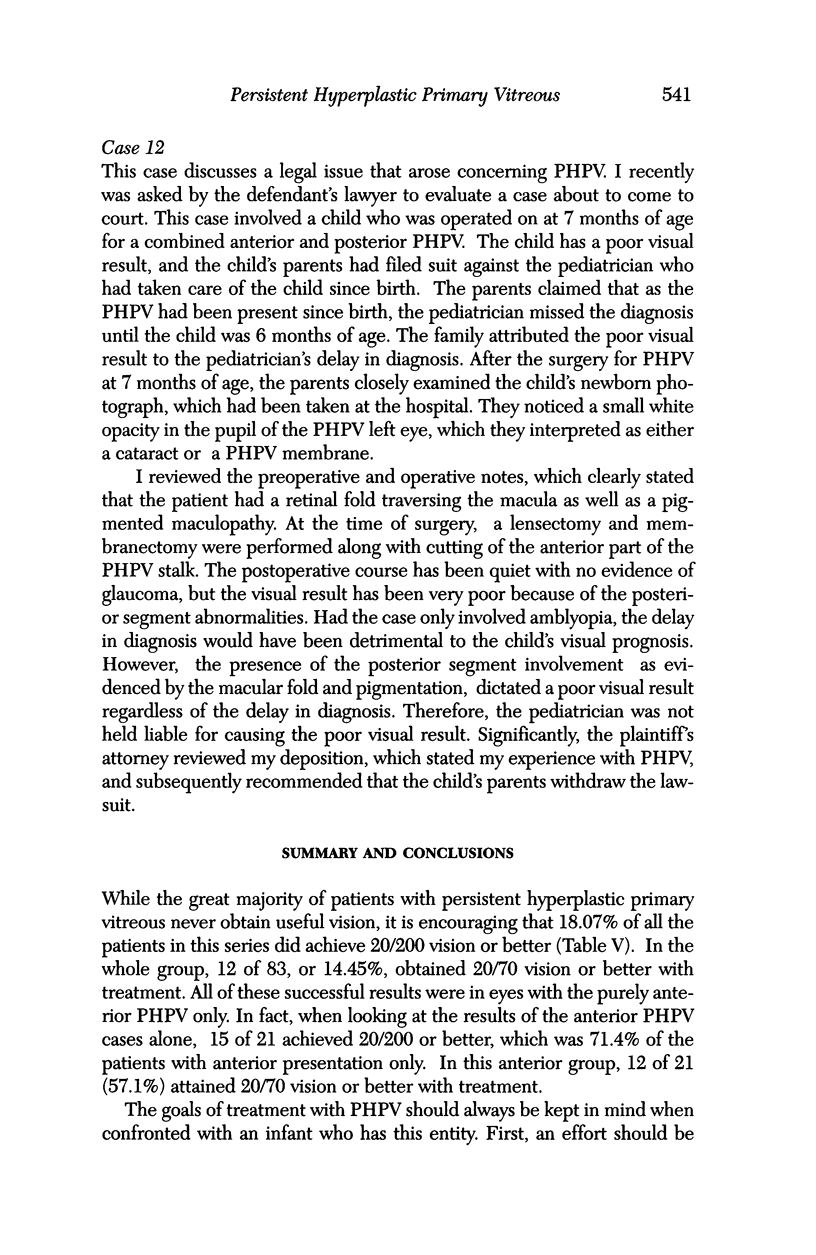
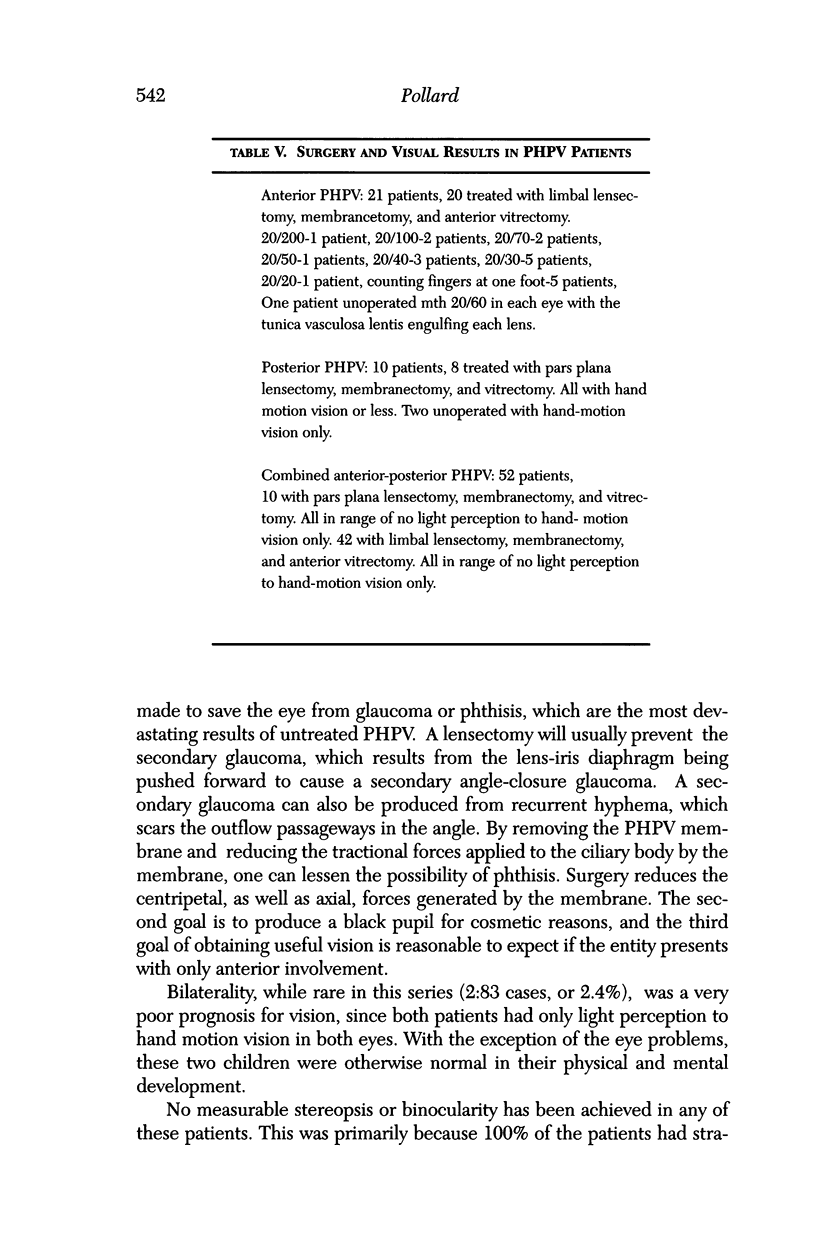
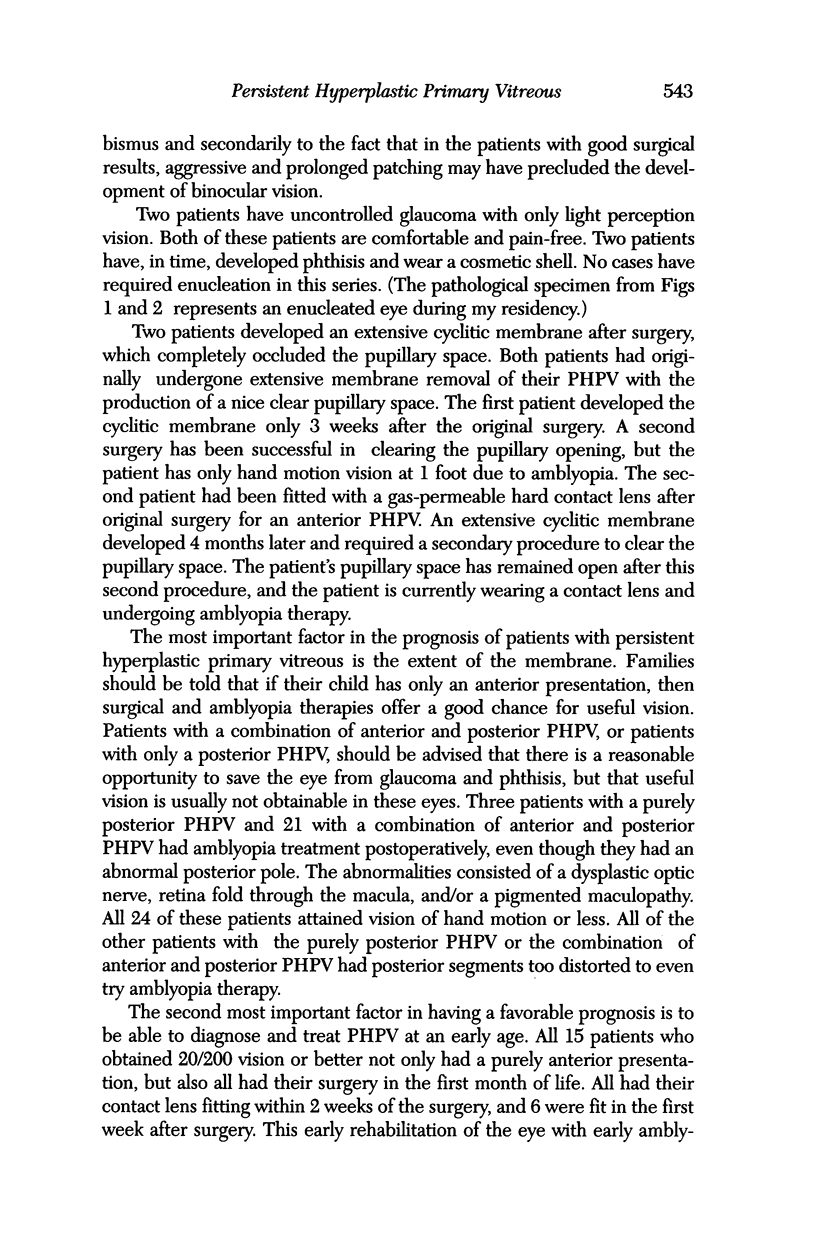
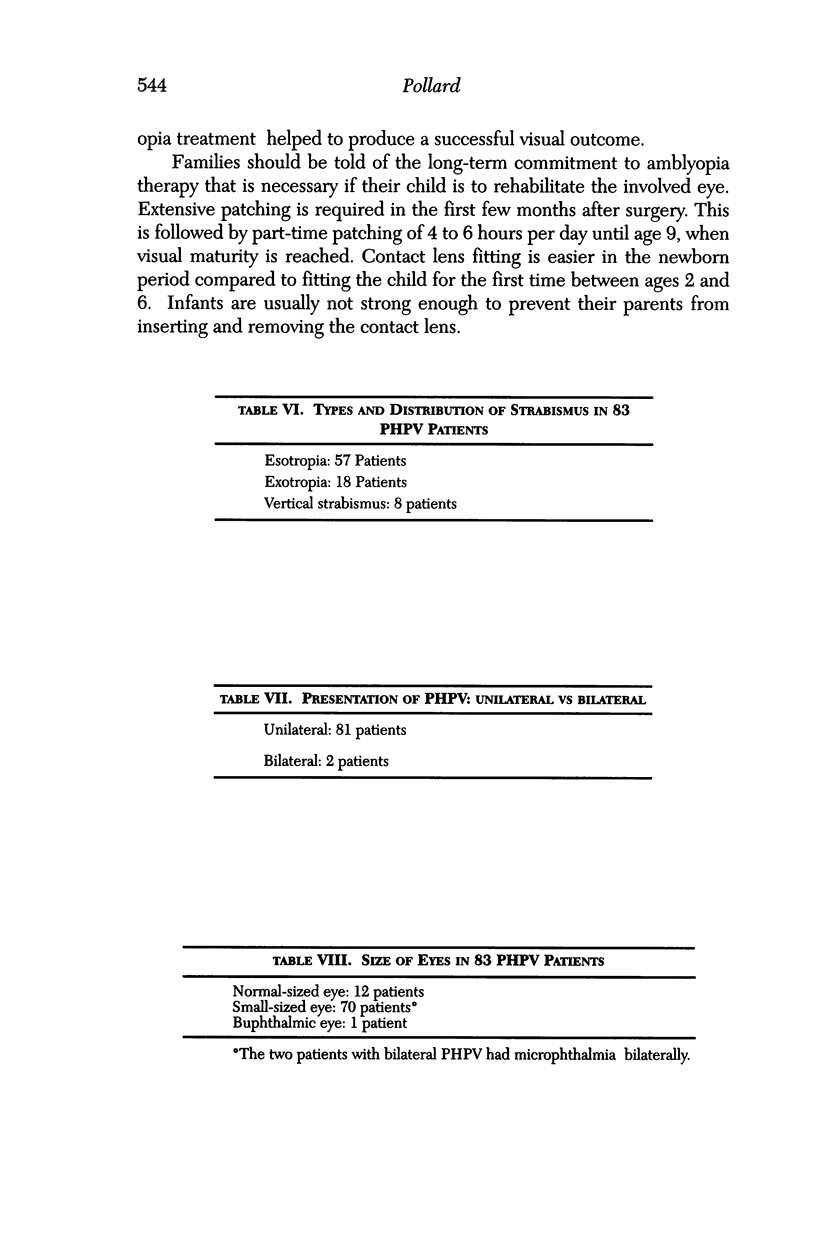
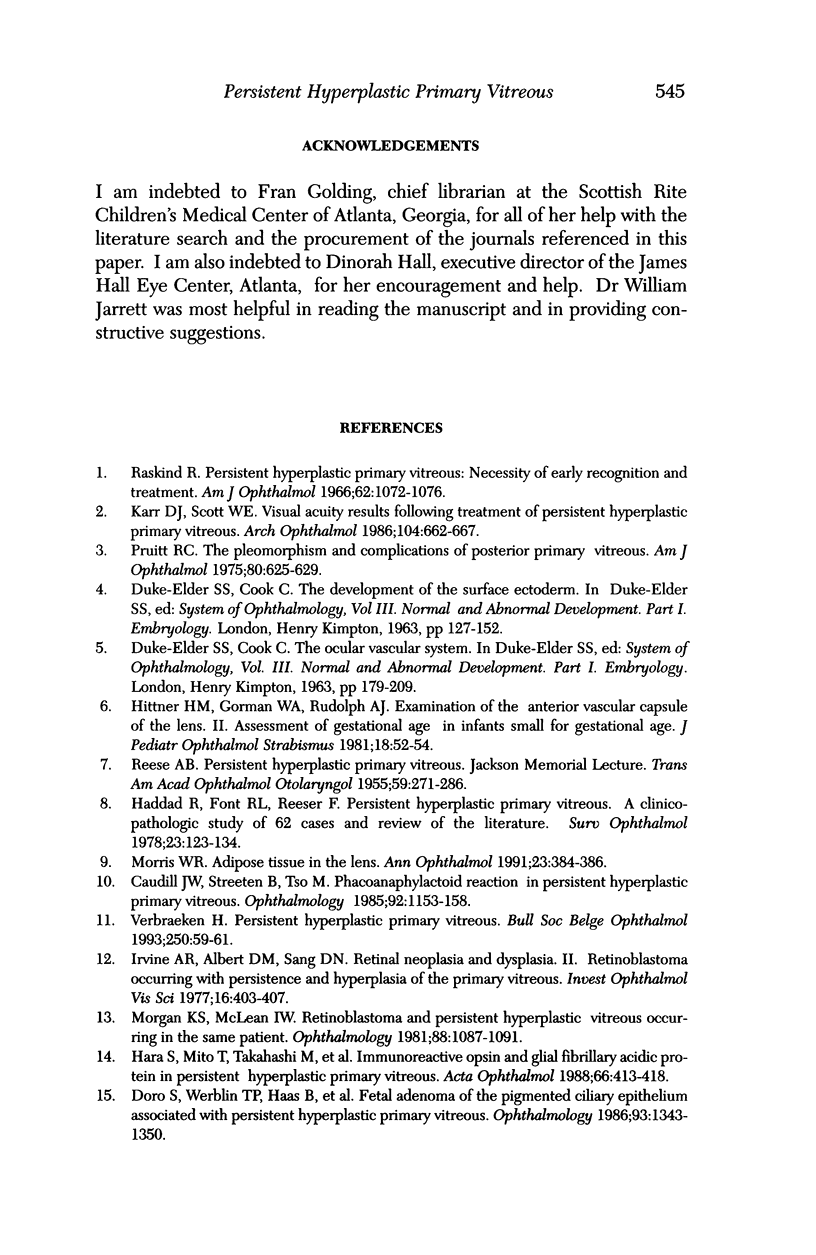
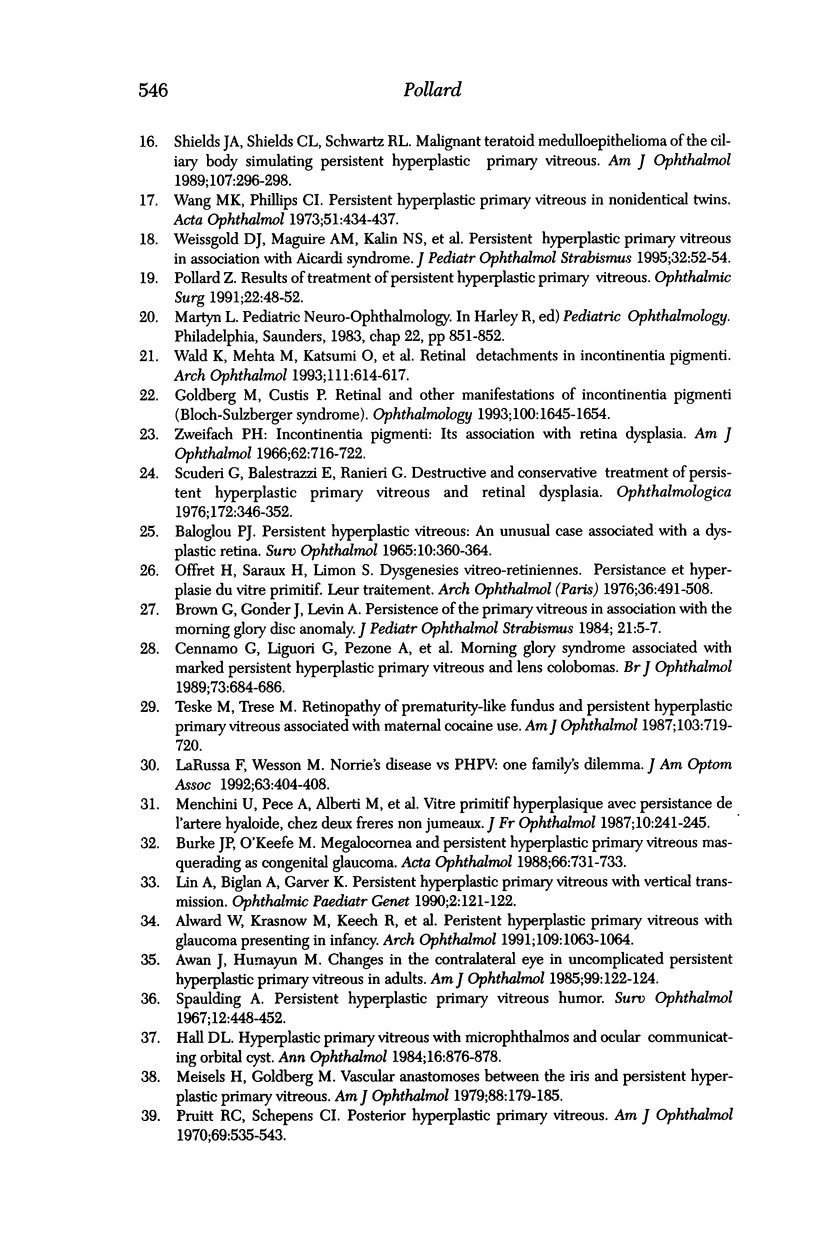
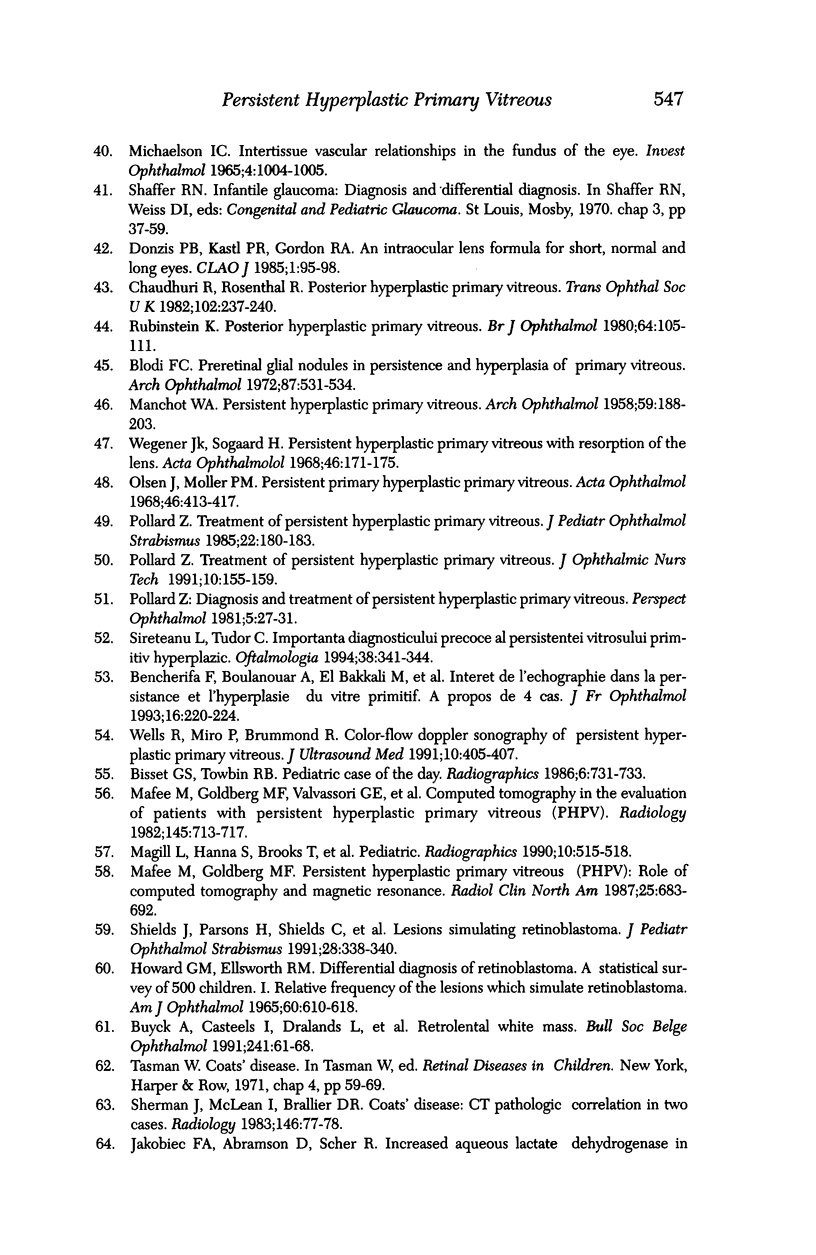
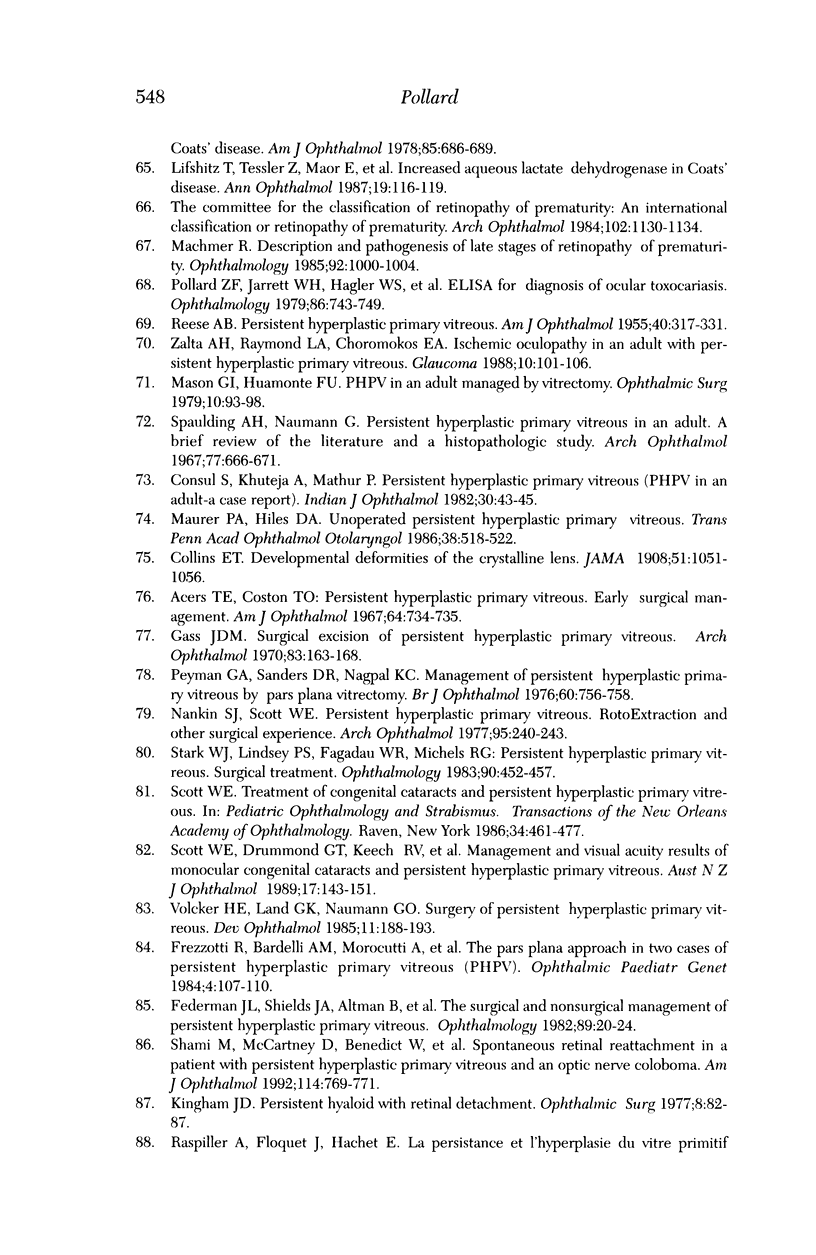
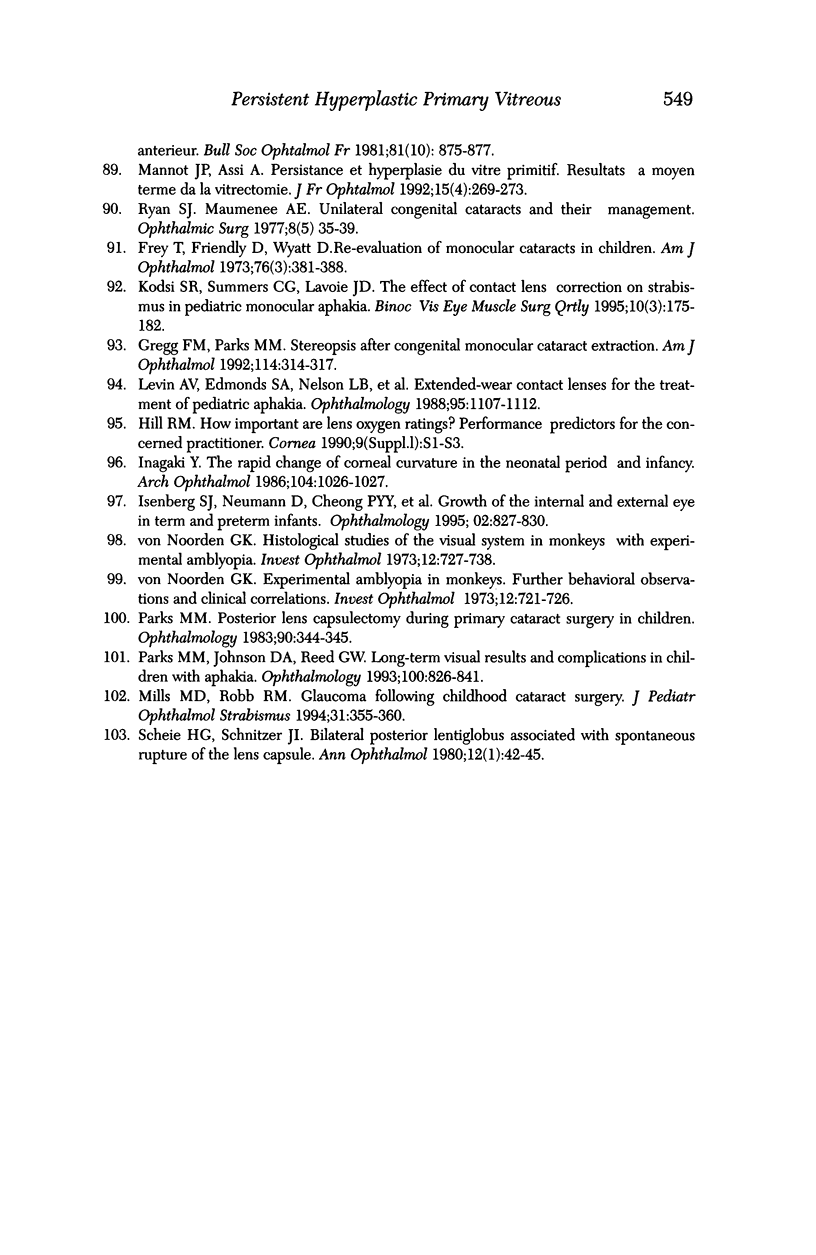
Images in this article
Selected References
These references are in PubMed. This may not be the complete list of references from this article.
- Acers T. E., Coston T. O. Persistent hyperplastic primary vitreous. Early surgical management. Am J Ophthalmol. 1967 Oct;64(4):734–735. doi: 10.1016/0002-9394(67)92857-7. [DOI] [PubMed] [Google Scholar]
- Alward W. L., Krasnow M. A., Keech R. V., Pulido J. S., Sutton G. L. Persistent hyperplastic primary vitreous with glaucoma presenting in infancy. Arch Ophthalmol. 1991 Aug;109(8):1063–1064. doi: 10.1001/archopht.1991.01080080021010. [DOI] [PubMed] [Google Scholar]
- Awan K. J., Humayun M. Changes in the contralateral eye in uncomplicated persistent hyperplastic primary vitreous in adults. Am J Ophthalmol. 1985 Feb 15;99(2):122–124. doi: 10.1016/0002-9394(85)90219-3. [DOI] [PubMed] [Google Scholar]
- Baloglou P. J. Persistent hyperplastic vitreous: an unusual case associated with a dysplastic retina. Surv Ophthalmol. 1965 Aug;10(4):360–364. [PubMed] [Google Scholar]
- Bencherifa F., Boulanouar A., el Bakkali M., Benzekri Y., Lamdouar-Bellakhdar N. Intérêt de l'échographie dans la persistance et l'hyperplasie du vitré primitif. A propos de 4 cas. J Fr Ophtalmol. 1993;16(4):220–224. [PubMed] [Google Scholar]
- Bisset G. S., Towbin R. B. Pediatric case of the day. Persistent hyperplastic primary vitreous. Radiographics. 1986 Jul;6(4):731–733. doi: 10.1148/radiographics.6.4.3685512. [DOI] [PubMed] [Google Scholar]
- Blodi F. C. Preretinal glial nodules in persistence and hyperplasia of primary vitreous. Arch Ophthalmol. 1972 May;87(5):531–534. doi: 10.1001/archopht.1972.01000020533007. [DOI] [PubMed] [Google Scholar]
- Brown G. C., Gonder J., Levin A. Persistence of the primary vitreous in association with the morning glory disc anomaly. J Pediatr Ophthalmol Strabismus. 1984 Jan-Feb;21(1):5–7. doi: 10.3928/0191-3913-19840101-03. [DOI] [PubMed] [Google Scholar]
- Burke J. P., O'Keefe M. Megalocornea and persistent hyperplastic primary vitreous masquerading as congenital glaucoma. Acta Ophthalmol (Copenh) 1988 Dec;66(6):731–733. doi: 10.1111/j.1755-3768.1988.tb04072.x. [DOI] [PubMed] [Google Scholar]
- Buyck A., Casteels I., Dralands L., Missotten L. Retrolental white mass. Bull Soc Belge Ophtalmol. 1991;241:61–68. [PubMed] [Google Scholar]
- Caudill J. W., Streeten B. W., Tso M. O. Phacoanaphylactoid reaction in persistent hyperplastic primary vitreous. Ophthalmology. 1985 Aug;92(8):1153–1158. doi: 10.1016/s0161-6420(85)33914-3. [DOI] [PubMed] [Google Scholar]
- Cennamo G., Liguori G., Pezone A., Iaccarino G. Morning glory syndrome associated with marked persistent hyperplastic primary vitreous and lens colobomas. Br J Ophthalmol. 1989 Aug;73(8):684–686. doi: 10.1136/bjo.73.8.684. [DOI] [PMC free article] [PubMed] [Google Scholar]
- Chaudhuri P. R., Rosenthal A. R. Posterior hyperplastic primary vitreous. Trans Ophthalmol Soc U K. 1982 Jul;102(Pt 2):237–240. [PubMed] [Google Scholar]
- Consul S., Khuteja A., Mathur P. Persistent hyperplastic primary vitreous (PHPV in an adult--a case report). Indian J Ophthalmol. 1982 Jan;30(1):43–45. [PubMed] [Google Scholar]
- Donzis P. B., Kastl P. R., Gordon R. A. An intraocular lens formula for short, normal and long eyes. CLAO J. 1985 Apr-Jun;11(2):95–98. [PubMed] [Google Scholar]
- Doro S., Werblin T. P., Haas B., Iwamoto T., Jakobiec F. A. Fetal adenoma of the pigmented ciliary epithelium associated with persistent hyperplastic primary vitreous. Ophthalmology. 1986 Oct;93(10):1343–1350. doi: 10.1016/s0161-6420(86)33568-1. [DOI] [PubMed] [Google Scholar]
- Federman J. L., Shields J. A., Altman B., Koller H. The surgical and nonsurgical management of persistent hyperplastic primary vitreous. Ophthalmology. 1982 Jan;89(1):20–24. doi: 10.1016/s0161-6420(82)34854-x. [DOI] [PubMed] [Google Scholar]
- Frey T., Friendly D., Wyatt D. Re-evaluation of monocular cataracts in children. Am J Ophthalmol. 1973 Sep;76(3):381–388. doi: 10.1016/0002-9394(73)90495-9. [DOI] [PubMed] [Google Scholar]
- Frezzotti R., Bardelli A. M., Morocutti A., Pannini S. The pars plana approach in two cases of persistent hyperplastic primary vitreous (PHPV). Ophthalmic Paediatr Genet. 1984 Aug;4(2):107–110. doi: 10.3109/13816818409007845. [DOI] [PubMed] [Google Scholar]
- Gass J. D. Surgical excision of persistent hyperplastic primary vitreous. Arch Ophthalmol. 1970 Feb;83(2):163–168. doi: 10.1001/archopht.1970.00990030165007. [DOI] [PubMed] [Google Scholar]
- Goldberg M. F., Custis P. H. Retinal and other manifestations of incontinentia pigmenti (Bloch-Sulzberger syndrome). Ophthalmology. 1993 Nov;100(11):1645–1654. doi: 10.1016/s0161-6420(93)31422-3. [DOI] [PubMed] [Google Scholar]
- Gregg F. M., Parks M. M. Stereopsis after congenital monocular cataract extraction. Am J Ophthalmol. 1992 Sep 15;114(3):314–317. doi: 10.1016/s0002-9394(14)71797-0. [DOI] [PubMed] [Google Scholar]
- Haddad R., Font R. L., Reeser F. Persistent hyperplastic primary vitreous. A clinicopathologic study of 62 cases and review of the literature. Surv Ophthalmol. 1978 Sep-Oct;23(2):123–134. doi: 10.1016/0039-6257(78)90091-7. [DOI] [PubMed] [Google Scholar]
- Hall D. L. Hyperplastic primary vitreous with microphthalmos and ocular communicating orbital cyst. Ann Ophthalmol. 1984 Sep;16(9):876–878. [PubMed] [Google Scholar]
- Hara S., Mito T., Takahashi M., Ohmura M., Mizuno K., Masuda T. Immunoreactive opsin and glial fibrillary acidic protein in persistent hyperplastic primary vitreous. Acta Ophthalmol (Copenh) 1988 Aug;66(4):413–418. doi: 10.1111/j.1755-3768.1988.tb04033.x. [DOI] [PubMed] [Google Scholar]
- Hill R. M. How important are lens oxygen ratings? Performance predictors for the concerned practitioner. Cornea. 1990;9 (Suppl 1):S1–S8. doi: 10.1097/00003226-199010001-00002. [DOI] [PubMed] [Google Scholar]
- Hittner H. M., Gorman W. A., Rudolph A. J. Examination of the anterior vascular capsule of the lens: II. Assessment of gestational age in infants small for gestational age. J Pediatr Ophthalmol Strabismus. 1981 Mar-Apr;18(2):52–54. doi: 10.3928/0191-3913-19810301-12. [DOI] [PubMed] [Google Scholar]
- Howard G. M., Ellsworth R. M. Differential diagnosis of retinoblastoma. A statistical survey of 500 children. I. Relative frequency of the lesions which simulate retinoblastoma. Am J Ophthalmol. 1965 Oct;60(4):610–618. [PubMed] [Google Scholar]
- Inagaki Y. The rapid change of corneal curvature in the neonatal period and infancy. Arch Ophthalmol. 1986 Jul;104(7):1026–1027. doi: 10.1001/archopht.1986.01050190084044. [DOI] [PubMed] [Google Scholar]
- Irvine A. R., Albert D. M., Sang D. N. Retinal neoplasia and dysplasia. II. Retinoblastoma occurring with persistence and hyperplasia of the primary vitreous. Invest Ophthalmol Vis Sci. 1977 May;16(5):403–407. [PubMed] [Google Scholar]
- Isenberg S. J., Neumann D., Cheong P. Y., Ling Y. L., McCall L. C., Ziffer A. J. Growth of the internal and external eye in term and preterm infants. Ophthalmology. 1995 May;102(5):827–830. doi: 10.1016/s0161-6420(95)30950-5. [DOI] [PubMed] [Google Scholar]
- Jakobiec F. A., Abramson D., Scher R. Increased aqueous lactate dehydrogenase in Coats' disease. Am J Ophthalmol. 1978 May;85(5 Pt 1):686–689. doi: 10.1016/s0002-9394(14)77106-5. [DOI] [PubMed] [Google Scholar]
- Karr D. J., Scott W. E. Visual acuity results following treatment of persistent hyperplastic primary vitreous. Arch Ophthalmol. 1986 May;104(5):662–667. doi: 10.1001/archopht.1986.01050170052020. [DOI] [PubMed] [Google Scholar]
- Kingham J. D. Persistent hyaloid with retinal detachment. Ophthalmic Surg. 1977 Feb;8(1):82–87. [PubMed] [Google Scholar]
- LaRussa F., Wesson M. D. Norrie's disease vs. PHPV: one family's dilemma. J Am Optom Assoc. 1992 Jun;63(6):404–408. [PubMed] [Google Scholar]
- Levin A. V., Edmonds S. A., Nelson L. B., Calhoun J. H., Harley R. D. Extended-wear contact lenses for the treatment of pediatric aphakia. Ophthalmology. 1988 Aug;95(8):1107–1113. doi: 10.1016/s0161-6420(88)33052-6. [DOI] [PubMed] [Google Scholar]
- Lifshitz T., Tessler Z., Maor E., Yassur Y. Increased aqueous lactic dehydrogenase in Coat's disease. Ann Ophthalmol. 1987 Mar;19(3):116–119. [PubMed] [Google Scholar]
- Lin A. E., Biglan A. W., Garver K. L. Persistent hyperplastic primary vitreous with vertical transmission. Ophthalmic Paediatr Genet. 1990 Jun;11(2):121–122. doi: 10.3109/13816819009012956. [DOI] [PubMed] [Google Scholar]
- MANSCHOT W. A. Persistent hyperplastic primary vitreous; special reference to preretinal glial tissue as a pathological characteristic and to the development of the primary vitreous. AMA Arch Ophthalmol. 1958 Feb;59(2):188–203. [PubMed] [Google Scholar]
- Machemer R. Description and pathogenesis of late stages of retinopathy of prematurity. Ophthalmology. 1985 Aug;92(8):1000–1004. doi: 10.1016/s0161-6420(85)33925-8. [DOI] [PubMed] [Google Scholar]
- Mafee M. F., Goldberg M. F. Persistent hyperplastic primary vitreous (PHPV): role of computed tomography and magnetic resonance. Radiol Clin North Am. 1987 Jul;25(4):683–692. [PubMed] [Google Scholar]
- Mafee M. F., Goldberg M. F., Valvassori G. E., Capek V. Computed tomography in the evaluation of patients with persistent hyperplastic primary vitreous (PHPV). Radiology. 1982 Dec;145(3):713–717. doi: 10.1148/radiology.145.3.7146401. [DOI] [PubMed] [Google Scholar]
- Magill H. L., Hanna S. L., Brooks M. T., Jenkins J. J., 3rd, Burton E. W., Boulden T. F., Seidel F. G. Case of the day. Pediatric. Persistent hyperplastic primary vitreous (PHPV). Radiographics. 1990 May;10(3):515–518. doi: 10.1148/radiographics.10.3.2343171. [DOI] [PubMed] [Google Scholar]
- Mason G. I., Huamonte F. U. PHPV in an adult managed by vitrectomy. Ophthalmic Surg. 1979 Mar;10(3):93–98. [PubMed] [Google Scholar]
- Maurer P. A., Hiles D. A. Unoperated persistent hyperplastic primary vitreous. Trans Pa Acad Ophthalmol Otolaryngol. 1986;38(2):518–522. [PubMed] [Google Scholar]
- Meisels H. I., Goldberg M. F. Vascular anastomoses between the iris and persistent hyperplastic primary vitreous. Am J Ophthalmol. 1979 Aug;88(2):179–185. doi: 10.1016/0002-9394(79)90463-x. [DOI] [PubMed] [Google Scholar]
- Menchini U., Pece A., Alberti M., Serini P., Brancato R. Vitré primitif hyperplasique avec persistance de l'artère hyaloïde, chez deux frères non jumeaux. J Fr Ophtalmol. 1987;10(3):241–245. [PubMed] [Google Scholar]
- Michaelson I. C. Intertissue vascular relationships in the fundus of the eye=. Invest Ophthalmol. 1965 Dec;4(6):1004–1015. [PubMed] [Google Scholar]
- Mills M. D., Robb R. M. Glaucoma following childhood cataract surgery. J Pediatr Ophthalmol Strabismus. 1994 Nov-Dec;31(6):355–361. doi: 10.3928/0191-3913-19941101-03. [DOI] [PubMed] [Google Scholar]
- Monnot J. P., Assi A. Persistance et hyperplasie du vitré primitif. Résultats à moyen terme de la vitrectomie. J Fr Ophtalmol. 1992;15(4):269–273. [PubMed] [Google Scholar]
- Morgan K. S., McLean I. W. Retinoblastoma and persistent hyperplastic vitreous occurring in the same patient. Ophthalmology. 1981 Oct;88(10):1087–1089. doi: 10.1016/s0161-6420(81)80040-1. [DOI] [PubMed] [Google Scholar]
- Morris W. R. Adipose tissue in the lens. Ann Ophthalmol. 1991 Oct;23(10):384–386. [PubMed] [Google Scholar]
- Nankin S. J., Scott W. E. Persistent hyperplastic primary vitreous: roto-extraction and other surgical experience. Arch Ophthalmol. 1977 Feb;95(2):240–243. doi: 10.1001/archopht.1977.04450020041007. [DOI] [PubMed] [Google Scholar]
- Offret H., Saraux H., Limon S. Dysgénésies vitréo-rétiniennes. Persistance et hyperplasie du vitré primitif. Leur traitement. Arch Ophtalmol (Paris) 1976 Jun-Jul;36(6-7):491–508. [PubMed] [Google Scholar]
- Olsen J., Moller P. M. Persistent primary hyperplastic vitreous. Acta Ophthalmol (Copenh) 1968;46(3):413–417. doi: 10.1111/j.1755-3768.1968.tb02824.x. [DOI] [PubMed] [Google Scholar]
- Parks M. M., Johnson D. A., Reed G. W. Long-term visual results and complications in children with aphakia. A function of cataract type. Ophthalmology. 1993 Jun;100(6):826–841. doi: 10.1016/s0161-6420(93)31566-6. [DOI] [PubMed] [Google Scholar]
- Parks M. M. Posterior lens capsulectomy during primary cataract surgery in children. Ophthalmology. 1983 Apr;90(4):344–345. doi: 10.1016/s0161-6420(83)34549-8. [DOI] [PubMed] [Google Scholar]
- Peyman G. A., Sanders D. R., Nagpal K. C. Management of persistent hyperplastic primary vitreous by pars plana vitrectomy. Br J Ophthalmol. 1976 Nov;60(11):756–758. doi: 10.1136/bjo.60.11.756. [DOI] [PMC free article] [PubMed] [Google Scholar]
- Pollard Z. F., Jarrett W. H., Hagler W. S., Allain D. S., Schantz P. M. ELISA for diagnosis of ocular toxocariasis. Ophthalmology. 1979 May;86(5):743–752. doi: 10.1016/s0161-6420(79)35465-3. [DOI] [PubMed] [Google Scholar]
- Pollard Z. F. Results of treatment of persistent hyperplastic primary vitreous. Ophthalmic Surg. 1991 Jan;22(1):48–52. [PubMed] [Google Scholar]
- Pollard Z. F. Treatment of persistent hyperplastic primary vitreous. J Ophthalmic Nurs Technol. 1991 Jul-Aug;10(4):155–159. [PubMed] [Google Scholar]
- Pollard Z. F. Treatment of persistent hyperplastic primary vitreous. J Pediatr Ophthalmol Strabismus. 1985 Sep-Oct;22(5):180–183. doi: 10.3928/0191-3913-19850901-05. [DOI] [PubMed] [Google Scholar]
- Pruett R. C., Schepens C. L. Posterior hyperplastic primary vitreous. Am J Ophthalmol. 1970 Apr;69(4):534–543. [PubMed] [Google Scholar]
- Pruett R. C. The pleomorphism and complications of posterior hyperplastic primary vitreous. Am J Ophthalmol. 1975 Oct;80(4):625–629. doi: 10.1016/0002-9394(75)90392-x. [DOI] [PubMed] [Google Scholar]
- REESE A. B. Persistent hyperplastic primary vitreous. Am J Ophthalmol. 1955 Sep;40(3):317–331. doi: 10.1016/0002-9394(55)91866-3. [DOI] [PubMed] [Google Scholar]
- REESE A. B. Persistent hyperplastic primary vitreous. Trans Am Acad Ophthalmol Otolaryngol. 1955 May-Jun;59(3):271–295. [PubMed] [Google Scholar]
- Raskind R. H. Persistent hyperplastic primary vitreous. Necessity of early recognition and treatment. Am J Ophthalmol. 1966 Dec;62(6):1072–1076. doi: 10.1016/0002-9394(66)92556-6. [DOI] [PubMed] [Google Scholar]
- Raspiller A., Floquet J., Hachet E. La persistance et l'hyperplasia du vitré primitif antérieur. Bull Soc Ophtalmol Fr. 1981 Oct;81(10):875–877. [PubMed] [Google Scholar]
- Rubinstein K. Posterior hyperplastic primary vitreous. Br J Ophthalmol. 1980 Feb;64(2):105–111. doi: 10.1136/bjo.64.2.105. [DOI] [PMC free article] [PubMed] [Google Scholar]
- Ryan S. J., Maumenee A. E. Unilateral congenital cataracts and their management. Ophthalmic Surg. 1977 Oct;8(5):35–39. [PubMed] [Google Scholar]
- Scott W. E., Drummond G. T., Keech R. V., Karr D. J. Management and visual acuity results of monocular congenital cataracts and persistent hyperplastic primary vitreous. Aust N Z J Ophthalmol. 1989 May;17(2):143–152. doi: 10.1111/j.1442-9071.1989.tb00504.x. [DOI] [PubMed] [Google Scholar]
- Scott W. E. Treatment of congenital cataracts and persistent hyperplastic primary vitreous. Trans New Orleans Acad Ophthalmol. 1986;34:461–477. [PubMed] [Google Scholar]
- Scuderi G., Balestrazzi E., Ranieri G. Destructive and conservative treatment of persistent hyperplastic primary vitreous and retinal dysplasia. Ophthalmologica. 1976;172(4):346–352. doi: 10.1159/000307733. [DOI] [PubMed] [Google Scholar]
- Shami M., McCartney D., Benedict W., Barnes C. Spontaneous retinal reattachment in a patient with persistent hyperplastic primary vitreous and an optic nerve coloboma. Am J Ophthalmol. 1992 Dec 15;114(6):769–771. doi: 10.1016/s0002-9394(14)74061-9. [DOI] [PubMed] [Google Scholar]
- Sherman J. L., McLean I. W., Brallier D. R. Coats' disease: CT-pathologic correlation in two cases. Radiology. 1983 Jan;146(1):77–78. doi: 10.1148/radiology.146.1.6849070. [DOI] [PubMed] [Google Scholar]
- Shields J. A., Parsons H. M., Shields C. L., Shah P. Lesions simulating retinoblastoma. J Pediatr Ophthalmol Strabismus. 1991 Nov-Dec;28(6):338–340. doi: 10.3928/0191-3913-19911101-12. [DOI] [PubMed] [Google Scholar]
- Shields J. A., Shields C. L., Schwartz R. L. Malignant teratoid medulloepithelioma of the ciliary body simulating persistent hyperplastic primary vitreous. Am J Ophthalmol. 1989 Mar 15;107(3):296–298. doi: 10.1016/0002-9394(89)90318-8. [DOI] [PubMed] [Google Scholar]
- Sireteanu L., Tudor C. Importanţa diagnosticului precoce al persistenţei vitrosului primitiv hiperplazic. Oftalmologia. 1994 Oct-Dec;38(4):341–344. [PubMed] [Google Scholar]
- Spaulding A. G., Naumann G. Persistent hyperplastic primary vitreous in an adult. A brief review of the literature and a histopathologic study. Arch Ophthalmol. 1967 May;77(5):666–671. doi: 10.1001/archopht.1967.00980020668019. [DOI] [PubMed] [Google Scholar]
- Spaulding A. G. Persistent hyperplastic primary vitreous humor; a finding in a 71-year-old man. Surv Ophthalmol. 1967 Oct;12(5):448–452. [PubMed] [Google Scholar]
- Stark W. J., Lindsey P. S., Fagadau W. R., Michels R. G. Persistent hyperplastic primary vitreous. Surgical treatment. Ophthalmology. 1983 May;90(5):452–457. doi: 10.1016/s0161-6420(83)34531-0. [DOI] [PubMed] [Google Scholar]
- Teske M. P., Trese M. T. Retinopathy of prematurity-like fundus and persistent hyperplastic primary vitreous associated with maternal cocaine use. Am J Ophthalmol. 1987 May 15;103(5):719–720. doi: 10.1016/s0002-9394(14)74343-0. [DOI] [PubMed] [Google Scholar]
- Verbraeken H. Persistent hyperplastic primary vitreous. Bull Soc Belge Ophtalmol. 1993;250:59–61. [PubMed] [Google Scholar]
- Völcker H. E., Lang G. K., Naumann G. O. Surgery of persistent hyperplastic primary vitreous. Dev Ophthalmol. 1985;11:188–193. doi: 10.1159/000411116. [DOI] [PubMed] [Google Scholar]
- Wald K. J., Mehta M. C., Katsumi O., Sabates N. R., Hirose T. Retinal detachments in incontinentia pigmenti. Arch Ophthalmol. 1993 May;111(5):614–617. doi: 10.1001/archopht.1993.01090050048026. [DOI] [PubMed] [Google Scholar]
- Wang M. K., Phillips C. I. Persistent hyperplastic primary vitreous in non-identical twins. Acta Ophthalmol (Copenh) 1973;51(4):434–437. doi: 10.1111/j.1755-3768.1973.tb06022.x. [DOI] [PubMed] [Google Scholar]
- Wegener J. K., Sogaard H. Persistent hyperplastic primary vitreous with resorption of the lens. Acta Ophthalmol (Copenh) 1968;46(2):171–175. doi: 10.1111/j.1755-3768.1968.tb05173.x. [DOI] [PubMed] [Google Scholar]
- Weissgold D. J., Maguire A. M., Kalin N. S., Hertle R. W. Persistent hyperplastic primary vitreous in association with Aicardi syndrome. J Pediatr Ophthalmol Strabismus. 1995 Jan-Feb;32(1):52–54. doi: 10.3928/0191-3913-19950101-12. [DOI] [PubMed] [Google Scholar]
- Wells R. G., Miro P., Brummond R. Color-flow Doppler sonography of persistent hyperplastic primary vitreous. J Ultrasound Med. 1991 Jul;10(7):405–407. doi: 10.7863/jum.1991.10.7.405. [DOI] [PubMed] [Google Scholar]
- Zweifach P. H. Incontinentia pigmenti: its association with retinal dysplasia. Am J Ophthalmol. 1966 Oct;62(4):716–722. doi: 10.1016/0002-9394(66)92201-x. [DOI] [PubMed] [Google Scholar]
- von Noorden G. K. Experimental amblyopia in monkeys. Further behavioral observations and clinical correlations. Invest Ophthalmol. 1973 Oct;12(10):721–726. [PubMed] [Google Scholar]
- von Noorden G. K. Histological studies of the visual system in monkeys with experimental amblyopia. Invest Ophthalmol. 1973 Oct;12(10):727–738. [PubMed] [Google Scholar]




